

Bosnia & Herzegovina Travel Guide
Last Updated: August 17, 2023
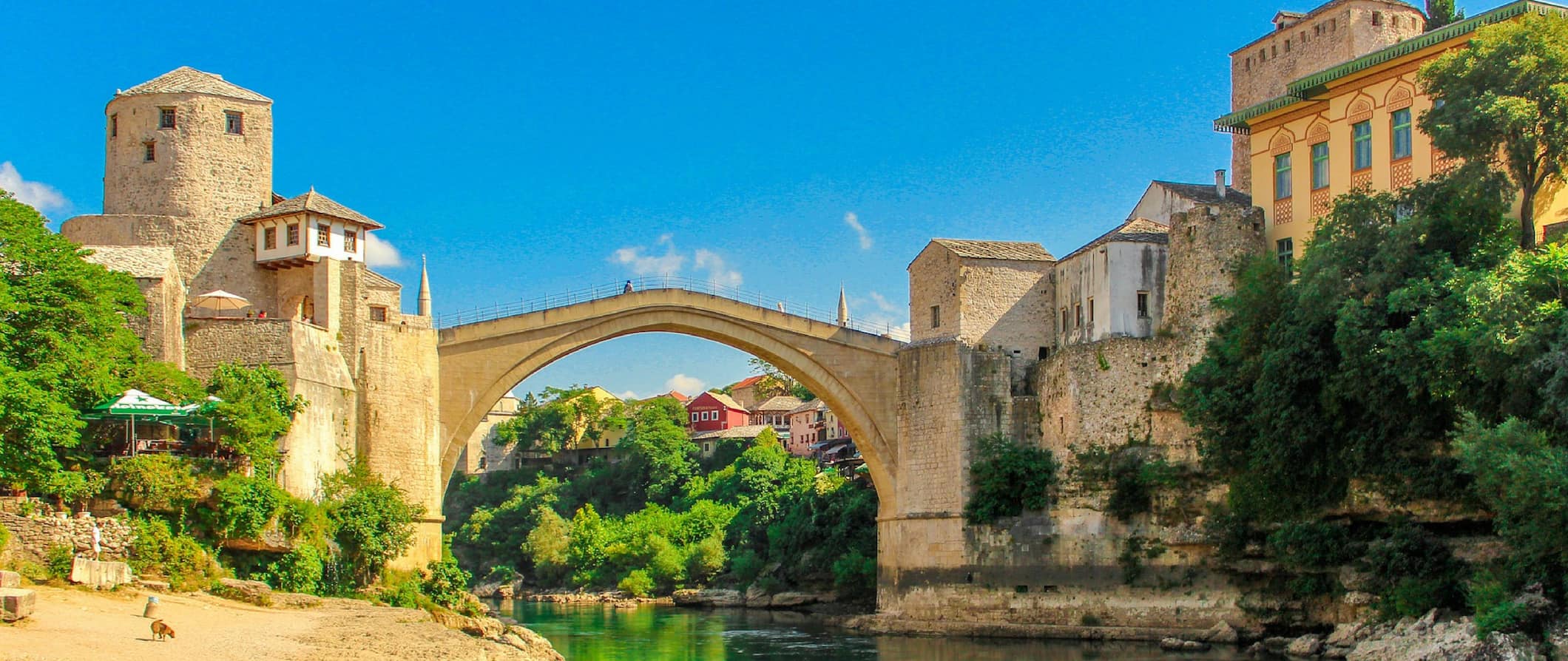
Often overlooked because the country’s name is still synonymous with the Yugoslavian War of the 1990s, Bosnia & Herzegovina deserves your attention. It’s one of the most underrated destinations in Europe .
Not a lot of people backpack or travel through the country but it is rich in history, culture, and natural beauty.
Three major religions (Islam, Roman Catholic, and Serbian Orthodox) all come together in this small area to form a vibrant blend of cultures. You’ll hear the Muslim call to prayer over the minarets one minute, and church bells ringing from a nearby church the next.
Watch skilled divers jump from the iconic bridge in Mostar, enjoy some hookah at one of Sarajevo’s sidewalk cafes, take a dip in the turquoise pools below the cascading Kravica Falls, or raft down the Tara Canyon, the deepest canyon in Europe.
The country (especially the capital) has become more popular in recent years thanks to increasing tourism in the region and cheaper prices but you can still catch it before the big crowds come!
This travel guide to Bosnia & Herzegovina will help you plan your trip, save money, and make the most of your time in this off-the-beaten-path destination!
Table of Contents
- Things to See and Do
- Typical Costs
- Suggested Budget
- Money-Saving Tips
- Where to Stay
- How to Get Around
- How to Stay Safe
- Best Places to Book Your Trip
- Related Blogs on Bosnia & Herzegovina
Top 5 Things to See and Do in Bosnia & Herzegovina

1. See Sarajevo
Bosnia’s capital has a distinct “east meets west” vibe. Perched alongside the Miljacka River and surrounded by mountains, the city is both scenic and historic. It is well-known for its cultural diversity and is sometimes referred to as the Jerusalem of Europe; within the city you can sometimes find a mosque, a catholic church, and a synagogue all within a few blocks. Wander the colorful Bascarsija Square for excellent people-watching, and while you’re there visit the iconic Sebilj Fountain. This Ottoman-style wooden fountain was originally built in 1753 and relocated in 1891. Local legend claims that if you drink from the fountain, you will always return to Sarajevo. Enjoy some hookah, take the cable car to the top of Mount Trebevic for incredible views, and visit the Bašcaršija historic market for some snacks and more people-watching.
2. Check out Mostar
Mostar is a medieval city best known for its 16th-century bridge, which is a UNESCO World Heritage Site, straddling the Neretva river. The bridge is constructed in the Ottoman style, and on warm days you will often spot locals jumping off into the river. Mostar’s name comes from the word mostari , which translates to bridge keeper (the original bridge was crucial to an important trade route). Strolling through Mostar is like traveling back in time, with its picturesque cobblestone streets and incredible architecture. Explore this historic town and see the ancient Ottoman homes and panoramic views from the local mosque. It’s one of the best cities in the country.
3. Visit the Pliva Lakes
The Pliva Lakes are two emerald lakes surrounded by wooded mountains, just outside Jajce. The area is home to the famous Pliva watermills, unique wooden watermills that were traditionally used to grind wheat. With rivers, waterfalls, and easy bike paths, outdoor lovers flock here to swim, paddle, bike, and explore. Surrounded by amenities like picnic tables, fire pits, kayak rentals, cafes, and playgrounds, the lakes are an ideal place to enjoy a day surrounded by nature. The lakes are formed from the widening Pliva River, which joins the Vrbas River and empties over the 22-meter (72-foot) Pliva Waterfall. For something unique, plan your visit to the annual waterfall jumping competition held here each August.
4. Marvel at the Kravica Waterfall
These marvelous cascades drop 25 meters (82 feet) into a bright emerald pool. During the springtime, the forests surrounding the pool and waterfall blossom into lush greenery, giving the area an oasis-like appearance. You can spend the day splashing in the swimming hole and swinging from the rope swing. Afterward, there’s a little café next to the water where you can grab a snack or a cold beer. Admission is 20 BAM, and swimming is allowed. To see the falls as part of a day trip from Mostar or Dubrovnik costs around 70 BAM.
5. Explore Trebinje
Other things to see and do in bosnia & herzegovina, 1. ostrožac fortress.
This Gothic castle in the Una Valley is one of Bosnia’s most photogenic landmarks thanks to its brick torrents and stone wall running along the valley’s edge. Ostrožac has plenty to explore within its grounds, including a sculpture garden, ramparts, towers, and a manor house dating back to 1286. You can only visit the castle during the summer. Admission is 4 BAM.
2. Walk the Tunnel of Hope
Surrounded by Bosnian-Serb forces, Sarajevo had just one link with the outside world from 1992–1995: an 800-meter long (2,624-feet), 1-meter (3-feet) wide, 1.6-meter (5-feet) high tunnel connecting two houses on opposite sides of the airport runway. Eventually, the tunnel was equipped with rails to transport food and supplies. You can walk through part of the tunnel from the house at the western entrance while learning about the story of the siege through informational displays and videos. It’s an incredibly moving experience. The tunnel is open 9am-5pm daily and admission is 10 BAM.
3. Visit the National Museum of Bosnia & Herzegovina
The National Museum of Bosnia & Herzegovina in Sarajevo houses the Sarajevo Haggadah (a Jewish text) illuminated manuscript, which contains the illustrated text of the Passover Haggadah that goes with the Passover Seder. It’s one of the oldest Haggadah in the world, dating from 1350 and originating in Barcelona. In addition to Greek pottery and Roman mosaics, this museum is also home to a collection of stecci (medieval tombstones found scattered around the country). They started appearing in the 12th century for various Christian churches like the Bosnian Church, and most of them are inscribed with the extinct Bosnian Cyrillic alphabet. The entrance to the museum is 8 BAM.
4. See the Mehmed Pasha Sokolovic Bridge
Mehmed Pasha Sokolovic Bridge was built in Višegrad in 1571 and was designed by Mimar Sinan, the famous chief architect for the Ottoman Empire. He was the master builder behind both the Sehzade Mosque and the Süleymaniye Mosque in Istanbul, and this 11-arch bridge is the only confirmed work he completed in Bosnia & Herzegovina. It stretches 179 meters (587 feet) across the Drina River, and although it’s now closed to traffic, you can still appreciate its perfectly symmetrical beauty from the land.
5. See the watermills of Jajce
Jajce is known as the “city of falling water” thanks to its giant waterfall that connects the rivers Pliva and Vrbas. During the days of the Austro-Hungarian Empire (1867-1918), the small wooden huts stood on stilts over the gushing water used to ground local farmers’ wheat into flour. You can’t go inside, but you can see the huts up close as you explore.
6. Take a tour of Tito’s Bunker
On the bank of the river Neretva, just outside of Konjic and hidden behind a seemingly normal house, the once-forgotten bunker was built under the command of the Yugoslav revolutionary Josip Tito. It was kept secret for many years — even the construction workers were blindfolded until they arrived on site. The bunker cost billions of dollars to build and is now home to a contemporary art biennial called D-0 ARK Underground. You can only visit as a part of a guided tour with Visit Konjic, which costs 22 BAM.
7. See the Bosnian Pyramids
Located near Visoko, the Bosnian Pyramids are a set of four pyramids dating back 12,000 years ago that have perfect cardinal alignment, some reaching heights of 220 meters (721 feet). While most of the scientific community has debunked the theory that an ancient civilization built these structures, it’s a pretty amazing coincidence that they’re so aligned with the north. There are no official tours, so you’re free to explore on your own.
8. Visit Galerija 11/07/95
One of the most tragic events of the Yugoslavian War was the Srebrenica massacre, the largest genocide since World War II carried out by Bosnian Serb forces. With 8,372 victims, the gallery stands as a memorial to those that lost their life while also sharing survivor stories. It’s a powerful exhibition made up of photography, video footage, and audio testimonies. Admission is 12 BAM. An audio guide costs 3 BAM and a tour is 4 BAM.
9. Go whitewater rafting
Whitewater rafting on the Tara River Canyon, the deepest canyon in Europe, is one of the most exciting things to do in the country as you tackle rapids and fast-flowing water. Other than navigating 25 kilometers (15 miles) of white water, your guide will take you to waterfalls, springs, and swimming holes. I recommend Rafting Center Drina Tara. Their full-day tour costs 140 BAM and ends with a delicious traditional dinner of homemade goat pies, soup, grilled lamb, and drinks.
Bosnia & Herzegovina Travel Costs
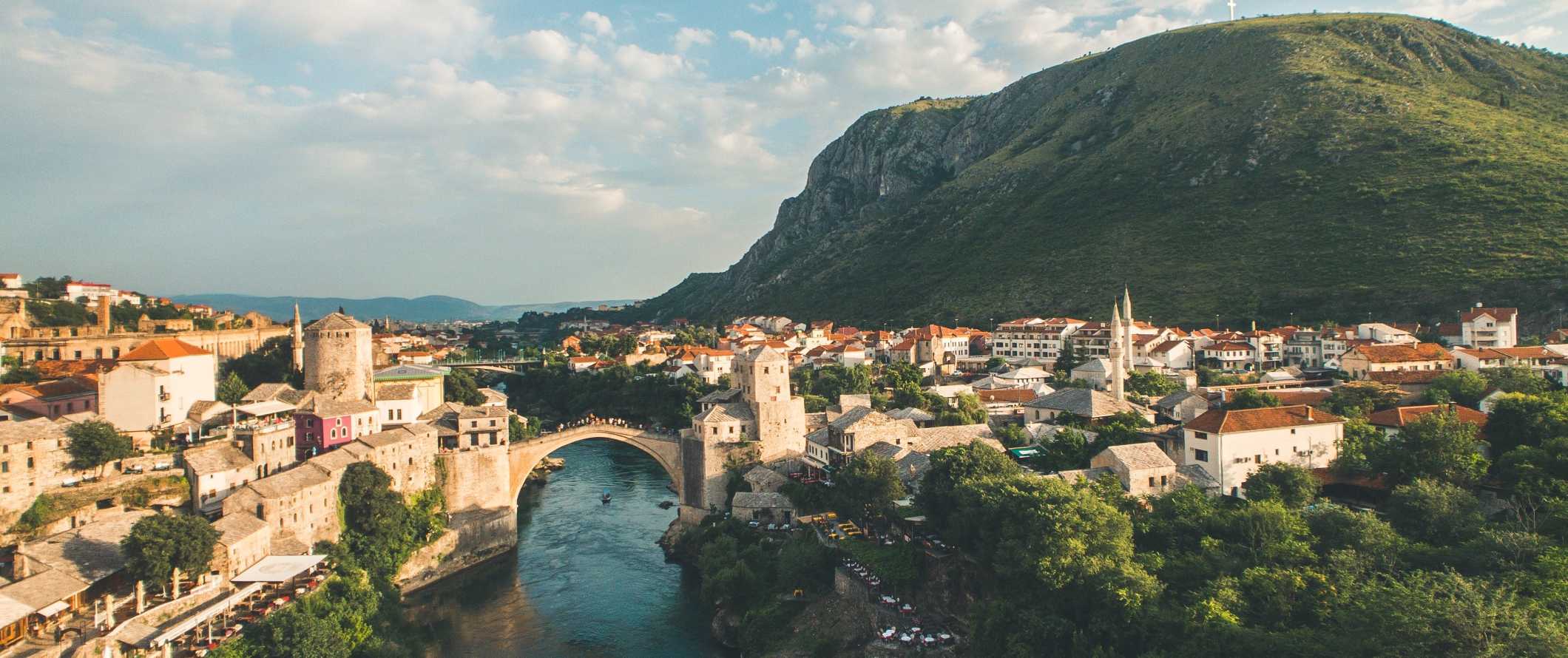
Accommodation – Hostel dorms start at around 19 BAM per night for an 8-10-bed dorm while a bed in a 4-6 person dorm costs closer to 28 BAM. For a private room, expect to pay at least 45-63 BAM per night for a twin.
Budget hotels in bigger cities (like Mostar and Sarajevo) cost around 63 BAM per night for a double or twin. In the more rural areas, you’ll find rooms for as low as 35 BAM.
Airbnb is another affordable option, with private rooms starting around 30 BAM per night while a full home or apartment costs at least 40 BAM (though prices average double that or more).
For anyone traveling with a tent, wild camping on public land is legal in Bosnia & Herzegovina. Additionally, there are campsites available throughout the country. Tent plots cost about 10.50 BAM per person.
Food – Traditional food in Bosnia & Herzegovina is very cheap and filling (and meat-heavy). Beef and lamb are popular staples, and influences from the Middle East and the Mediterranean are common. Sarma (meat and rice in pickled cabbage leaves), cevapi (a pita filled with cream and sausage), and burek (a flaky pastry with meat, cheese, and spinach) are some of the popular traditional choices. Common ingredients include potatoes, tomatoes, onions, garlic, cabbage, and plums.
You can get plates of cevapi or burek for about 7 BAM. A meal at a mid-range restaurant costs about 15 BAM and you can expect to pay about 3 BAM for a beer. Dinner at a fancy restaurant (including Western restaurants) costs about 35 BAM for an appetizer, main, and dessert.
For comparison, fast food like McDonald’s is about 9 BAM for a combo meal.
If you are planning to cook your own food, a week’s worth of groceries costs around 45-65 BAM. This gets you basic staples like rice, seasonal produce, and some meat.
Backpacking Bosnia & Herzegovina Suggested Budgets
If you are backpacking in Bosnia & Herzegovina, my suggested budget is 85 BAM per day. This assumes you’re staying in a hostel dorm, cooking your meals, sticking to mostly free activities (like free walking tours and hiking), and using public transportation to get around.
A mid-range budget of about 160 BAM covers staying in an Airbnb, eating out for all your meals at cheap local places, enjoying a few drinks, taking the occasional taxi, and doing more paid activities like museum visits or rafting.
On a “luxury” budget of 275 BAM per day or more, you will stay in a hotel, eat out for all your meals, enjoy lots of drinks, take more taxis or rent a car, and do all the tours you desire. This is just the ground floor for luxury though. The sky is the limit!
You can use the chart below to get some idea of how much you need to budget daily, depending on your travel style. Keep in mind these are daily averages — some days you’ll spend more, some days you’ll spend less (you might spend less every day). We just want to give you a general idea of how to make your budget. Prices are in BAM.
Bosnia & Herzegovina Travel Guide: Money-Saving Tips
Bosnia & Herzegovina, like most of the region, is very budget-friendly. You’ll be able to eat, drink, and stay in comfortable accommodations without breaking the bank too much. However, I always love saving money when I can so here are some tips to help you save money when you visit:
- Do a free walking tour – Both Sarajevo and Mostar have free walking tours available. They’re a great way to get familiar with the city and the culture. Just be sure to tip your guide at the end!
- Wild camp – If you really want to save money in Bosnia & Herzegovina, bring your tent. You can pitch your tent on public land throughout Bosnia & Herzegovina.
- Cook your own meals – Many hostels here include kitchen facilities, so if you want to save money, cook your own meals. It’s not glamorous but it’s cheap!
- Stay with a local – Staying with a local via Couchsurfing is a great way to not only save money but to meet a knowledgeable local. Just make sure to send your requests early as there are not a ton of hosts here.
- Walk everywhere – All of the major cities in Bosnia & Herzegovina are walkable, so skip the public transportation if you want to save a few extra dollars.
- Enjoy the free spaces – There are plenty of free parks as well as many free hiking trails around the country. Save your budget and enjoy the outdoors!
- Drink the tap water – Tap water within the cities is safe to drink, but not in the rural areas. Pick up a LifeStraw (a water bottle with a purifier) so you can cut down on your use of plastic bottles while saving money in the process.
Where to Stay in Bosnia & Herzegovina
Like many other countries in this part of Europe, Bosnia & Herzegovina only has hostel accommodation in the cities. In the smaller less popular areas, you will find B&B style accommodation or campsites. Here are some of my favorite places to stay in Bosnia & Herzegovina:
- Hostel Kucha (Sarajevo)
- Balkan Han Hostel (Sarajevo)
- Hostel Franz Ferdinand (Sarajevo)
- Villa Cardak (Mostar)
- Rooms Goa Mostar (Mostar)
- The Red Door Hostel Trebinje (Trebinje)
How to Get Around Bosnia & Herzegovina
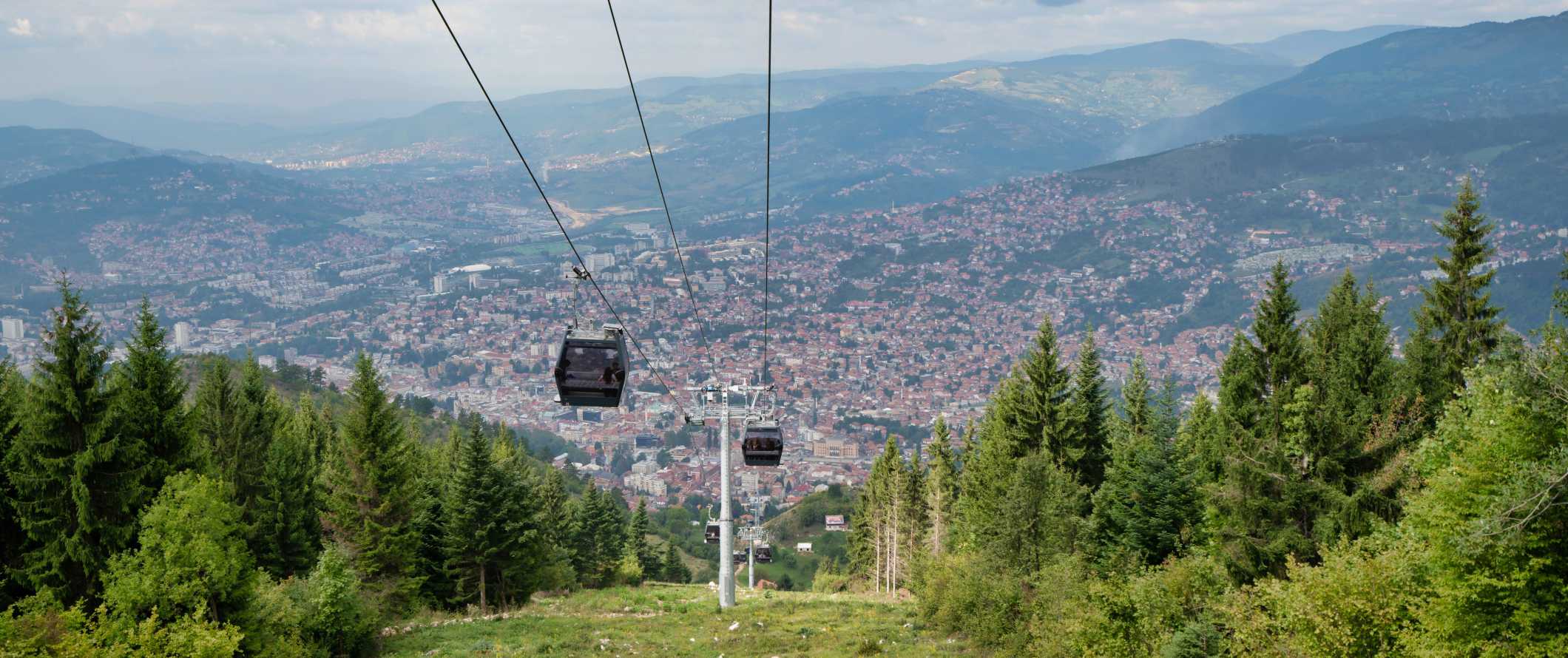
Public transportation – Most towns in Bosnia & Herzegovina are walkable. While public transportation prices vary by city, you can expect to pay around 2 BAM for a one-way ticket on buses, trams, or trolleybuses.
Taxi – If you need to take a taxi, prices start at about 3 BAM and cost about 1.60 BAM for every additional kilometer. While affordable, they do add up so skip them if you can.
Bus – There is an extensive network of long-distance intercity and international buses. Between towns, it’s normally easy enough to wave down any bus. Reservations are sometimes necessary for overnight routes or at peak holiday times but not during the day. The biggest companies include:
- Centrotrans
A bus from Sarajevo to Mostar takes 2.5 hours and costs around 11 BAM, while Sarajevo to Trebinje takes nearly 10 hours and is about 40 BAM. Mostar to Jajce is a 4.5-hour journey and costs about 27 BAM. Try to book a day in advance when possible as seats do fill up quickly in the summer season.
It is worth noting that if you buy a round trip with the same company, you can save yourself up to 60% compared to buying two single tickets. Also, if you need to put luggage in the hold, companies will often charge you an additional 2-4 BAM. (It’s common in this region to charge for the luggage hold.)
Train – Trains do operate in Bosnia & Herzegovina, however, they are outdated and extremely slow. I do not recommend using them. Take the bus instead.
Flying – No budget airlines offer domestic flights within Bosnia & Herzegovina.
Car rental – Car rentals can be found for around 40 BAM per day for a multi-day rental. Renters must be at least 21 years old and have an International Driving Permit (IDP). For the best car rental prices, use Discover Cars .
When to Go to Bosnia & Herzegovina
In general, May through to October is the best time to visit Bosnia & Herzegovina as these are the warmest months. The temperature hovers around 31°C (87°F) and rarely drops below 17°C (62°F).
Even in the summer months, Bosnia & Herzegovina doesn’t get a ton of tourism traffic. A lot of people will take a day trip to Mostar from Croatia, but you don’t have to worry too much about overcrowding in the rest of the country.
Unlike other Mediterranean countries, Bosnia & Herzegovina doesn’t have a whole lot of coastal areas to enjoy. If you’re here mostly for hiking or sightseeing, the cooler spring/fall temperatures might suit you better.
Winters here can be harsh and they often last from November to March. Temperatures often drop below freezing, and snowfall is common. I’d skip a winter visit.
How to Stay Safe in Bosnia & Herzegovina
In Bosnia & Herzegovina, violent crime against tourists is rare. However, scams and pick-pocketing are common, usually on public transport and in the cities and especially around high-traffic areas in Sarajevo. Always keep an eye on your stuff and only take the cash you need for the day. You can read about common travel scams to avoid here.
If you want to go hiking, it’s essential you stick to marked trails only. Landmines can still be found here from the war so always stick to the trail.
Solo female travelers should generally feel safe here, however, the standard precautions apply (never leave your drink unattended at the bar, never walk home alone intoxicated, etc.).
If you experience an emergency, dial 122 for assistance.
The most important piece of advice I can offer is to purchase good travel insurance. Travel insurance will protect you against illness, injury, theft, and cancellations. It’s comprehensive protection in case anything goes wrong. I never go on a trip without it as I’ve had to use it many times in the past. You can use the widget below to find the policy right for you:
Bosnia & Herzegovina Travel Guide: The Best Booking Resources
These are my favorite companies to use when I travel. They consistently have the best deals, offer world-class customer service and great value, and overall, are better than their competitors. They are the companies I use the most and are always the starting point in my search for travel deals.
- Skyscanner – Skyscanner is my favorite flight search engine. They search small websites and budget airlines that larger search sites tend to miss. They are hands down the number one place to start.
- Hostelworld – This is the best hostel accommodation site out there with the largest inventory, best search interface, and widest availability.
- Booking.com – The best all around booking site that constantly provides the cheapest and lowest rates. They have the widest selection of budget accommodation. In all my tests, they’ve always had the cheapest rates out of all the booking websites.
- HostelPass – This new card gives you up to 20% off hostels throughout Europe. It’s a great way to save money. They’re constantly adding new hostels too. I’ve always wanted something like this and glad it finallt exists.
- Get Your Guide – Get Your Guide is a huge online marketplace for tours and excursions. They have tons of tour options available in cities all around the world, including everything from cooking classes, walking tours, street art lessons, and more!
- The Man in Seat 61 – This website is the ultimate guide to train travel anywhere in the world. They have the most comprehensive information on routes, times, prices, and train conditions. If you are planning a long train journey or some epic train trip, consult this site.
- Rome2Rio – This website allows you to see how to get from point A to point B the best and cheapest way possible. It will give you all the bus, train, plane, or boat routes that can get you there as well as how much they cost.
- FlixBus – Flixbus has routes between 20 European countries with prices starting as low 5 EUR! Their buses include WiFi, electrical outlets, a free checked bag.
- SafetyWing – Safety Wing offers convenient and affordable plans tailored to digital nomads and long-term travelers. They have cheap monthly plans, great customer service, and an easy-to-use claims process that makes it perfect for those on the road.
- LifeStraw – My go-to company for reusable water bottles with built-in filters so you can ensure your drinking water is always clean and safe.
- Unbound Merino – They make lightweight, durable, easy-to-clean travel clothing.
- Top Travel Credit Cards – Points are the best way to cut down travel expenses. Here’s my favorite point earning credit cards so you can get free travel!
Bosnia & Herzegovina Travel Guide: Related Articles
Want more info? Check out all the articles I’ve written on backpacking/traveling Europe and continue planning your trip:

The 7 Best Hotels in London

10 Scotland Road Trip Tips You Need to Know Before You Go

The Perfect 7-Day Croatia Itinerary

The 6 Best Hotels in Copenhagen

The 6 Best Hotels in Florence

The 7 Best Hotels in Madrid
Get your free travel starter kit.
Enter your email and get planning cheatsheets including a step by step checklist, packing list, tips cheat sheet, and more so you can plan like a pro!

- Where To Stay
- Transportation
- Booking Resources
- Related Blogs
Bosnia Travel Guide
Book your individual trip , stress-free with local travel experts
Select Month
- roughguides.com
- Bosnia-Herzegovina
- Travel guide
- Travel Advice
- Accommodation
Plan your tailor-made trip with a local expert
Book securely with money-back guarantee
Travel stress-free with local assistance and 24/7 support
Occupying roughly four-fifths of the country, mountainous Bosnia contains some of the country’s most appealing towns, and helpfully all can be visited on a fairly straight route linking Sarajevo and Zagreb. First up, get a sense of medieval history in Travnik , Bosnia’s former capital, then head to Jajce , a tiny town with a waterfall crashing through its centre. Lastly there’s laidback Bihać , one of Europe’s best rafting hotspots.
Top image: Red tile roofs and old mosques in historical town Travnik, Bosnia and Herzegovina © Boris Stroujko/Shutterstock
Herzegovina has no shortage of great rafting locales, but Bosnia’s BIHAĆ beats them all. The crystal-clear River Una rushes through town, though it’s a little further upstream that you’ll find the best rafting; the river is highest in the spring and autumn. Adventure sports aside, Bihać is a pleasant, compact town with a cheerful pedestrianized zone in the centre. Here you’ll find the Church of Zvonik and Fathija Mosque , both visitable, but most interesting is the Captain’s Tower , once a prison, now a museum.
Rafting in Northwest Bosnia
Rafting in the Bihać area is possible year-round – the continuous flow of tourist traffic means that you’ll usually be able to join a group (6–10 per boat) in any month, though the main season runs from March to October. Six kilometres from town, Una Kiro (037 361110, una-kiro-rafting.com ) is the best established company for foreigners, and has a camping ground next to their base. There are three main routes to choose from; listed per-person prices include equipment and transport, but not meals.
Kostela-Bosanska Krupa An easy 24km, 5hr stretch that’s best for novices.
Kostela-Grmuša Short, but packs in some meaty rapids on a 13km, 4hr course.
Štrbački Buk-Lohovo An absolutely terrifying 15km, 4hr route featuring a 25m rapid.
Whereas Travnik has grown a little too busy for its size, little JAJCE is simply adorable – even its name is cute, a diminutive form of the word “egg”, and therefore translating as something like “egglet”. The name is said to derive from the shape of a hill jutting up in the Old Town, ringed with walls and topped with an impressive citadel . In the Middle Ages, Bosnian kings were crowned just down the hill in the Church of St Mary ; the last coronation, of Stjepan Tomašević, took place here in 1461, but two years later the king had his head lopped off during the Ottoman invasion. Opposite the church are the catacombs , essentially an underground church, complete with a narthex, nave, presbytery and baptistry; if you’re lucky, you’ll find the keyholder in the restaurant opposite. Further downhill, the 21m-high waterfalls are a splendid sight, despite the pounding they took during the Bosnian conflict.
Just a couple of hours out of Sarajevo, TRAVNIK is a good day-trip target, though its position on a main transport route detracts slightly from a delightful setting. This was the Bosnian capital during the latter part of Ottoman rule, and the residence of high-ranking officials known as viziers – you’ll see their tombs ( turbe ) dotted around town. Travnik also gained fame as the birthplace of Ivo Andrić, a Nobel Prize-winning novelist whose Bosnian Chronicle was set in his hometown.
The best place to soak up Travnik’s history is its majestic fifteenth-century castle , built to hold off Ottoman forces but completed a few years too late. It’s now great for a clamber around, and provides spectacular views of the surrounding mountains. Just under the castle is Plavna Voda , a quiet huddle of streamside restaurants where you can eat trout caught further upstream.
Discover more places in Bosnia-Herzegovina

- Travel Guide Morocco
- Travel Guide Namibia
- Travel Guide South Africa
- Travel Guide China
- Travel Guide India
- Travel Guide Indonesia
- Travel Guide Japan
- Travel Guide Laos
- Travel Guide Malaysia
- Travel Guide Myanmar (Burma)
- Travel Guide Nepal
- Travel Guide Philippines
- Travel Guide Singapore
- Travel Guide South Korea
- Travel Guide Sri Lanka
- Travel Guide Taiwan
- Travel Guide Thailand
- Travel Guide Australia
- Travel Guide Fiji
- Travel Guide New Zealand
- Travel Guide Belize
- Costa Rica Travel Guide
- Travel Guide Cuba
- Travel Guide Guatemala
- Travel Guide Honduras
- Travel Guide Jamaica
- Travel Guide Nicaragua
- Travel Guide Panama
- Puerto Rico travel guide
- Travel Guide Trinidad and Tobago
- Travel Guide Albania
- Travel Guide Austria
- Travel Guide Belgium
- Travel Guide Bosnia-Herzegovina
- Travel Guide Bulgaria
- Travel Guide Cyprus
- Travel Guide Czechia (Czech Republic)
- Travel Guide Denmark
- Travel Guide England
- Travel Guide Estonia
- Travel Guide Finland
- Travel Guide France
- Travel Guide Germany
- Travel Guide Greece
- Travel Guide Hungary
- Iceland Travel Guide
The Rough Guides to Bosnia-Herzegovina and related travel guides
In-depth, easy-to-use travel guides filled with expert advice.

Find even more inspiration here

Planning your own trip? Prepare for your trip
Use Rough Guides' trusted partners for great rates

written by Andy Turner
updated 26.04.2021
Ready to travel and discover Bosnia-Herzegovina?
Get support from our local experts for stress-free planning & worry-free travels.
- Where to stay
- Travel advice
Wander-Lush
Explore Bosnia & Herzegovina: The Ultimate Bosnia Travel Guide
- Europe / The Balkans
When you go to Sarajevo, what you experience is life. Mike Leigh
Why you’ll love Bosnia and Herzegovina
Bosnia and Herzegovina (BiH for short) is often associated with loss and death. From the assassination of Archduke Franz Ferdinand which set WWI in motion, to the Siege of Sarajevo and the Srebrenica massacre, BiH has long been viewed as a nation torn apart at the seams. But now more than ever, it’s equally a place of new beginnings and budding creativity – a place where you can feel life itself tingling on your skin.
In 1992, citizens voted in a monumental independence referendum and Bosnia and Herzegovina gained her independence. The dotted lines of autonomous republics, the intricate political system (often named the most complex in the world), and the very presence of the ‘and’ in the country’s name are a clue to the kind of diversity and contrasts you can expect today.
If there’s one thing I learned after five weeks travelling around BiH, it’s that the warmth of the people and the illustrious beauty of the landscape are the strongest uniting forces.
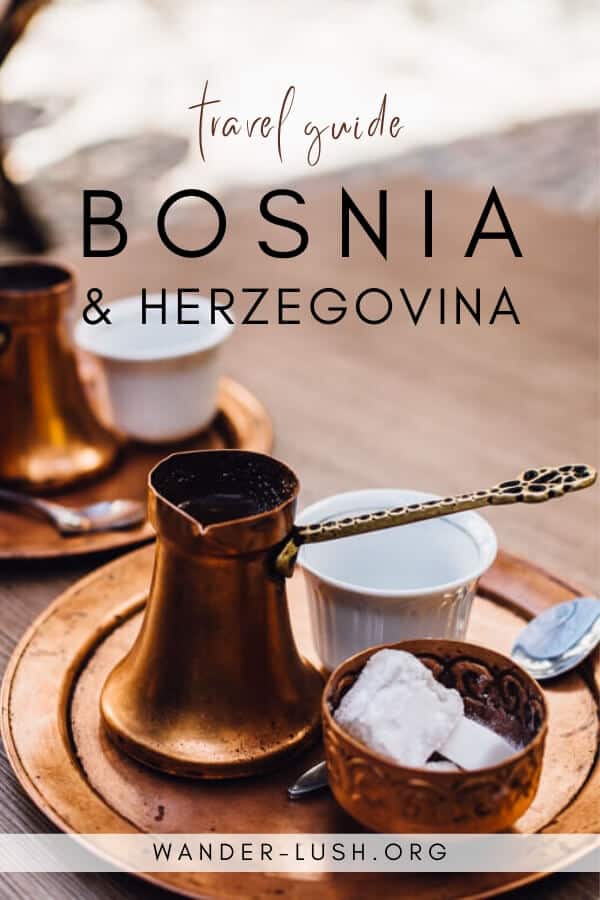
Bosnia travel essentials
Please note: Some of these links are affiliate links, meaning I may earn a commission if you make a purchase by clicking a link (at no extra cost to you). Learn more .
April/May or October/November (spring/fall shoulder seasons).
How long in Bosnia?
2 full days for Sarajevo; 5-7 days for the highlights; 10 days to see everything.
Daily budget
35-50 USD per person per day (mid-range hotel; local meals; bus fares; museum tickets).
Getting there
Fly into Sarajevo or Tuzla; drive/bus/taxi from any neighbouring country.
Visa-free for most passports (stay up to 90 days).
Getting around
Hire a car; use intercity buses and vans.
Where to stay
Hostels, family-run guesthouses or hotels.
Tours & experiences
Market tours, UNESCO sites and wild landscapes.
Things to do in Bosnia and Herzegovina
In Sarajevo , BiH’s capital city, the line where Asia stops and Europe begins (or is the other way around?) is literally drawn in the sand. A plaque on the pavement separates the Austro-Hungarian-built part of the city, with its market halls and plasterwork facades, from the Ottoman quarter, with its public fountains and singing minarets.
Sarajevo’s Old Bazaar , Bascarsija , is pure magic. As you dart between tea houses, carpet shops and Buregdzinicas (bakeries specialising in burek ), you move to the rhythm of tradesmen who still pound bronze with the same fervour as they did centuries ago.
As you cross the stone bridges in Mostar , Visegrad and Konjic , you begin to understand that not only is each one a proxy for a devastating chapter of Balkan history (which every traveller must take the time to learn about), it’s also a symbolic bridge between past, present and future.
From Jajce , the city with roaring waterfall at its centre to Pocitelj , an almost-abandoned Ottoman town, Banja Luka , the country’s second city to the sweet Trebinje ; between the Dinaric Alps , the Pliva Lakes and the ambling River Drina , Bosnia and Herzegovina has a way of making you feel alive.
Explore Bosnia and Herzegovina
Discover all the best things to do in Bosnia with my latest travel guides.
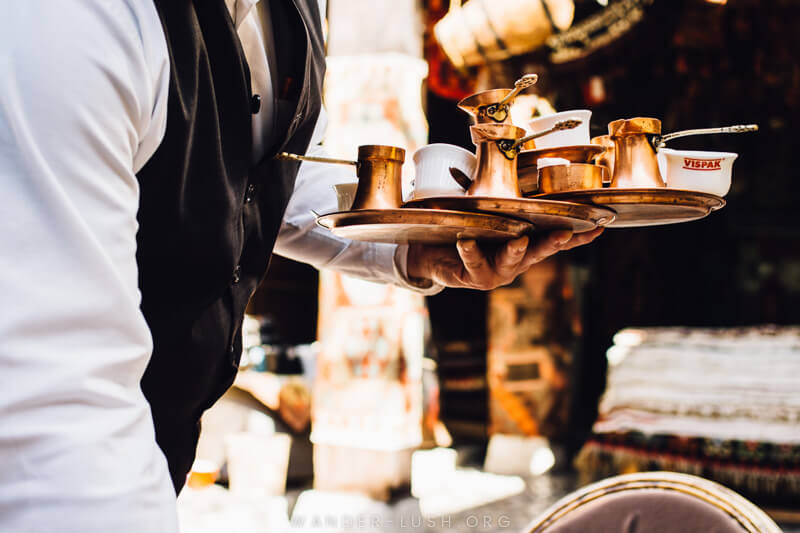
Sarajevo Through the Lens: 42 Magical Photos of Bosnia & Herzegovina’s Capital

How to Spend One Day in Mostar: 24 Hours in Bosnia and Herzegovina’s Most Captivating City
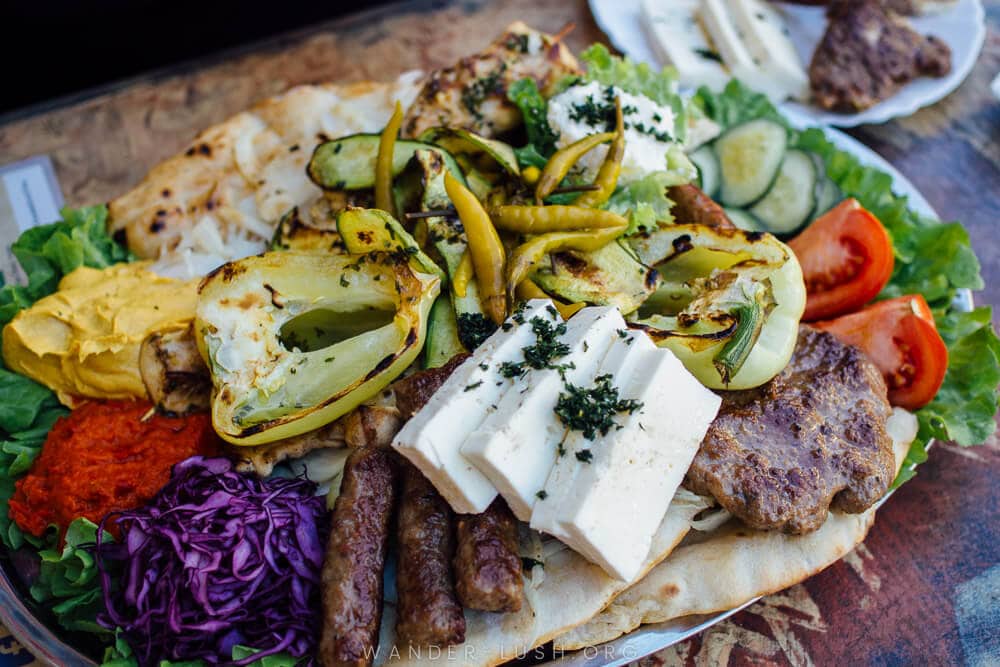
The Best Bosnian Food: 20 Delicious Things to Eat & Drink in Bosnia and Herzegovina
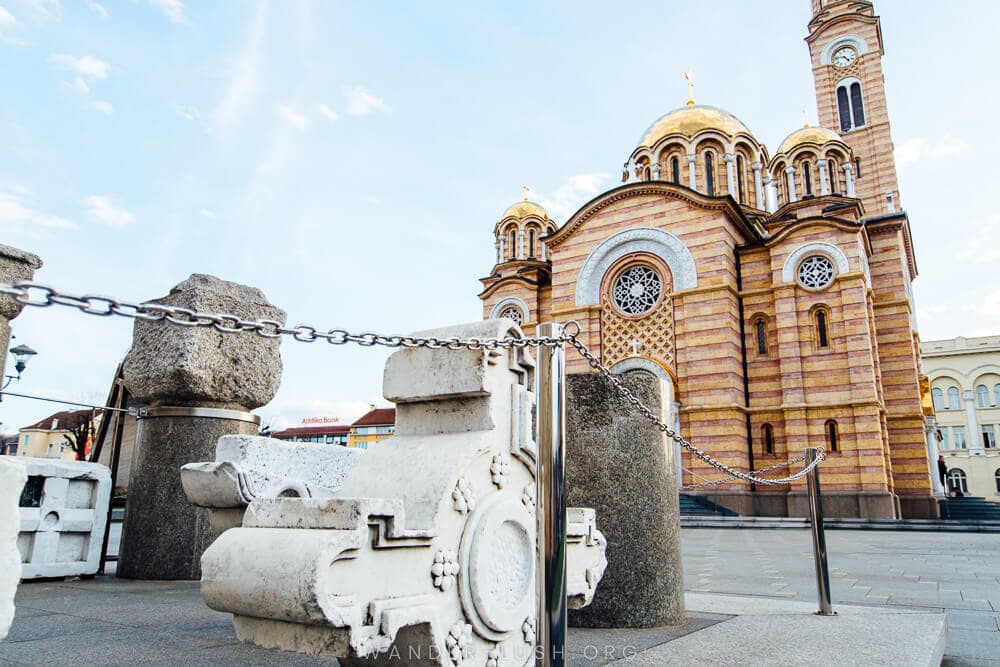
12 Things to do in Banja Luka, Bosnia & Herzegovina’s Second City (Republika Srpska)
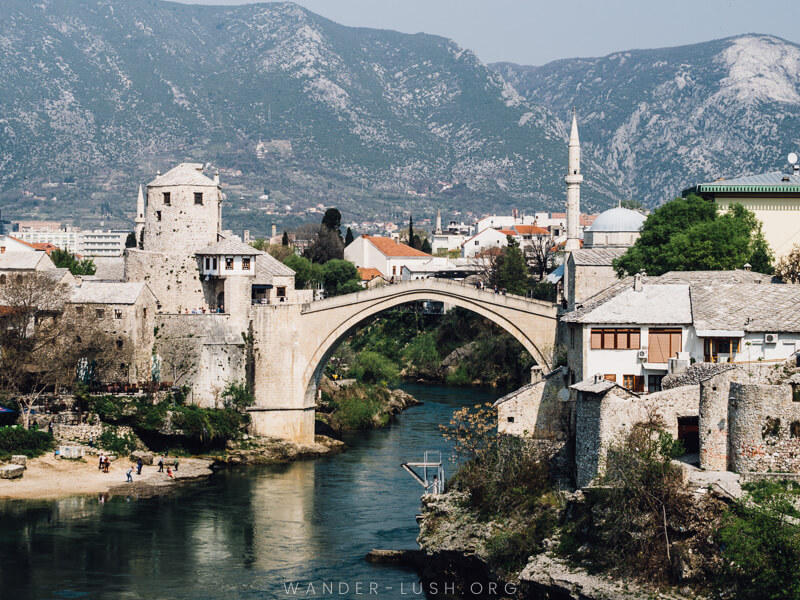
12 Best Sarajevo Day Trips for History, Nature & Culture
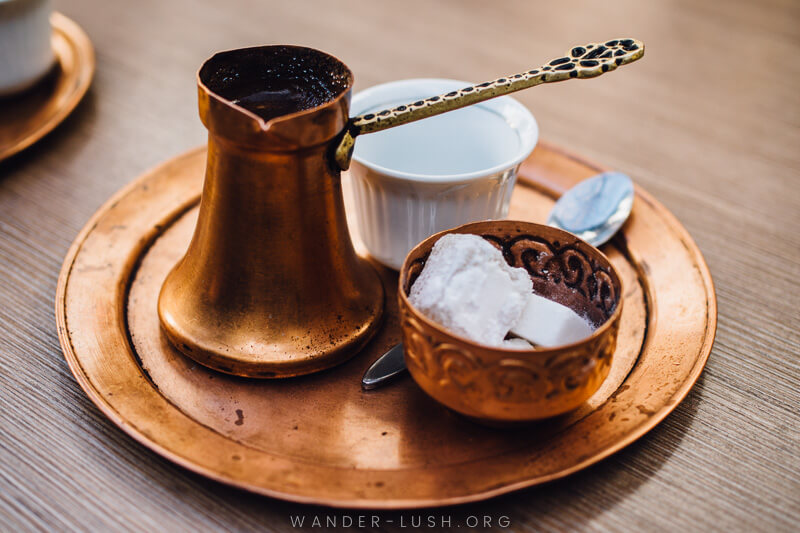
5 Things I Learned on a Sarajevo Food Tour

Pliva Lakes & Watermills: A Guide to Visiting From Jajce

A Quick Guide to Jajce, Bosnia & Herzegovina’s Cascade City

Mostar to Pocitelj: A Complete Guide to Visiting the Ottoman-era Open Air Museum
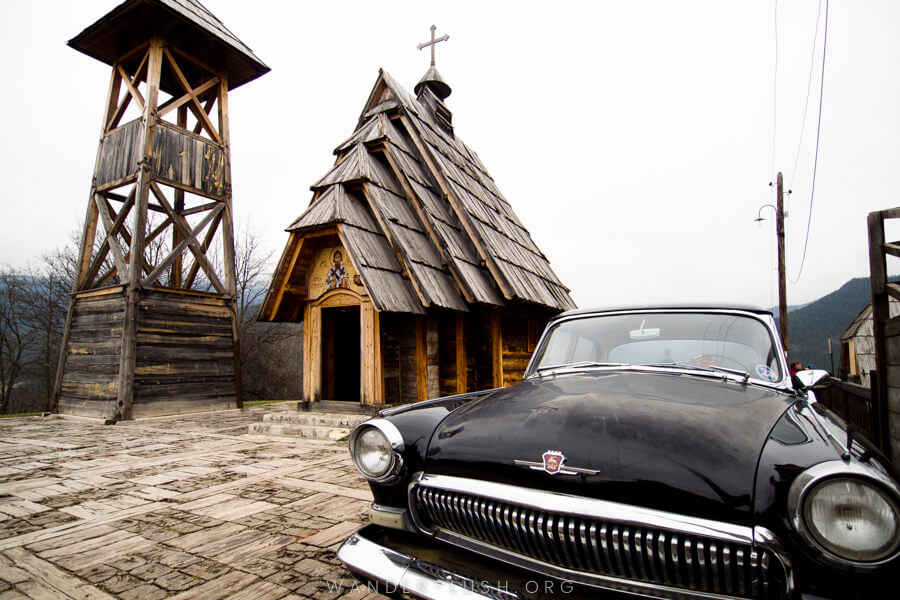
An Epic Day Trip from Sarajevo to Visegrad, Borak Stecci and Mokra Gora
My bosnia favourites.
Via Dinarica Trail (Slovenia to Kosovo via BiH).
Must-eat meal
Tufahija (baked apple) with a Bosnian coffee.
local experience
Watching the sunset over Sarajevo from Bijela Tabija.
best souvenir
A copper tray or coffee pot from the Sarajevo Old Bazaar.

- Bosnia and Hercegovina
- See & Do
- Attractions
- National Parks
- Stay Updated
- All See & Do
- Winter Activities
- Summer Activities
- Art and Culture
- Religious Objects
- Sightseeing
- Bars Cafes Pubs
- Restaurants
- Sweet Tooth
- Local Specialities
- Vegan Friendly

the ♥shaped land at your fingertips
Discover Enchanting Landscapes, Rich History, and Vibrant Cultures

YOUR JOURNEY BEGINS
EXPLORE, ENJOY, EXPERIENCE
Discover Bosnia and Herzegovina, a treasure trove of natural beauty and historical wonders. Let us guide you through our spectacular landscapes, ancient landmarks, and vibrant cultural scenes. Every corner of our country offers a unique story and an unforgettable experience. Start your adventure here!
GET INSPIRED
UNCOVER THE HIDDEN GEM OF EUROPE

HIGH ABOVE THE CANYON TIJESNO

THE SKY VIEWS

JAJCE AND ITS HIDDEN BEAUTY

THE TOUCH OF HISTORY

FEEL THE SPIRIT OF SARAJEVO

THE NATIONAL PARK SUTJESKA

DISCOVER THE HIDDEN BEAUTIES OF RS

BREATHTAKING BIH

THE UNTOUCHED NATURE OF BIH
In the heart of cultural diversity.
Discover the upcoming events
Traditional & International
Taste the flavors of BIH

let them inspire you
photographer
Dženad Džino
PHOTOGRAPHER & NATURE LOVER
I live in Jablanica and growing up here I was drawn to nature and mountaineering, since the very childhood. Naturally, a passion for photography became a part of my life. My photos have won awards at both domestic and regional competitions. I received the Golden Plaque of the city of Jablanica in the field of tourism for the promotion of the city.[ … ]
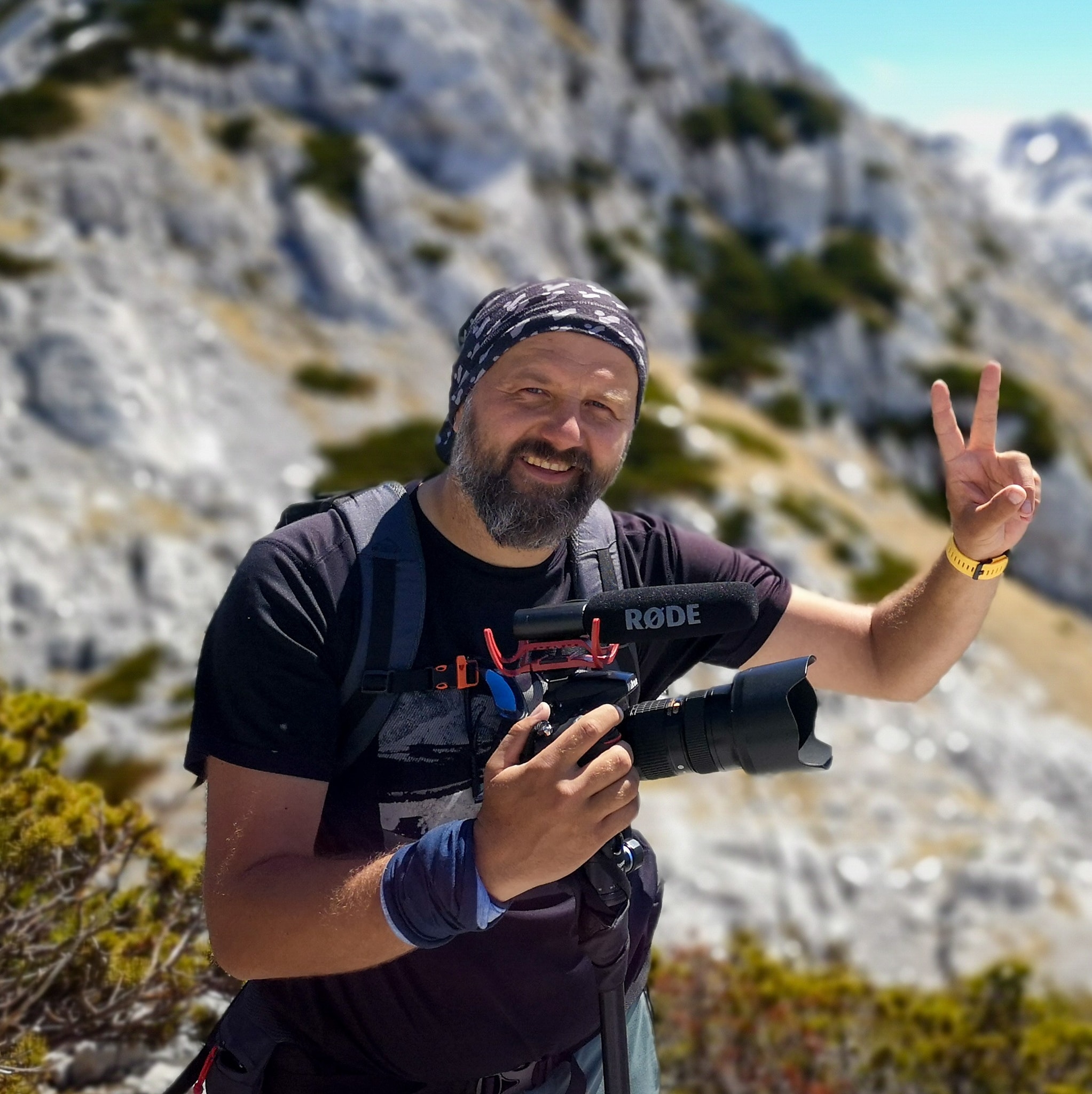
And many others
Ambassadors
Wild and free
GET STARTED TODAY
DOWNLOAD OUR APP
Elevate your travel experience with our official Bosnia and Herzegovina Tourism app. Plan your trip effortlessly, access detailed guides, and get personalized recommendations at your fingertips. Whether you’re looking for hidden gems or the most popular sites, our app makes it easy to navigate and enjoy Bosnia and Herzegovina. Download now and start exploring!

popular articles
Krupa na vrbasu – a rare gem nearby banja luka, pecka visitor center, blidinje nature park, mostarska bijela, una national park.
Plan your trip

Practical information
- Important telephone numbers
- Working hours
- How to access the internet
- Mobile applications
- Postal services
- Pharmaceutical services

Getting to Bosnia & Herzegovina
- Travel to BiH by car
- How to travel to BiH by plane
- How to travel to BiH by train
- How to travel to BiH by bus
- Border formalities
- Tax, customs and airport taxregulations on Bosnia and Herzegovina

Where to stay in Bosnia & Herzegovina
- Staying in hotels in BiH
- Staying in hostels in BiH
- In touch with nature
- Special accommodation
- Houses outside the city

Getting around BiH
- How to move around BiH by bus
- How to move around BiH by car
- How to move around BiH by train

- VAT and tax free shopping
- Currency in Bosnia and Herzegovina
- Money exchange
- Credit and Debit Cards

Health and personal safety
- In case of emergency
Our Partners

Subscribe to our newsletter
JOIN OUR COMMUNITY
Get the latest updates and exclusive insights into Bosnia and Herzegovina’s must-see destinations directly to your inbox. Discover travel secrets, special offers, and inspirational stories that will ignite your wanderlust. Don’t miss a beat—sign up now and be part of every adventure!

VOICE OF GUIDES
Bosnia-herzegovina ultimate travel guide+itinerary (4 days; 5 days; one week).
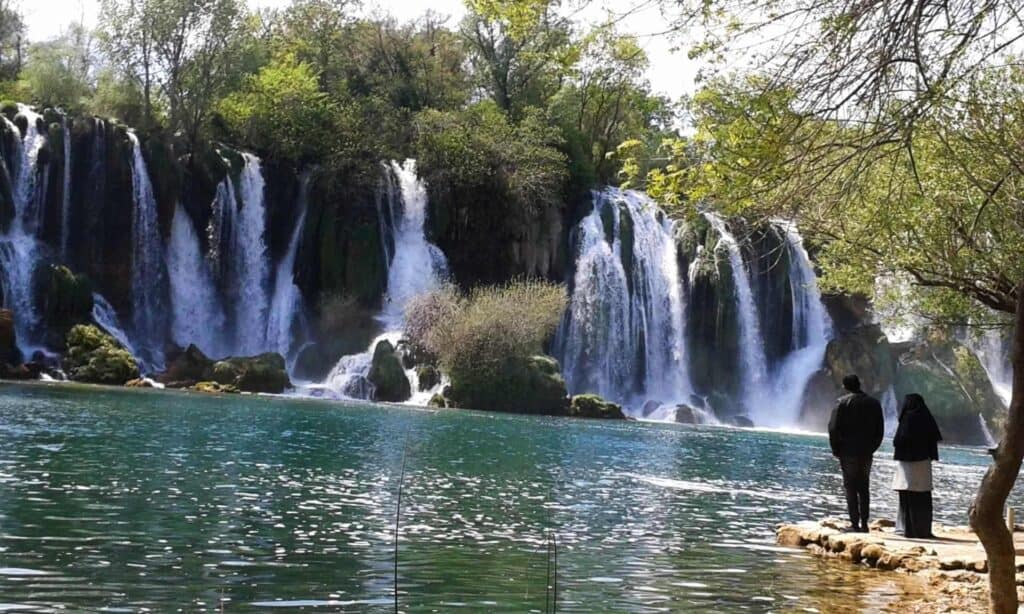
This article may contain affiliate / compensated links. For full information, please see our disclaimer here.
Are you planning to travel around Bosnia and Herzegovina, or you combine it with other countries in the Balkan? While Mostar and Sarajevo sound familiar to everyone, there is so much more to see in this country that has an amazing landscape with rivers, lakes, forested mountains, canyons and a fascinating cultural diversity with mosques, orthodox and catholic churches standing next to each other. Whether you make a road trip or you are backpacking, in this travel guide, you find the must-knows before visiting the country, from culture to history, travel tips, and an ideal itinerary for 4 days, 5 days, and one week in Bosnia and Herzegovina.
How to get to Bosnia?
By flight: several airlines (Ryanair, Wizzair, Pegasus, Eurowings) fly to Bosnia and Herzegovina. Sarajevo has the biggest airport, but Mostar, Tuzla, and Banja Luke also accept some international flights, which tend to be much cheaper.
By bus: Several buses are from Germany, Austria, Croatia (Dubrovnik, Split, Zagreb), and Serbia (Belgrade).
Check the schedule within Bosnia and the international bus connection here .
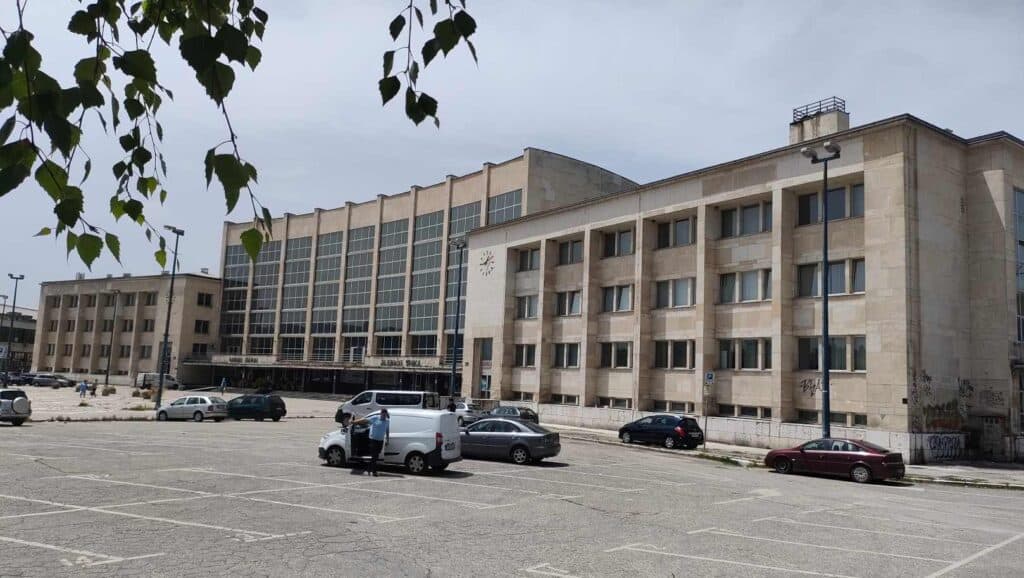
by Agnes Simigh
I’m a passionate tour guide and travel writer, who is curious to discover places that seldom catch the attention of the media or that are misrepresented. My goal is to inspire you to choose off-the-beaten-track destinations by sharing objective and detailed information. I believe that it is mainly the lack of “intel” that keeps us away from incredible places. And that just shouldn’t be the case.
Other posts about Bosnia and Herzegovina
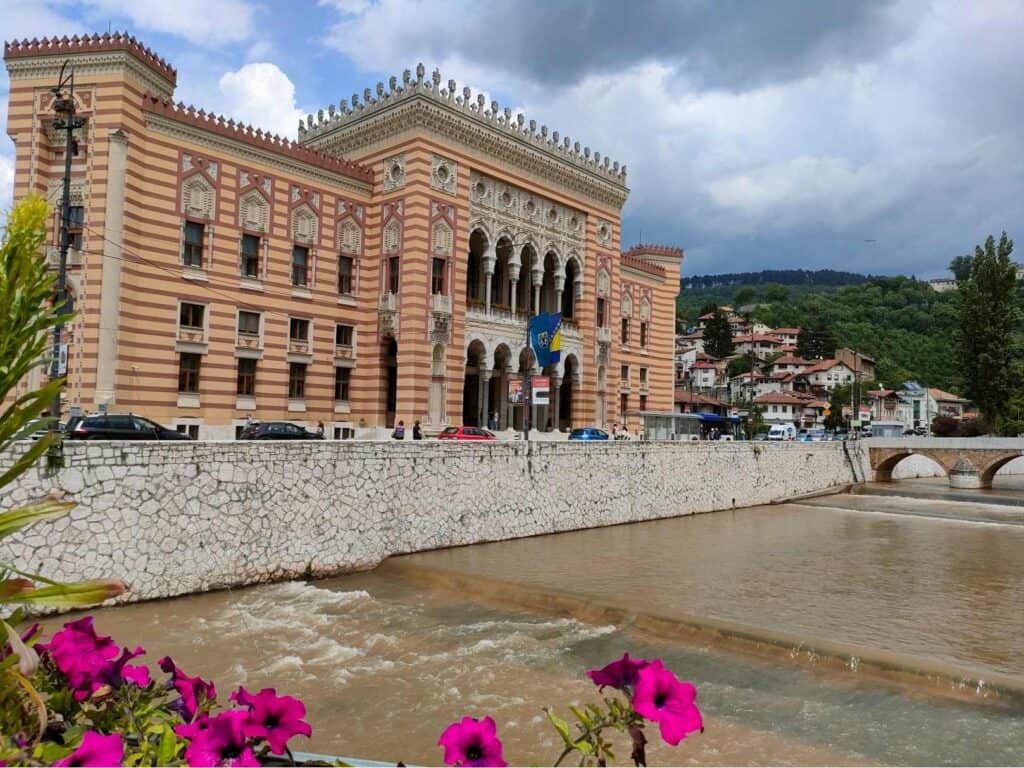
TRAVEL GUIDE TO SARAJEVO+ 1 DAY, 2 DAYS AND 3 DAYS ITINERARY
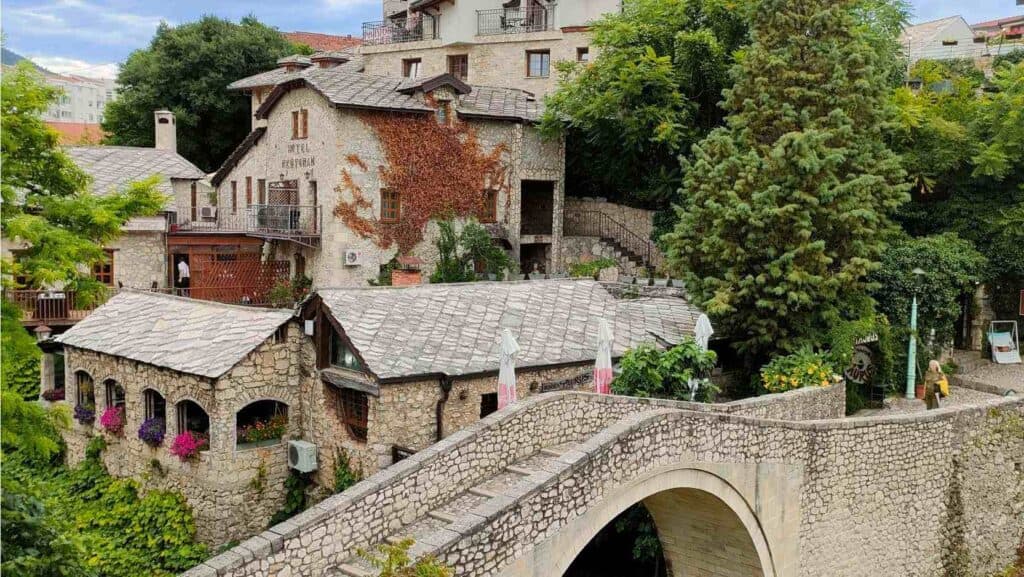
MOSTAR TRAVEL GUIDE: WHAT TO DO IN MOSTAR IN ONE DAY
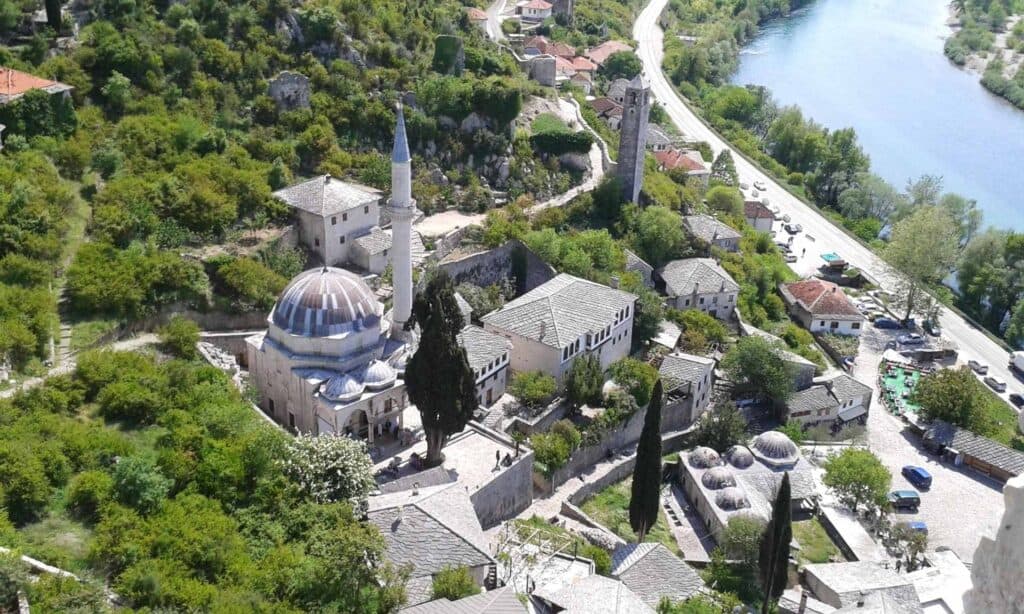
10 BEST DAY TRIPS FROM MOSTAR
Leave a comment cancel reply.
Your email address will not be published. Required fields are marked *
Save my name, email, and website in this browser for the next time I comment.
Privacy Overview
- TRAVEL ITINERARY PLANNING
- Ladakh Kashmir budget group tour
- TRAVEL RESOURCES
- BEST TRAVEL BLOGGING COURSES
- BEST VIRTUAL CITY AND COUNTRY TOURS
- TRAVEL GIFT IDEAS
- WAYAWAY CHEAP FLIGHTS
- Bosnia and Herzegovina
TTC family of brands
My Trafalgar
Destinations
Get Inspired
866 513 1995
Bosnia Herzegovina

See All Bosnia & Herzegovina tours
Trending Bosnia and Herzegovina trips
Save up to $365
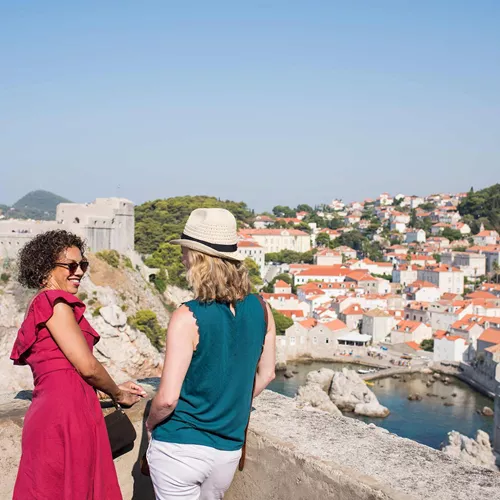
Balkan Delight
8 Locations
3 Countries
Save up to $569
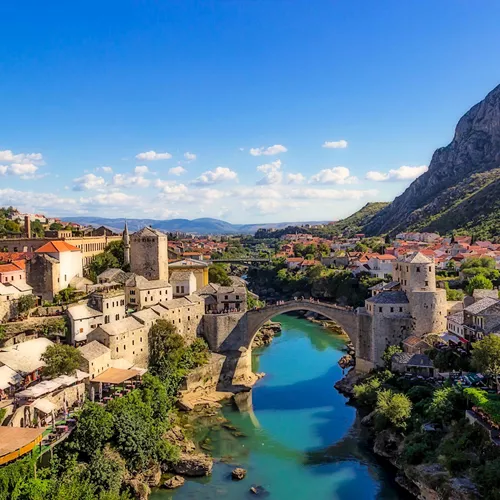
Balkan Adventure
13 Locations
7 Countries
See More Bosnia And Herzegovina Trips
5 million happy guests and counting
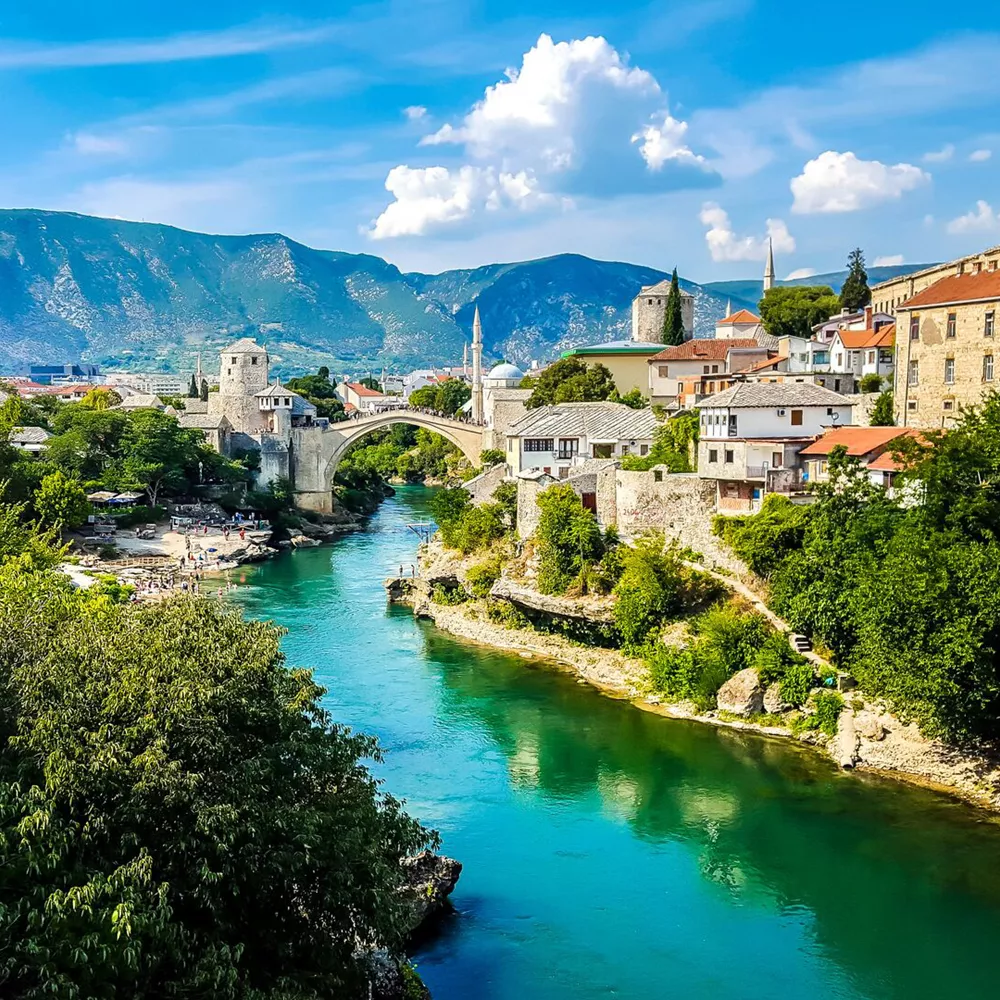
Winter avg temp
Summer avg temp
Good morning
Dobro jutro
Good evening
"While Bosnia was once known for its horrifying wars and endured a terrible past, the country is healing and today it radiates harmony and tranquility. I love introducing our guests to the friendly locals at the traditional markets and restaurants, and watching people connect over good food and laughter."
Travel Director
Admire the Stari Most Ottoman-style bridge
The Stari Most bridge is one of the most incredible places to visit in Bosnia, and we’ll take you there with a Local Specialist to admire the fairytale views and learn the tragic story behind the medieval bridge that was destroyed during the Bosnian War. It has since been rebuilt using old traditions and today it’s a beautiful symbol of reconciliation.
Learn about the religious & multicultural heritage of Sarajevo
Our Sarajevo tours take you to the heart of the ‘Jerusalem of Europe’ and its multicultural history with a Local Specialist. You’ll get an insider’s look on a walking tour where you’ll discover Bosnia’s centuries of religious history in the stunning mosques, synagogues, and Catholic and Orthodox churches.
Walk through the colorful cobbled streets of Mostar
If you’re looking for the best places in Bosnia, you can’t go past Mostar, a gorgeous riverside town filled with Ottoman architecture, UNESCO sites, mosques, churches and traditional markets and restaurants. You’ll join your Bosnia travel guide for a stroll through the vibrant streets and get an insight into the real Bosnian way of life in the Old Town čaršija (market).
Visit the War Tunnel in Sarajevo
The War Tunnel is one of the most moving of all Bosnia’s attractions. We’ll take you there with a Local Specialist who will share his special personal insight on a tour of this underground tunnel of hope. Built during the Siege of Sarajevo, the tunnel allowed food, supplies and humanitarian aid to reach the city for four years during the Bosnian War.
Visit the Sarajevo Old Town and trace the Sarajevo Roses
Our Bosnia holidays will have you meeting a Local Specialist and strolling through the beautiful Sarajevo Old Town. You’ll set eyes on the largest mosque in Bosnia, visit the Eternal Flame and see the Sarajevo Roses dotted across the city. The roses are a stirring reminder of the turmoil the city endured decades ago.
Our top 5 things to do in Bosnia & Herzegovina
Our Bosnia tours will show you all the best things to do in Bosnia & Herzegovina, from seeing the famous Stari Most bridge to wandering the historic Sarajevo Old Town.
Museum Of War And Genocide Victims
This Mostar museum is the best place in Bosnia to learn about the country’s dark past. It’s dedicated to the memory of the victims of the Bosnian genocide and the Srebrenica massacre from 1992-1995. You’ll see photos, documents, and personal belongings, and learn about the brutal concentration camps and mass graves of the genocide.
Museum of the Old Bridge
Set within the Tara Tower, one of the defensive towers guarding the Old Bridge (Stari Most), this museum tells the famous story of the reconstruction of the bridge. You’ll get to see archaeological remains, learn the fascinating history of the bridge, wander the gallery, and admire the stunning views from five-stories high.
If you want to learn about Bosnian culture and history in one place, Bosnaseum is the place to go. You’ll learn about the country’s history from the Ottoman Empire era to the end of the Bosnian War including the destruction of Stari Most. Plus discover Bosnian culture including traditional costumes and a model of a Herzegovina village.
Best museums in Bosnia and Herzegovina
You can’t visit the incredible country without checking out some of the top Bosnia museums, from the Stari Most museum to the museum of Bosnian history and culture.
These grilled meat sausages are a beloved dish all over the Balkans, but they hold a special place in the hearts of Bosnians. Every region has their own unique recipe, and they’re traditionally made with a spiced mix of beef, pork and lamb. Grab a pita bread and stuff it with onions and Ćevapi and you’ve got the ultimate Bosnian food.
Bosanski lonac (The Bosnian pot)
Looking for some Bosnian comfort food? Look no further than the Bosnian Pot. The ingredients vary from family to region, but this hearty stew is always overflowing with rich chunks of meat and vegetables. The local saying goes “you should eat something with a spoon each day”... So grab your spoons and tuck into the Bosnian Pot.
This is another beloved Balkan dish and you’ll find delicious variations of these doughnut-like balls of fried dough all over the region. In Bosnia, uštipci is traditionally served up as a crispy, delicious snack, dipped in all kinds of cheeses like kajmak, a creamy, dairy spread. But be warned - you can't stop at just one!
Best food in Bosnia and Herzegovina
Bosnia and Herzegovina’s food is sure to be one of the highlights of your trip. We can’t wait to introduce you to all the favorites, from grilled sausages to fried dough balls.
What to pack for Bosnia & Herzegovina

With all kinds of beaches, waterfalls and rivers, you never know when you might want to take a dip in the water on your Bosnia holiday. Pack a swimsuit and be ready for anything.
Insect repellent
The Balkan Peninsula is known for its mosquitoes - including Bosnia & Herzegovina. Pack some good insect repellent and itch cream to soothe any mosquito bites.
Sun protection
Whether you’re traveling in the hot summer or the chilly winter, you’ll need a hat, sunglasses and high SPF sunscreen to protect your skin on your Bosnia trip.
Walking shoes
From the cobbled streets of Mostar to the historic tunnels of Sarajevo, you’re sure to be doing a lot of walking on your Bosnia tours. Bring your most comfortable pair of shoes.
Bosnian phrasebook
It’s handy to learn a few common words and phrases in the Bosnian language, especially if you plan on visiting more rural areas - and the locals are sure to appreciate your efforts.
Pack for sustainable travel
Consider your environmental impact when you next take a trip and go single-use-plastic-free by packing a reusable water bottle, a steel straw, your own shopping bags and refillable toiletry bottles.
Our Europe & Britain destinations
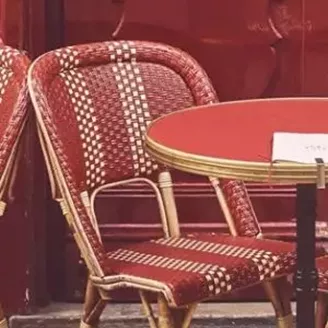
Czech Republic
Liechtenstein
North Macedonia
Netherlands
Northern Ireland
Switzerland
Other worldwide regions we visit
Africa the Middle East
Australia and New Zealand
North and Central America
South America
Get your free brochure
Find your next escape with the world's leading travel brand
Request A Brochure
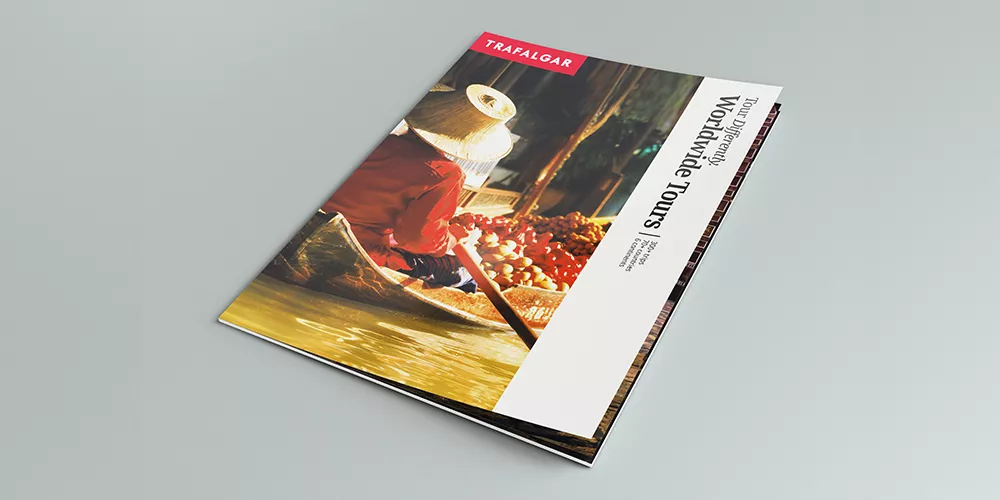
Award winning tours
Every year, we're proud to win some of the most prestigious travel accolades around the world - from the Travel Globes to the Agent's Choice Awards
Search Our Tours

Help & Info
WE MAKE TRAVEL MATTER®
Unedited Reviews
Our Destination Management Companies
Frequently Asked Questions
Travel Updates
Do Not Sell or Share My Personal Information
Travel Planning
Get Your Free Brochure
Travel Insurance
Booking Conditions
Trip Deposit Level
Recommendations
Trafalgar Tours Limited is a proud member of The Travel Corporation family of companies.
#SimplyTrafalgar
Travel House, Rue du Manoir St Peter Port, Guernsey, GY1 2JH
Selected Region
United States
United Kingdom
New Zealand
South Africa
Copyright 2024 Trafalgar. All rights reserved.
Terms and Conditions
Privacy Policy
Cookie Policy

Bosnia & Herzegovina Travel Guide
Last updated on May 18, 2024 by Shannon

The Balkan States are not a region many mainstream travelers have on their bucket list of places to visit next. It’s still considered an offbeat region, although that is changing quickly. Croatia leaped onto the tourist radar over the past decade, and as tourism increases, many are discovering that neighboring Bosnia & Herzegovina is a destination in its own right.
I’ll fess up right now, I deeply loved my weeks the country, and I consider it one of the most underrated places I’ve visited. The country is stunning and the people are warm. Also, the country has waged a huge effort to overcome the atrocities of the 90s war, and they are a culture and people moving forward, but not forgetting.
Bosnia is still flying under the radar for most travelers; Croatia and Montenegro are hotspots for their coastline, but Bosnia has a stunning mountain scenery and a culture unique to the region. For travelers, it makes a fascinating vacation—if not the easiest travel experience. English is not widely spoken throughout, not even in some of the touristy areas. If you visit with a sense of adventure and patience, you’ll find everyone friendly and willing to pantomime with you if that’s what it takes!
There’s a lot to do on a trip to Bosnia & Herzegovina. Rafting the country’s gorgeous rivers is hugely popular, as are winter sports too. The country has a stunning landscape—mountains, rivers, waterfalls—it’s easy to navigate on public transport, and the people are hospitable and welcoming to tourists.
Bosnia is a beautiful, offbeat place to explore and I highly recommend it. Consider socially responsible travel, and read on for more information you should know before you visit Bosnia & Herzegovina. Or jump straight to the city-level travel guides.
Table of Contents
Is Bosnia Safe for Tourists?
Crime is low in Bosnia, and crimes against tourists are rare. That alone makes Bosnia among the safer destinations for travelers. Pickpocketing and petty theft in crowded areas and public transport are the biggest threats, which can be averted by using a crossbody travel purse . If you’re using a rental car to road trip around Bosnia, drive defensively and adhere to traffic rules. Mountainous regions may have narrow and winding roads, so drive carefully and be aware of other vehicles.
Landmines are still a major concern in isolated areas—they were used extensively during the 1990s conflict in Bosnia. Stay on marked trails and roads, and follow any warning signs that you encounter. If you’re driving the country, or hiking, be extremely cautious. Also, if you’re visiting smaller towns, carry enough cash to cover your stay in case the town doesn’t have an ATM.
Bosnia is an ideal solo travel destination as a result of its small cities and safe, easily navigable countryside. That said, anything can happen on the road. I am a firm advocate of broad-coverage travel insurance like IMG Global ; these are my main tips for picking a good travel insurance .
Fast Facts About Bosnia & Herzegovina Travel
Bosnian Convertible Marka (BAM) ( current exchange rate )
Electricity in Bosnia
230V/50hz. European 2-pin (Type C & Type E). Americans will need an adaptor.
Primary Airports
Sarajevo Airport (SJJ)

Is the water safe to drink in Bosnia?
Both safe and unsafe. Sarajevo has safe tap water and very strong food safety measures. Rural areas of the country are not safe.
Bring a reusable bottle and refill with safe water, or consider the merits of a SteriPen or LifeStraw for your trip.
Is there good wifi in Bosnia?
Internet has come a long way since my first visit in 2009. Internet is far more widespread than it once was, and pretty decent. Most hostels and many hotels will offer it complimentary.
This is a good list of free wifi spots in Sarajevo, and they have listings for all major cities if you’re in a pinch and need a connection. You can also hotspot yourself in a pinch and that works reliably.
Local SIM Card
Mobile data is available in most areas and is very affordable. BH Telecom is the best option for maximum chance of coverage throughout both Bosnia & Herzegovina.
You will find prepaid SIM kiosks; just buy one of these and top up for the amount of data/time that you need. There are both data + voice, and just data options; it’s explained more here with kiosk location information too.
Best Time to Visit Bosnia
May through September is the best time to enjoy Bosnia and Herzegovina. Winters are bitterly cold in the region, but summer is hot and sunny.
What’s the visa situation like?
North Americans and Europeans do not need a visa to visit Bosnia-Herzegovina for up to 90 days. Most of Central and South America is covered under that same policy.
Those outside of this region who hold a Schengen visa are admitted for 15 days. Check the latest visa requirements here .
Food Considerations
This region of the world is hard for vegetarian travelers. They are meat-heavy cultures and with so little English spoken, it can be hard to communicate dietary restrictions. But the fresh food at markets is easy to acquire. I always carried an apple in my bag to stave off hunger.
Plan on eating a lot of spinach and cheese bureks—they’re vegetarian and make a tasty lunch (especially with plain yogurt!). I wrote a bit about what it’s like to be a vegetarian traveler in Bosnia . You must learn “I’m vegetarian and I do not eat meat” in Bosnian. You will need it. Also, consider these food safety principles when picking where to eat.
Accommodation
Bosnia has a well-developed tourism infrastructure, despite relatively low levels of tourism. You can easily book pensions, B&Bs, and hostels online, or via phone if you’re driving around the country. Consider booking with locally-owned accommodation to ensure the money is staying within the communities.
In rural areas, look into eco-lodges and ethno villages—these ensure you have the lowest impact possible on the local environment. I stayed with locals in Sarajevo and it was such a wonderful way to see the city.
For backpackers, Booking.com is perfect for pre-booking hostels. And if you buy a local SIM card (which you should), you can easily call ahead and directly reserve spots en route. If none of these will do, check out my detailed guide to finding good places to stay .
Pick out accommodation on Booking.com.
This is the only booking platform I use because it rewards you for loyalty, and I regularly score free breakfasts and 15% off my hotel.
Festivals of Note
- Street Art Festival in Mostar (Spring)
- Sarajevan Winter (February/March)
- Bascarsija Nights (July)
- Jazzfest Sarajevo (November)
How much should you budget to travel in Bosnia?
This is a good budget destination, though not rock-bottom prices. The day-trippers from Croatia’s cruise ships jack up the prices a bit in Mostar. Generally, backpackers should plan on about $30 per day—this includes budget eating like bureks/cevapi and hostels throughout your stay.
Low-end hotels are also pretty nice, so for a bit more, you can easily upgrade. This page gives a good budget overview for various travel styles.
How to Travel Around Bosnia
The train system in Eastern Europe is extensive fantastic for getting into Bosnia. Because other countries are close, many travelers arrive in Zagreb and train into Sarajevo. Also, the bus system takes over nicely where the train doesn’t go.
Traveling Bosnia is not the cheapest travel in the world; neighboring countries are on the Euro and that has inflated the costs a bit. Buses will get you everywhere you need to go, but may take a bit of planning if you want to head anywhere but Sarajevo and Mostar as only a couple buses each day run to the smaller cities. Both major touristy cities, Mostar and Sarajevo, are quite walkable.
History to Know Before Traveling to Bosnia & Herzegovina
Throughout the Bosnian War, many people were displaced to neighboring countries. Others left as refugees, never to return. And many lost their lives. Travelers should dive into the recommended readings and form a nuanced understanding of the region’s past, as well as how that has affected its current politics.
If you’re traveling to the Balkans, you should do a fair bit of contextual research before you go. Like many countries with a recent history of war, there is a delicate peace among the people. Consider this a quick overview, but I highly recommend you dive into the recommended readings below—many are easy to load onto your Kindle—so you have a nuanced understanding of the region’s past, as well as how that affects its current politics.
First settled by the Slavic peoples, around the 14th century Bosnia and Herzegovina became a province of the Ottoman Empire. It’s this influence that brought Islam to the region.
Bosnia and Herzegovina stayed under Ottoman control until that influence began to wane throughout the 18th and 19th centuries. By the end of WWII, Bosnia and Herzegovina had become part of the Socialist Federal Republic of Yugoslavia.
Bosnia and Herzegovina declared sovereignty and independence from the former Yugoslavia in 1991 and 1992. It’s this action that set off a chain of events that would shape the country’s next few years— the Bosnian War was a bloody civil strife focused around ethnic and religious differences.
The Serbs resisted the declaration of independence, preferring to create a country divided along ethnic lines that aligned to neighboring Serbia and Croatia. Eventually, NATO—alongside internal and external forces—created a accord that ended with a Peace Treaty signed by all parties. But that peace took years and some might say is shaky.
Throughout the Bosnian War, many people were displaced to neighboring countries. Others left as refugees, never to return. And many lost their lives. The country’s capital experienced the longest siege of a capital city in history. Sarajevo was under siege for four years and the effects of that are still visible there, as well throughout other areas of Bosnia and Herzegovina.
Modern-day Bosnia and Herzegovina has a diverse population, with independence uniting the country’s religious and ethnic groups. Roughly 45% are Muslim, 36% Orthodox, and 15% Catholic.
With the past divisions in mind, it’s important to understand that there are two (and sometimes three) distinct regions that have united to act as one country and to function under one currency. And though unity in mid-90s brought peace to the region, there are still tensions and politics that are deeply embedded in the region’s history.
For travelers, understanding the 90s civil war is important. Even with that foundational history, however, it’s best to steer clear of discussing religion or politics, nor should you presume to refer to locals under one of the terms that denote ethnicity/religion/regional ties such as: Bosniak, Croat, and Serb. Bosnian is usually considered neutral to refer to anyone from the region and does not connote religious/ethnic ties. If you’d like more history, this is a quick and thorough timeline of the country’s historic events .
Books About Bosnia & Herzegovina
Fiction & nonfiction books about bosnia & herzegovina.
This region’s war-torn past is recent; I highly recommend that you preface any trip with any of these recommended books and articles. There is a delicate nuance to even the most subtle language you use. Knowing the history and the culture smooths over awkward moments (like my first accidentally offensive moments in a cab in Bosnia!) and gives you a richer experience. Knowing the history is more important here. You may step on toes without even knowing it like I did.
- Goodbye Sarajevo : I find memoirs a compelling way to learn about history, as well as its impact on the citizens living through that piece of a nation’s history. This true story is a beautiful piece that looks at how a set of siblings coped during the war, and how they reconnected to life and each other after the war ended.
- Zlata’s Diary: A Child’s Life in Wartime Sarajevo : A riveting and heartbreaking look into how the outbreak of war changed the lives of the people living through it.
- Balkan Ghosts: A Journey Through History : Fascinating travelogue and history of the Balkan region as the author delves into the roots of the Balkan conflicts and how they are manifested in the modern Balkan states.
- Black Lamb and Grey Falcon : Beautiful and lyrical book that combines the author’s travelogue with a history of the region and insights from the region right as World War II began. A compelling way to read about Balkan history though it can be hard to distinguish fact from fiction throughout.
- The Bridge on the Drina : The book is a vivid depiction of the suffering history has imposed upon the people of Bosnia from the late 16th century to the beginning of World War I. It has been hugely well received and will give political insights to the region and Balkan and Ottoman history.
Podcasts and Online Reads About Bosnia & Herzegovina
- 14 Years a Fugitive: The Hunt for Ratko Mladić, the Butcher of Bosnia : A chronicle of how this Bosnian-Serb general—who is accused of killing thousands of civilians at Srebrenica and Sarajevo—evaded capture for so long.
- Life in the Valley of Death : A sad and sobering long read about the man whose job it was to find the mass graves of those executed in during the war.
- Bosnia Divided : A look at the soccer culture in the country and what the divided football culture says about the divisions that remain with the cultures living in Bosnia & Herzegovina.
Read all my Bosnia & Herzegovina travel stories and find more regional fiction and nonfiction books and long-reads .
Recommended Guidebook
Bradt makes great guides for offbeat destinations; consider the Bradt Bosnia & Herzegovina for a dense list of options that show a unique side to the country.
Responsible Travel in Bosnia & Herzegovina
Bosnia & Herzegovina’s tourism scene is growing as neighboring countries take the spotlight. Travel to Croatia and Montenegro is on the rise, and Bosnia is seeing the benefits. While Bosnia-Herzegovina has little coastline like its neighbors, the country’s fast-flowing rivers and beautiful mountain ranges make for a wonderful nature holiday. As with any country, particularly those still developing strong tourism industries, it’s important to practice socially responsible travel. Consider these ideas when you’re traveling through the region.
Book Local and Eco-Friendly Accommodation
Bosnia-Herzegovina has a large network of locally-owned pensions and B&Bs. Additionally, once you leave the touristy cities and head into the surrounding nature, you’ll find ample opportunity to support the country’s eco-tourism efforts. Consider using eco-lodges and etno villages whenever possible.
These types of rural accommodations are designed to limit human impact on the environment and to preserve culture. The etno (also spelled ethno in some places) often include traditional building methods from the Balkan’s region, and they aim to recreate and educate about traditional village life.
Support Local Artisans
Buying your souvenirs from local craftsmen is a positive way to support traditional artisans techniques and handicrafts. It’s also an excellent way to experience the region, and to later remember that special part of the local culture. Consider learning about traditional winemaking at Lake Skadar, or discover Sarajevo’s copper-making history and traditions. Spending money with local businesses is one of the best ways to ensure your travels have a strong and last impact on the local economy.
Leave No Trace Behind
Many travelers visiting Bosnia & Herzegovina head to the mountains and into nature on their visit. Consider bringing a reusable water bottle to limit your use of plastic water bottles—you can easily refill. And when hiking, skiing, or participating in outdoors activities, carry your trash back with you. You may even choose to bring a small bag on hikes and help clean up the local environment, as some areas have a fair bit of litter. And for women, use a menstrual cup for not only easy of travel, but it’s eco-friendly, too.
Consider these additional responsible travel tips to lessen your impact on the places you visit.
Best Things to Do in Bosnia & Herzegovina
Rafting or kayaking on the Una and Vrbas rivers are two top spots for this adventure activity, and many rate Neretva Canyon as well. There are so many incredible and offbeat things to do in Bosnia and Herzegovina. This is a great spot for adventurous travelers keen for unique hikes and untouched mountains, and also for cultural travelers who love walking through history and seeing its visible effects.
The city and regional travel guides below share the best things you can see and do, as well as where to eat and sleep.
My Favorite Things to Do Traveling in Bosnia
- Taking in Sarajevo’s lively cafe culture .
- Observing and understanding the bombing damage in Mostar .
- Hunting down delicious delicious sweet eats around Sarajevo .
- Hiking to the cross above Mostar for sweeping views of the river, the city, and the Stari Most bridge.
- Wandering Mostar’s Old Town, then sipping tea and people watching in the late afternoon.
Don’t forget to book travel insurance for your trip —a great policy provides coverage in case of medical emergencies, lost or stolen gear, adventure sports riders, and more. I’ve used IMG Global for more than a decade highly recommend it !
Things to Do in Sarajevo
Sarajevo is the perfect size city for travelers. It’s the capital of Bosnia, and the biggest city in the country, but it’s still small. You can stand in the center of town and see the gently green rolling hills surrounding the city. I truly loved my time in Bosnia, perhaps even more because it’s not a tourist hot-spot. It’s a bit off the beaten path so you don’t queue for hours and it’s easy to strike up conversation with locals (at least, with those who speak English!).
You can easily use the transit system to explore the city. Just buy your bus tickets from the all-purpose magazine stands and shops—be warned the transit police will come on board regularly to check tickets. Plan many of your activities around food, this was my primary activity in the city. Find good spots to sample baklava, the traditional burek , and take the time for full tea, sugar, and Turkish Delight experience.
Explore the historic streets of Baščaršija.
Sarajevo’s Turkish quarter boasts weaving, cobblestone streets tiny shops selling fun souvenirs and postcards. Give the streets a wander for a couple hours—it will be a journey through time as you wander the narrow cobblestone streets of Baščaršija, the heart of Sarajevo’s old town. Lose yourself in the bustling marketplaces, where the aroma of traditional Bosnian dishes wafts through the air. Marvel at the beautifully preserved Ottoman-era architecture, adorned with intricate patterns and vibrant colors. Visit the iconic Sebilj fountain, a symbol of the city.
Eat a burek for lunch alongside locals.
Don’t miss the opportunity to taste mouthwatering cevapi, a local specialty of grilled minced meat served with fresh pita bread and creamy kaymak. Find a hole-in-the-wall burek restaurant for a delicious lunch amid the locals—this is where they head for lunch as well. Sit in the crowded little restaurants, sharing tables with the locals and the heat from the ovens permeating the space. The bureks and cevapi in these spots are worth it—as are the conversations!
Admire Gazi Husrev-bey Mosque and Bascarsija’s religious landmarks.
Find this Mosque, it’s gorgeous. You can explore Sarajevo’s religious heritage by visiting the grand Gazi Husrev-bey Mosque, an architectural gem from the 16th century. Marvel at its impressive dome, intricate calligraphy, and beautiful interior adorned with colorful tiles. Take a moment for reflection in the peaceful courtyard. While in Bascarsija, make sure to also visit other religious landmarks such as the Orthodox Cathedral, Catholic Cathedral of Jesus’ Heart, and the Jewish Museum, highlighting the city’s religious diversity.
Delve into Sarajevo’s history at the Latin Bridge.
Stand on the historic Latin Bridge, where a pivotal event unfolded that changed the course of history. This bridge is famously associated with the assassination of Archduke Franz Ferdinand of Austria in 1914, an event that triggered World War I.
Visit the nearby Museum of Sarajevo, housed in an elegant Austro-Hungarian building, and gain a deeper understanding of the city’s past through exhibitions that showcase its tumultuous history, from the Ottoman Empire to the Yugoslav era and the Bosnian War. It’s a profound opportunity to reflect on the resilience of Sarajevo’s inhabitants and the importance of preserving peace.
Hike the hills outside of Sarajevo.
The city sits flush into the surrounding hills, and there are beautiful landmarks in the distant hills. Climb the winding paths to reach the Yellow Fortress, perched atop a hill overlooking Sarajevo’s enchanting skyline. As you reach the summit, breathe in the fresh mountain air and be rewarded with panoramic views of the city’s red-roofed houses, majestic mosques, and surrounding mountains.
Take a moment to reflect on the scars of war that can still be seen in the hillsides, a testament to the indomitable spirit of the people. Capture the picturesque vistas and immerse yourself in the serenity of this elevated vantage point. Ask your hotel or hostel for a good path out of town, and then set off with water and sturdy shoes. Even if you don’t make it to the right place, the hike is gorgeous, as are the views of Sarajevo.
Sip coffee and nibble sugar cubes.
Find a cozy cafe in Sarajevo’s old town and make it your spot for the days you’re in town. Bring a book, bring some friends, order traditional coffee. Then, drink the strong Bosnian coffee like a local by nibbling the sugar cube before each sip. It’s a lovely and delicious way to pass a couple of hours while observing the lively street life.
Pay tribute at the Sarajevo War Tunnel.
Visit the Sarajevo War Tunnel, a testament to the courage and resilience of Sarajevo’s residents during the Bosnian War. This underground passage, known as the Tunnel of Hope, provided a lifeline for the city during the siege from 1992 to 1995.
Explore a section of the tunnel that has been preserved and gain insight into the harrowing conditions faced by the people of Sarajevo. The accompanying museum displays artifacts, photographs, and multimedia presentations that offer a poignant narrative of the war’s impact on the city and its inhabitants.
Walk by the Sarajevo City Hall (Vijećnica).
Step into a masterpiece of architecture and cultural significance by visiting the Sarajevo City Hall, also known as Vijećnica. This majestic building, originally completed in 1896, showcases a blend of Moorish and Austro-Hungarian architectural styles. Admire the intricate detailing on the facade and step inside to marvel at the magnificent interior, including the breathtaking Sarajevo Haggadah exhibition.
The City Hall is not only a symbol of Sarajevo’s historical grandeur but also a testament to its resilience, as it was heavily damaged during the Bosnian War and meticulously restored to its former glory.
Stroll along the Miljacka River and Vrbanja Bridge.
Take a leisurely walk along the banks of the Miljacka River, which flows through the heart of Sarajevo. Enjoy the picturesque scenery, charming bridges, and the sight of locals engaging in daily activities. One bridge that stands out is the Vrbanja Bridge, known for its symbolic “Sarajevo Roses.”
These are concrete scars filled with red resin, representing the spots where mortar shells struck during the war. They serve as both memorials and reminders of the city’s turbulent past, creating a poignant contrast against the river’s tranquil ambiance.
Sleep somewhere central.
Sarajevo is a small capital city compared to larger ones in Europe, but it’s still large enough that you should find somewhere central so that you can easily navigate to the top spots in the city. These are good options”
- On a budget : Stay at the Residence Rooms . I’ve heard great things about this spot. Good wifi and they’ll help you arrange fun activities in the city. Right in the heart of where you want to be in Sarajevo. Good for a short stay in the city since it’s so close to everything!
- For mid-range travelers : Consider Motel Mujanic for a midrange price, or Hotel Bristol Sarajevo is also a nice place from which to organize your search.
Things To Do in Mostar

Small and touristy, this lovely city in the south is flat-out charming. Hordes of cruise ship passengers from Dubrovnik, Croatia visit on a day trip most afternoons. Even so, it’s a wonderful spot. And doubly so if you’re staying in town for a week and you can visit the gorgeous waterfalls, towns, and scenic spots nearby.
A general recommendation is to steer clear of the touristy area in the mid-afternoon hours—use this time to head out on the recommended day trips. If you’re in town when the cruise shippers arrive, head to an outdoor cafe, sip a cool beverage, and engage in a favorite local pastime: people watching.
Explore the cobbled alleyways of Old Town.
There aren’t a ton of particular activities in the area, but the town was recently war-torn and that is still incredibly evident in many of the buildings, and certainly the vibe. Explore the shops, buy souvenirs and strike up a conversation with anyone who speaks English (they can be few and far between!). Bosnia has an outdoor cafe culture , so that’s where you’ll find the locals too.
Visit the Stari Most bridge at various times of day.
Read up on the history of the bridge so you understand just why this is such a well-loved landmark for Bosnians. Kind of like the Taj Mahal, it looks totally different depending on the time of day, so plan to visit it several times!
Visit the Koski Mehmed Paša Mosque.
If the hike to the cross isn’t doable (explained below), consider the small entrance fee to this mosque as payment for the stunning views of Stari Most from the minaret.
Visit Blagaj Tekke (Dervish Monastery).
Just 12 kms outside of Mostar, this holy spot is popular with both pilgrims and tourists. It’s very pretty and I highly recommend it. You can get there by bus, car, or perhaps a day trip booked through your accommodation.
Day trip to the cool waters of Kravice Waterfalls.
\Wear your swimsuit under your clothes so you can take a tip in the pretty turquoise waters. It’s 40 kms outside of town, so it’s doable in a day and there is a cafe on site where you can grab lunch and coffee.
See the splendid views from Pocitelj.
Much of this town was destroyed during the war, but it’s in a gorgeous location and just 30 kms outside Mostar. It makes an easy day trip .
Hike to the Križ na Humu .
This is not a popular tourist hike, it’s not been set up for that, so be prepared to forge your own route. You’ll be a fair clip outside the tourist center, but it’s worth a half-day if you have time. From the streets of Mostar, the huge cross is visible on a nearby hill. From the cross, the views over Mostar are gorgeous. It also provides a unique angle on the Stari Most bridge, which was rebuilt after war damage and a sign of hope for the city.
Stay somewhere nice.
Mostar is a small town, so chances there are many great areas to stay in the city.
- Budget : Hostel Miran : This is a small, clean hostel very convenient to the Old Town. They offer a range of tours to help explore the region on a budget, and the free breakfast is a bonus. If you’re on a tight budget this is a good spot. Guesthouse “Taso” was recommended by an A Little Adrift reader—it would also have all the amenities you need to enjoy your time in Mostar.
- Midrange : Consider Hotel-Restaurant Kriva Cuprija or City Hotel for a nice place from which to organize your search.

Bosnia Beyond Mostar and Sarajevo
Bosnia and Herzegovina is a country with a rich history and culture, and there are many things to see and do beyond Sarajevo and Mostar. Here are a few other ways that you can explore the nature and culture in other areas of Bosnia and Herzegovina.
Explore Počitelj
Visit the UNESCO World Heritage site of the medieval city of Počitelj. Located in the Neretva River Valley, Počitelj is a small village located in the Neretva River Valley, about 30 kilometers southwest of Mostar. It is known for its well-preserved Old Town, which is built from stone and features a number of historic buildings, including a 16th-century Ottoman-style mosque. The village is a popular tourist destination, with many visitors coming to see the Old Town and to explore the surrounding countryside.
Take in Nature at the Vrelo Bosne Nature Reserve
Take a trip to the Vrelo Bosne nature reserve, just outside of Sarajevo. The reserve is known for its hiking trails, waterfalls, and picnicking areas. It’s also home to a number of plant and animal species, including a number of rare and endangered species.
Brush Up on Roman History at Aquae Sulphurae
Aquae Sulphurae is the site of an ancient Roman city located in western Bosnia. The city was founded in the 2nd century AD and was known for its thermal baths, which were believed to have therapeutic properties. Today, visitors can see the remains of the baths and other ancient structures at the site.
Slow Down in Jajce
Jajce is a town located in central Bosnia, about halfway between Sarajevo and Banja Luka. It is known for its beautiful waterfall and its medieval castle, which sits atop a hill overlooking the town. The castle is a popular tourist destination, with many visitors coming to see its well-preserved walls and towers.
Wander the Old Town Travnik
Travnik is a town located in central Bosnia, about 70 kilometers northwest of Sarajevo. It is known for its Ottoman-era architecture and its charming Old Town, which features a number of historic buildings and narrow, winding streets. Travnik is also home to a number of museums, including the Museum of Travnik, which is dedicated to the history of the town.
Hike in Sutjeska National Park
Sutjeska National Park is located in southern Bosnia, near the border with Montenegro. It is known for its beautiful natural scenery and its hiking trails, which offer visitors the opportunity to explore the park’s forests, mountains, and valleys. The park is home to a number of plant and animal species, including a number of rare and endangered species.
Essential Travel Planning Resources
❗ Yes, you need travel insurance . IMG Global is the travel insurance I’ve used for well over a decade of traveling solo, and with kids. Here’s why .
🧳 Smart packing can save your trip. Shop my favorite travel gear , including all of the packing essentials for world travel , gear to keep you safe on the road, my favorite travel books , and more.
🛏️ Find great accommodation . Booking.com is essentially the only hotel booking site that I use. It has a wide and affordable selection of traditional hotels, but also hostels and vacation rentals, too. Use these pro tips to find the best travel accommodation .
📍 Navigate more effectively. Rome2Rio is super handy to assess the full range of transport options between two cities—shows everything from flights to trains, buses, minibuses, and more. If you’re booking a rental car, I’ve always found the best deals on RentalCars.com .
✈️ Book affordable flights. Expedia is one of the first places I look for low-cost flights .
☕ Peruse all of my tips for round the world travel , or learn how to move and live abroad .
Bosnia Travel Guide: Stories from the Blog
Dive into all of my Bosnia & Herzegovina travel stories—each one written live on my travel blog as I traveled through the region I share detailed guides and stories about cultural quirks, fun activities, and things I enjoyed doing in every area.
A Little Perspective… What Does Cuba Look Like Now?
A Little Sweet… Fun Desserts from Around the World
A Little Travel Memory… My Big Bosnian Coffee Blunder
A Little Sweetness… Discovering the Desserts & Sweet Flavors of Bosnia
A Little History… Surveying the Damage in Bosnia Ten Years After the War
A Little Fun… New Friends, Coffee Overload, and So Many Cafes
A Little Guide… Best Bosnian Foods & Recipes for Vegetarians
A Little Welcome… Travel Days and a Cultural Faux Pas in Sarajevo
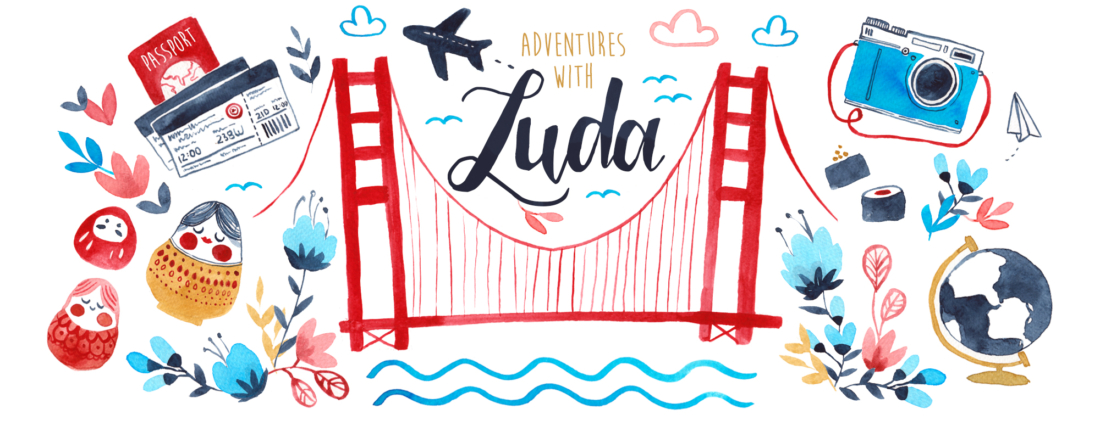
17 BOSNIA & HERZEGOVINA TRAVEL TIPS: What to Know Before You Go!

The Balkans are quickly becoming a trending destination for intrepid travelers, with some countries — like Serbia , Croatia, and Montenegro —becoming the most popular destinations.
Which is fantastic if you plan to visit them, but not so great if you want to travel to places that are more off the beaten path, such as Bosnia and Herzegovina!
When we planned our trip to BiH, I was surprised at the lack of blog posts and articles, especially on destinations that are outside of the capital, like Blagaj or Jajce (two of my new favorite places!)
After traveling around the country for a month, checking out all the awesome attractions, and making a few mistakes along the way, I decided to write this mini resource for those who want to travel to Bosnia and Herzegovina but don’t know where to start.
These Bosnia and Herzegovina travel tips include everything you need to know, from money to safety, customs, transportation, accommodations, and other interesting tidbits of information. In a nutshell, these are all of the things to know before visiting Bosnia for the first time.
Ready? Let’s check it out!
1 – There’s no war anymore…
Before we get started with everything else on this list, let’s get this (very important) fact out of the way first.
Unfortunately, the first thing that many people associate with Bosnia and Herzegovina is the war that happened right after Yugoslavia fell apart in the mid-1990’s. You may have heard about it, seen the Yugoslav Wars on TV, or even read about it in your history books .
However, the war was finished quite a while ago — at the end of 1995! — and it is completely safe to travel to Bosnia and Herzegovina.

3 – Waterfalls, ski resorts, lakes, and more!
Speaking of nature… Bosnia and Herzegovina i s one of the most up-and-coming tourist destinations, especially for those who love nature.
If you’re still planning out your itinerary, check out one (or all!) of these amazing natural destinations in Bosnia:
Jajce — Waterfalls that are contenders for a UNESCO World Heritage Site
Blagaj — A Dervish house nestled next to a spring and, arguably, one of the most beautiful places in Bosnia
Počitelj — Just a quick drive from Mostar is this historic open air museum / village, featuring Ottoman architecture and stunning views along a karst
Bihać — Located on the banks of the Una River, Bihać is full of resorts and activities in nature
Neum — The only coastal town in BiH, Neum packs a lot into its 20 km (12 mi) of coastline
Jahorina — Nestled above Sarajevo, Jahorina is the most popular ski resort in the country and even hosted the 1984 Winter Olympics!

4 – A Very Easy Conversion
Psst… Want to know a really easy life hack? 2 KM is 1 EUR :)
The Bosnian Convertible Mark (shortened to KM) is officially pegged to the Euro to make it easier to keep track of currency exchanges.
However, the Euro is widely used in restaurants, shops, and hotels all around Bosnia, so it doesn’t hurt to ask if you can pay in EUR if you’re running out of KMs.
Now you’re ready to go out there and buy souvenirs without having to do a bunch of mental math!
5 – Your Credit Card Will Collect Dust
Since we’re on the topic of currency, I’m going to be honest and say that Bosnia and Herzegovina is the country where I used my credit card the least.
This is especially true in most cities outside of the capital (Sarajevo), as well as Sarajevo’s Old Town. Interestingly enough, there were a handful of restaurants (outside the Old Town) and a majority of grocery stores that took my credit card.
Before you travel to Bosnia, I highly highly highly recommend taking plenty of cash (such as USD or EUR bills) to exchange into KM or signing up for a card that has no foreign ATM fees (like Charles Schwab!) and taking out money when you arrive.

6 – Be Careful of Cash Only Accommodations
This is slightly related to what I said about the ‘cash only’ policy above, but it’s so important that it needs its own point :)

The easiest way to check if a place is cash-only is to scroll all the way to the bottom of Booking.com and under ‘House rules’ it’ll note the payment policy of the property. Typically, the majority of guesthouses and apartments are cash only, while hotels can be hit or miss.
Looking for credit card-friendly accommodations? Check out Ibis Styles , Astra Old Town , Hotel President .

7 – Book Activities Ahead Ok ok, one last point about cash before you guys start rebelling in the comments
If you’re low on paper bills or have high ATM fees yet still want to learn about the country, I highly recommend booking all of your tours through an online marketplace like GetYourGuide. We did this with our day trip to Jajce and were so glad that we did!
Here are some of the top tours in Bosnia & Herzegovina:

8 – The Country with the Three Presidents
And now for something completely different (and, frankly, a little wild). 😌
One thing that I was surprised to learn about Bosnia & Herzegovina is that it has three presidents.
Yes, you read that right: there are three official presidents in the country! And no, I’m not trolling you — here’s the official Wikipedia article so you can see for yourself.
Each constituent group in Bosnia & Herzegovina — Bosniaks, Croats, and Serbs — picks one president to represent them for four years.
But Luda, how can anything get done with three presidents in power?
To which I reply, dear reader: Does anything really get done with one president in other countries? (Joking, joking)
While I’m not a political commentator and can’t go into much detail, our Jajce tour guide (see #7 above) said that the presidents rotate every couple of months. Isn’t that interesting?

9 – Bosnia and Herzegovina is Rich in Diversity and Religion
Since we’ve touched a bit about the demographics of Bosnia and Herzegovina, let’s dive a little further!
Like I mentioned, Bosnia is very diverse, especially when you consider that about 50% of the population are Muslim, 30% are Eastern Orthodox, and 15% are Catholic.
In fact, it’s not surprising to see a mosque and a church on the same block.
The country also tends to celebrate holidays from all three religions, including Ramadan, Christmas (both on December 25 and January 7), and New Years. If you’re visiting during a holiday period, be sure to check out the Sarajevo Ramadan Festival or the Sarajevo Holiday Market (an open air Christmas market similar to those in Europe).

10 – Apartments, Hotels, or Guesthouses?
Just like other Balkan countries (such as Montenegro ), you’ll see a lot of guesthouses, apartments, and B&Bs (bed and breakfasts) being offered as a form of accommodation.
In fact, you’ll most likely stay in one!
This is because big chain hotels haven’t made their way to Bosnia & Herzegovina yet (unless you count the Swissotel or Courtyard by Marriott in Sarajevo). However, the demand for a place to stay has gone up in recent years, which is why there are dozens of smaller independent hotels and short-term rentals.
Budget-friendly travelers can save some money by opting to reserve an apartment or a room in a guest house (versus a hotel). Another bonus is that guesthouses typically offer complimentary breakfast, while apartments have all of the convenient amenities of a typical home (such as a kitchen or washing machine — perfect for long-term travel!)
Still didn’t book an accommodation in Bosnia? Check out my 25 Unique Hotels in Bosnia & Herzegovina blog post or see popular hostels , guesthouses , and apartments here!

11 – Don’t visit Mostar…
… on a day trip ;)
Although it’s only a 2-hour drive from Dubrovnik (Croatia), Sarajevo (Bosnia’s capital), or 3 hours from Kotor (Montenegro), Mostar really deserves more time than just a few hours of your time.
There are two reasons why: first, the day trippers usually leave by evening, which means you can explore the city without the hordes of crowds. If you’re an early bird, you can also wake up around sunrise and have Mostar’s most famous attractions (including the Old Town and Stari Most) all to yourself!

12 – Did You Know That Bosnia Has One of the Most Beautiful Train Rides in Europe?
While we’re on the topic of Mostar, I have one last tip for this region.
If you’re planning to travel to Mostar, I highly recommend doing the trip via the Sarajevo to Mostar route (or vice versa). That’s because this route has one of the most beautiful (and underrated!) train rides in Europe. Although the tip is only 2 hours long, you’ll get to see emerald green rivers, cute little villages, and lush mountains peeking behind lush forests.
Bonus: the train (sometimes) has WiFi, although I’m sure you won’t need it with views like the ones mentioned above. :)
If the train doesn’t work out, there’s also the Sarajevo to Mostar bus, which is slightly longer (2.5 hours) but has very similar views.
Planning a trip between Sarajevo to Mostar? Check out my in-depth guide here , including train and bus timetables, rental car tips, and more.
13 – Coffee is an Important Ritual in Bosnia — Here’s How to Properly Drink It!
Did you know that Bosnia & Herzegovina is the 11th most coffee consuming nation in the world? That’s right: each citizen drinks about 6.1 kg (13 lb) of coffee per person per year, and drinking coffee is considered to be a time-honored tradition that spans centuries!
Although the coffee is similar to that of Turkish coffee, locals would argue that the method is slightly different (and the taste is better, but that’s up to you to decide!)
Bosnian coffee is typically prepared by adding hot water and ground coffee to a džezva (a special pot with a high neck and handle ) and boiled until the foam starts to rise. Then the džezva is taken off the heat so that the foam goes down, put back on the burner, and repeated two or three more times until it’s ready!
When ordering Bosnian coffee, you’ll typically get the following items, all neatly placed on a plate: The džezva with coffee, small cups to drink from, a container with sugar cubes, glasses of water, and often something sweet (typically a cube of rahat lokum ).
Now you’re probably wondering, Ok, this looks delicious… but what’s the proper way to drink Bosnian coffee?
There are a few ways, but the most common is to take a little foam from the top of the džezva pot and pour some coffee into your cup, while adding the scooped foam at the end (the foam gives it that little extra kick!). Most locals will take a sugar cube and either put it under their tongue, or take small bites between sips.
However, no matter how you drink your Bosnian coffee, there’s one very specific way not to drink it — don’t drink the coffee sludge at the bottom of the džezva, or else you’ll get a mouthful of very bitter grounds!
Since you might also be interested in where to find the best coffee in Bosnia, I’ve compiled a few of my favorites in Sarajevo. I recommend starting at Caffe Bar ANDAR , as they include a little instruction manual on how to properly drink Bosnian coffee. It also has a very interesting history that’s reflected in its interior decor and atmosphere. :)
Ministry of Ćejf is another great cafe that’s just a minute away from the center of Baščaršija and offers delicious desserts in addition to great coffee. If you’ve fallen in love with Bosnian coffee and want to buy your own džezva, I highly recommend going across the street (to Kovači 19) and buying it from Nermina, a female coppersmith who makes gorgeous works of art!
TRAVEL TIP: If you’re traveling to Tranvik, be sure to stop by Lutvina Kahva. Besides the beautiful setting next to a waterfall, this cafe has a very interesting house special — Bosnian coffee with a cigarette on the side!

14 – Interesting local words If you’re like me and love learning local phrases or untranslatable words (*ahem* Hygge ), then you’ll have a great time in Bosnia. The whole language is full of beautiful expressions and melodic words! Here are some of my favorites:
Cejf — Remember the Ministry of Cejf cafe above? This word means an (enjoyable) quirk or habit that you have that must be done in a specific order. For example, if you have a particular way of making the perfect cup of coffee or any traditions that you have while flying (mine is the typical Russian superstition of sitting on my luggage for a few minutes before heading to the airport!)
Sevdah — feeling of longing for someone or somewhere, but with a hint of melancholy. This is also similar to the word toska in Russian.
Fajda – Something useful
Merhamet (male) / merhametli (female) – A person who has an aura of kindness
Rahatluk – A state of being happy and carefree
Sikteruša – Literally, ‘Go away coffee.’ This happens when an unwelcome guest comes and you make them coffee (to be polite), but bad-ish coffee so they leave earlier.

15 – Souvenirs to buy
Traditional rug – If you’re into art and beautiful centerpieces, then you’ll love Bosnia’s traditional carpets. The carpet style is called kilim and have bright colors, geometric patterns, and ornate designs in a variety of different sizes.
Bosnian coffee set – If you fell in love with Bosnia’s coffee culture, why not buy yourself a set to make a cup at home and impress your friends? A typical set includes the džezva (coffee pot), sugar holder, cups (typically two to four, although you can ask for more), and a platter to hold it all.
You can find copper coffee sets sold in nearly every big city, but be careful: not all of the sets are hand-made by local artisans, and there are many cheap knockoffs that were made in factories overseas.
If you want to support Bosnian coppersmiths, I recommend visiting the Kovači ulica (which literally translates to Blacksmiths Street) in Sarajevo and buying from there. I had the pleasure of making a džezva from scratch with Nermina, the last female coppersmith in the city. Her shop is located at Kovači 19 and, besides making beautiful copper goods, she’s very friendly and has a lot of interesting stories (she created the flame torch for the European Youth Olympics recently!)
However, there’s no point of having a coffee set if it’s missing the key ingredient: coffee! Which is a good transition to the next gift…
Although there are a handful of great coffee brands sold in Bosnia, our guide’s favorite was Zlatna Dzezva (which, coincidentally, is the most popular brand in the country). However, I also saw Franck Jubilarna and Grand Gold Kava on shelves as well.
Other popular Bosnian souvenirs include hand-knitted socks , a zvekir motif (the large metal door knocker in traditional Bosnian homes), and local jewelry .
If you’re planning to travel around the country, you’ll be surprised and delighted at how many local specialties there are — which, by the way, also make fantastic souvenirs! For example, the town of Konjic is one of the oldest settlements in the country and famous for its traditional wood carvings. There are a handful of local artisans who make beautiful craft from wood.

16 – Europe’s Last Rainforest
Did you know that Bosnia has o ne of the biggest (and last) rainforests in Europe?
It’s true! Perućica Forest Reserve, located in southeastern Bosnia & Herzegovina, has an area of about 3,500 acres and is part of the larger Sutjeska National Park. It’s so unique that even UNESCO added Perucica to its tentative list of World Heritage Sites!
There are so many interesting facts about Perucic: it’s home to the 98 meter-high Skakavac Waterfall, the highest waterfall in the country (and second-highest in Europe!), as well as nearly 200 species of trees and 1,000+ species of plants, many of which are native to the area.
However, what really surprised me was that in some parts of the forest, it’s almost impossible to walk through due to the overgrown plants and bushes and can only be done so with an experienced tour guide or ranger.

17 – Mostar Bridge Divers
I’ve covered practical basics and useful travel tips, from transportation to accommodations, money, and what to see on your trip to Bosnia and Herzegovina, so I’ll leave you with an interesting tidbit for this last point.
You might have heard of the Old Bridge in Mostar — or are planning to visit it! — but did you know that it has one of the oldest traditions in the country that’s still practiced to this day?
Back in the 1600s, local boys would jump off the bridge and into the water below as a rite of passage, and those who couldn’t would be a failure in life (pretty harsh, no?)
Although nowadays this rite of passage isn’t enforced, there are still professional bridge divers that make the 20-meter jump almost every day.
Typically, Mostar bridge divers wait until they draw enough of a crowd (and around 50 EUR in tips) before they’ll perform their famous dive. Depending on the season, these bridge divers can make multiple jumps in a day!
What’s more, adventurous travelers can try out bridge diving for themselves — all you need to do is make an appointment at the bridge diver’s club right next to the bridge, pay the fee, do a few practice runs, and voila! After you successfully do the jump, you’ll get a certificate and have your name recorded in the club’s record book. :)
Photo Credits: Mine warning sign – Julian Nyča | Bosnian money – Tyler Rossi | Perucica Forest – 00cska00 (Wikipedia) | Hotels – respective hotels
Related Posts
2 thoughts on “ 17 bosnia & herzegovina travel tips: what to know before you go ”.
Local words written here tend to be of Turkish origin (or Arabic origin that came into Bosnian through Turkish). Sikteruša in Bosnian does mean “go away coffee”, but the part “go away” or “sikter” in Turkish means….well it is more like “get the F outta here”-you know what F stands for. It’s somewhat tamed around there :)
Ahh you’re right! I’m learning Turkish right now and I can’t believe I didn’t make the connection 😅 Thank you for that insight!
Leave a Reply Cancel reply
Your email address will not be published. Required fields are marked *
Notify me of follow-up comments by email.
Notify me of new posts by email.

Bosnia and Herzegovina Travel Guide for First Timers
By: Author Betsy Wuebker
Use our Bosnia and Herzegovina travel guide for first timers for ideas and context. Our trip to Bosnia made it one of our favorite destinations.
So there we were, catching an airless bus out of Dubrovnik . Rumbling toward a place called Neum on a tiny finger of territory 20 kilometers long. This is the spit which gives modern-day Bosnia and Herzegovina its legal access to the Adriatic sea. We didn’t know what to think.
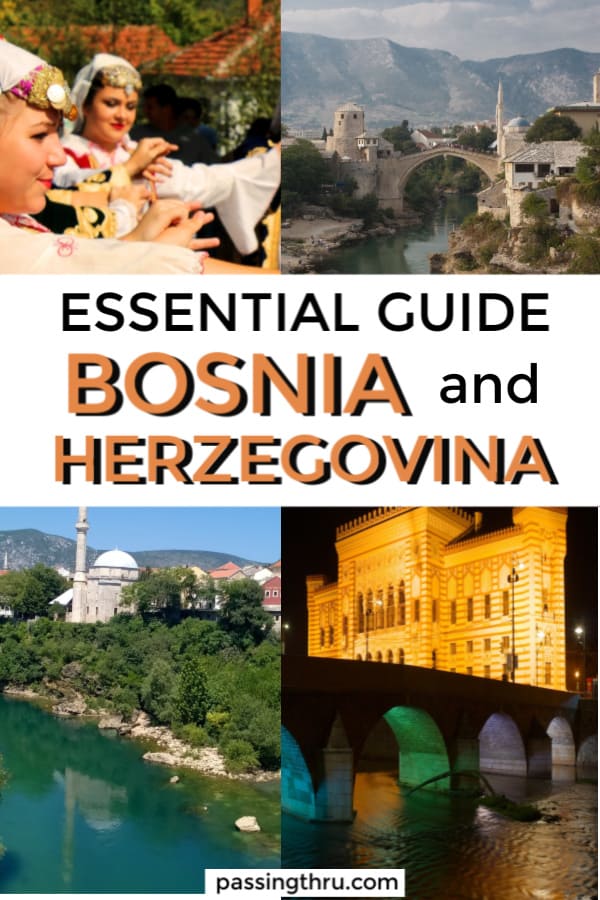
When they heard we were going to travel to Bosnia and Herzegovina, some people thought we were nuts. (Nothing new there.) Others asked if our Bosnia travel plan really was “safe.”
When we got there, at least one Bosnian wondered why we came at all. Apparently, Bosnia and Herzegovina trips aren’t all that common for Americans. But now that we’ve been, we want to return. This Bosnia and Herzegovina travel blog post will help you understand why.
This article contains affiliate links and/or references to our advertisers. We may receive compensation when you click on or make a purchase using these links.
Table of Contents
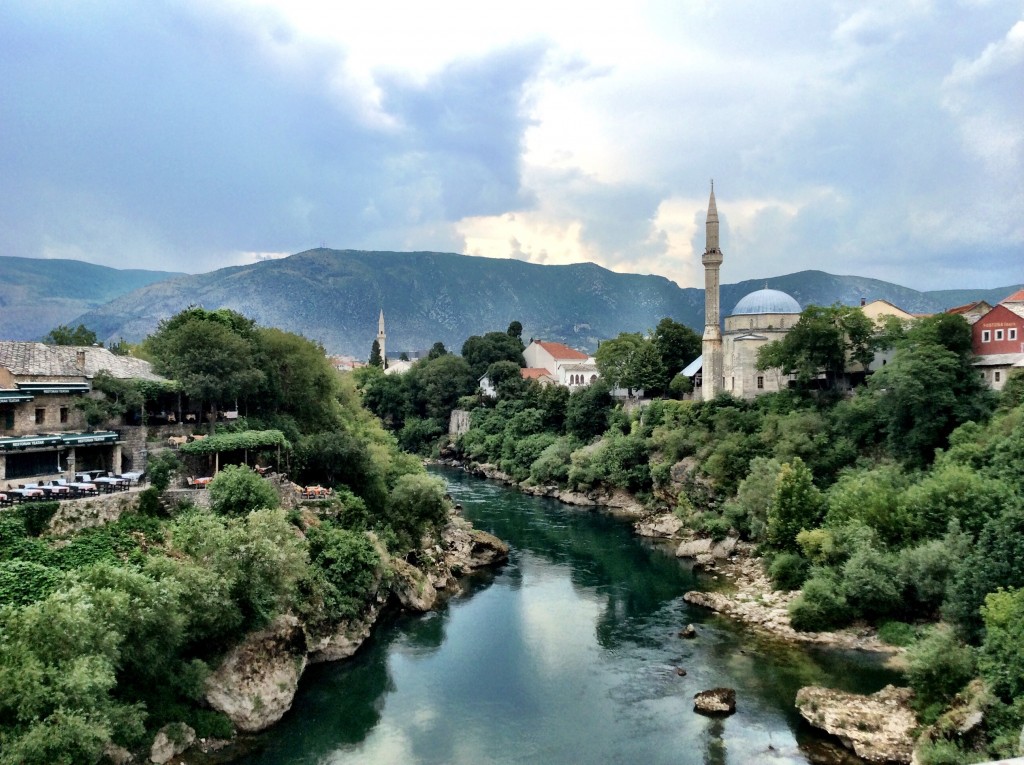
Ten things we couldn’t leave out of our Bosnia and Herzegovina Travel Guide for first timers:
1. getting in and out might seem a little difficult, but it’s really nothing to worry about..
As it turned out, we had a lot of time to think during our trip to Bosnia and Herzegovina. Getting in and around this part of the former Yugoslavia, and then out, takes a while. If you’re planning to travel to Bosnia, we recommend going by surface, actually.
Note: If you are planning a day trip from Croatia to Bosnia, check out my post Dubrovnik to Bosnia Day Trip: Easy Planning Guide
There’s always something better about an approach at ground level, seeing your destination mirage in the distance, drawing nearer to the moment when outskirts give way to the reality of place. It beats dropping in from the sky to have a look around and then jumping back out.
Be ready for thorough border processing at border crossings. You will be perused and your documents will be scanned a couple of times – coming out of wherever you came from and coming in. If you’re self-driving, be prepared for a much longer line at the checkpoints than if you’re on one of the international buses.
We just bought regular public transport tickets to Mostar at the Dubrovnik station. Online ticketing? Sorry, not available at that time. Mostar to Sarajevo? Same deal, pay in cash at the station in Mostar. Buses are frequent, amenities are hit and miss. Announcements we couldn’t understand were kindly translated by fellow travelers. Yep, they could probably tell by looking at us that we might need a little extra help. We felt rather solicitously cared for, as Americans of a “certain age.”
If you want a cushier experience getting to and seeing Mostar, you might want to sign on for a tour, particularly if you are coming from Croatia. Because this destination is one of the top things to experience from there, you will find a variety of experiences from which to choose:
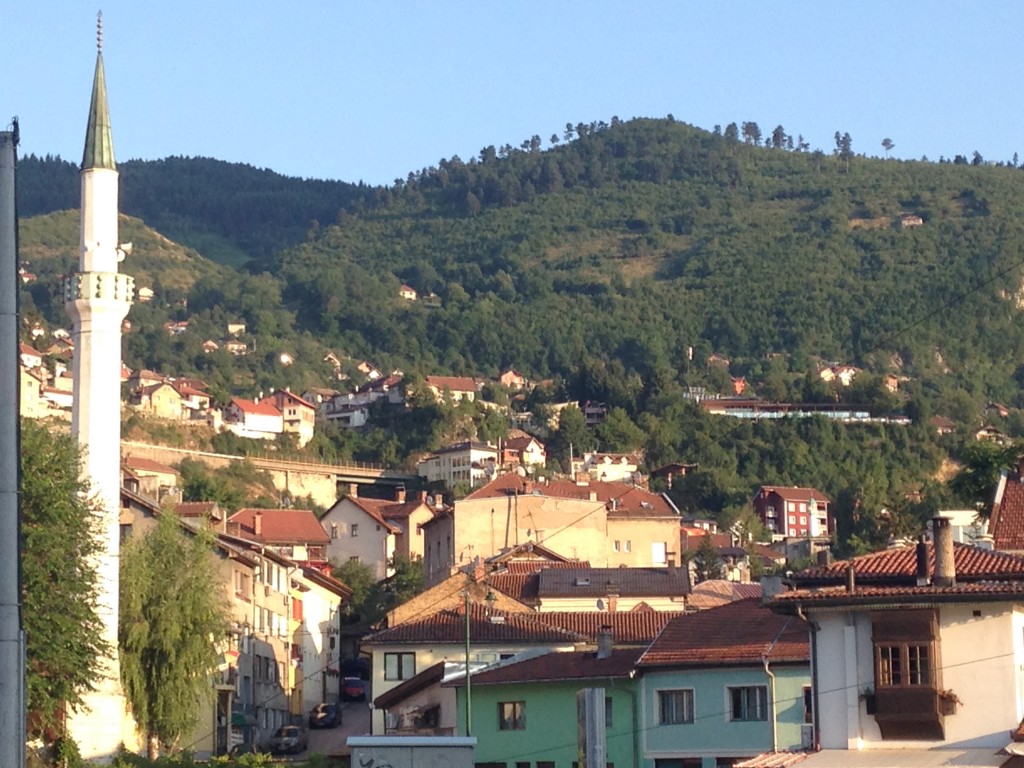
You may want to look around for alternative transport options if you’re leaving Sarajevo, as we did. An independent van company we saw in a newspaper ad ended up offering a much more comfortable, air-conditioned experience at a fraction of the price on that leg.
We just needed to be willing to accept an indeterminate departure: the van would leave when its passenger quota was filled. No worries.
We checked out of our hotel, the kind young man at the front desk made several phone calls to confirm and reconfirm departure, and ran outside to help us with luggage when the van finally did arrive.
2. There’s a difference between Bosnians and Bosniaks.
Bosnia k s are an ethnic group. Bosnia n s are a nationality. Political affiliations have historically occurred along religious and ethnic lines: Bosnian Muslims, Serb Orthodox Christians, and Croat Catholics.
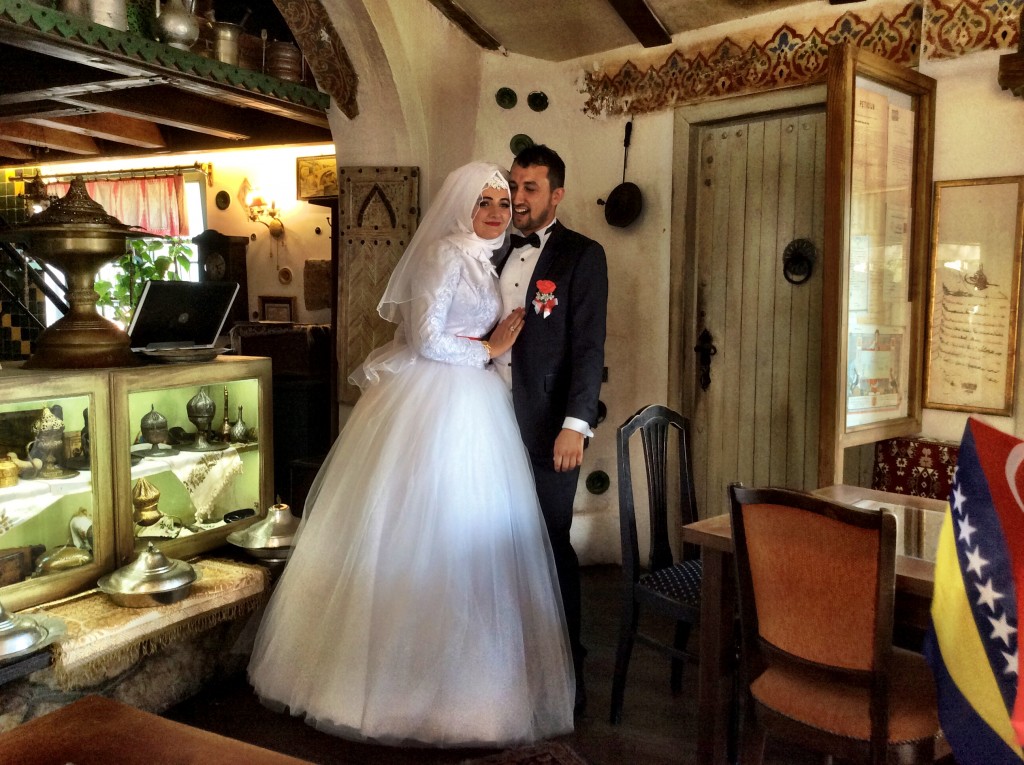
In the 1970s a political elite emerged via diplomatic service and Yugoslavia’s membership in the Non-Aligned Movement . After the death of Josip Broz Tito in 1980 and the demise of the Soviet Union, Yugoslavia’s individual nationalistic groups vied throughout the western Balkans for influence.
In the Bosnian National Assembly, ethnic tensions boiled over in a clash of attitudes favoring independence vs. remaining in the Yugoslav federation. Bosnian Serbs favored the federation, and independence was desired by Bosniaks and Bosnian Croats. This led to the Bosnian war in the early 1990s.
Today, the capital city of Sarajevo is often referred to as the “Jerusalem of Europe.” We found its multi-cultural atmosphere the most unique in all the capitals we have visited. Over the centuries, its status as a religious and political crossroads for conflict has been proven time and time again.
One of the best things to do in upon arrival is take a Sarajevo city tour. One of the Sarajevo walking tours will help you get oriented and plan your stay. Each of your senses will be impacted with the sights, sounds, and aromas of beautiful buildings, thriving outdoor markets, exotic foods and goods, and the regular calls to religious prayer.
3. Bosnia and Herzegovina may require more cash than you anticipated. Here’s why:
After World War II, when Tito and his partisans formed the Socialist Federal Republic of Yugoslavia, Bosnia and Herzegovina was one of its six constituents. Up until 1992, Bosnia was prosperous: military defense industry and multi-national corporate presence brought economic strength. An upwardly-mobile Bosnian might have worked at Volkswagen, Coca-Cola, Marlboro, Holiday Inn, or been involved with the 1984 Olympic Winter Games.
Then war devastated the Bosnian economy and destroyed its physical infrastructure. Its GDP essentially collapsed, free falling by 60%. Much of the country’s production has yet to be restored. Unemployment is close to 40%, with no sign of real stimulus affecting political and economic inertia.
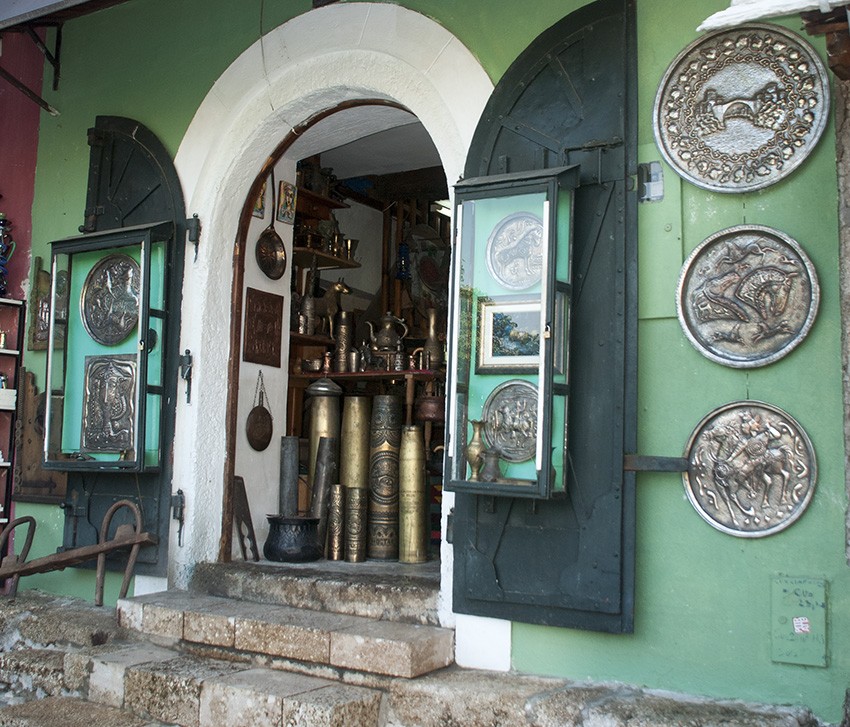
As you might expect with such conditions, there is a great deal of ingenious economic maneuvering. One of those is a free walking tour of Sarajevo. Our guide walked us through Sarajevo and revealed that while he held multiple graduate degrees in political science and diplomatic relations, he couldn’t find a job. Instead, he formed his Sarajevo walking tour company. With about 20 people in his tour that day, we estimated tips-only income might have equated to about $50 per hour. Paid in cash, of course.
We took several cash-only Sarajevo tours having discovered them only with the help of our Sarajevo hotel desk clerk. If you prefer to use a credit card and plan slightly in advance, there are variety of tours out of both Dubrovnik and Sarajevo that you can now book online .
The independent Bosnia and Herzegovina hotels at which we stayed either took only cash or had to be persuaded to accept payment by credit card. Whether this was due to an erratic banking environment or other bookkeeping-related reasons, we couldn’t say.
But it all worked out and we would not hesitate to stay again with our Sarajevo accommodation Hotel Latinski Most . Clean and comfortable, the suggestions and help from the staff are what made our Sarajevo stay superb.
Smaller businesses and restaurants were cash-only operations as well. ATMs are plentiful, and our U.S. debit cards worked just fine.
4. The scale of famous places to visit in Bosnia and distances may be different than you expect.
In the middle of Neum, our bus made a hard right, zig-zagging up and away toward Mostar. As the crow flies (across Google Maps) it’s not that great a distance between the two, less than 90km. Traffic, road conditions, and struggling uphill were bus-related challenges that led to a journey of more than 3 hours.
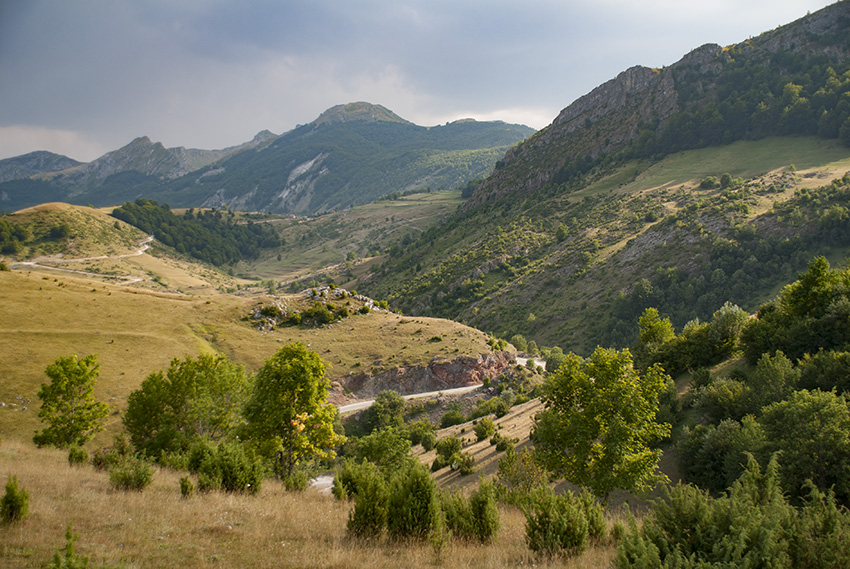
We could look across the river from our Sarajevo hotel to the place where the Archduke was assassinated . Somehow, we’d expected it to be a big plaza, where the assassins could have hidden in enormous crowds. It wasn’t; it was just a tiny nondescript little street corner with an old bridge next to it.
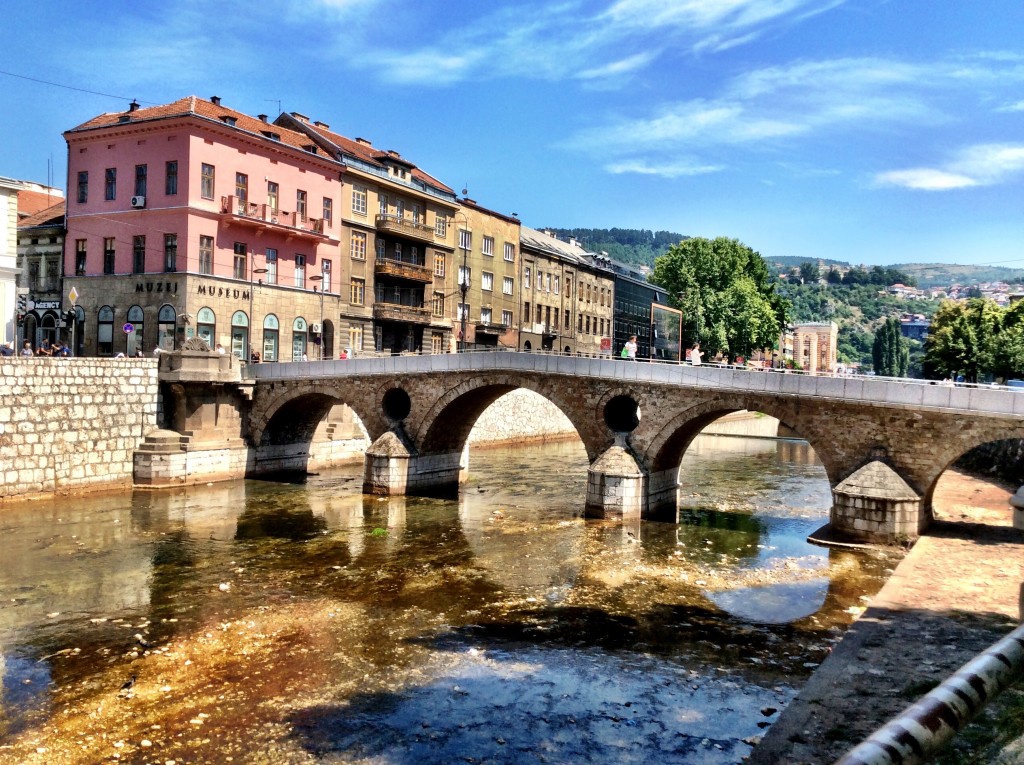
The hills from which Serbian forces fired on the streets of Sarajevo in the early 90s seemed all too close; the airport where the UN airlift off-loaded life-saving supplies is only a couple of kilometers from the city center.
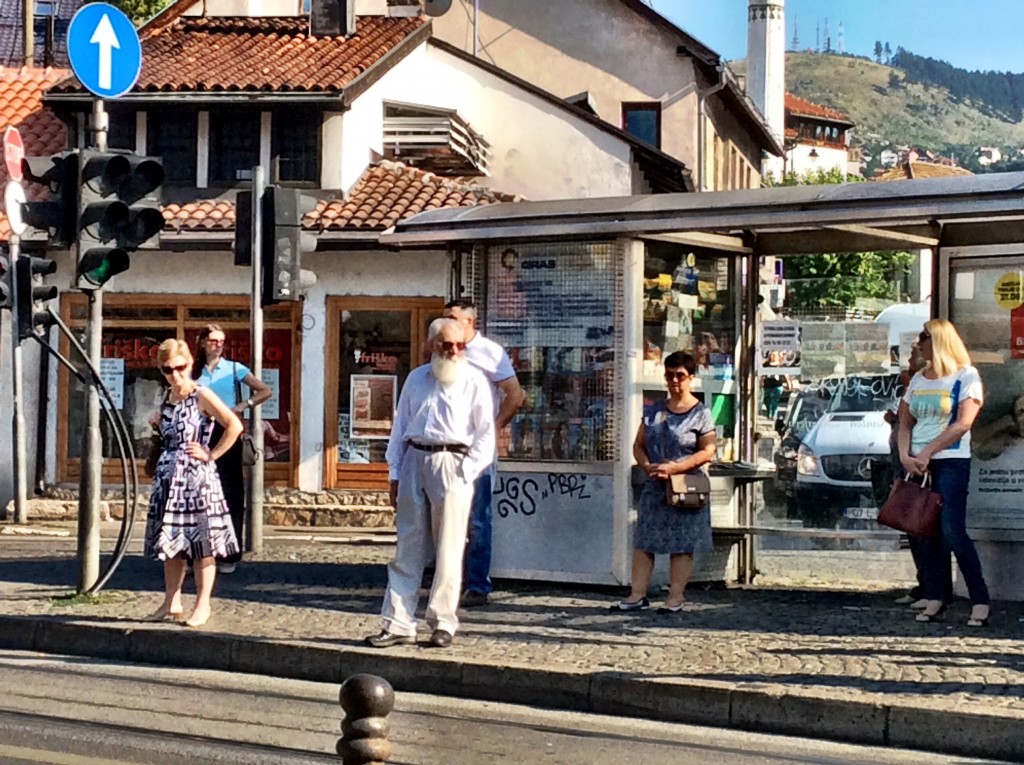
The fresh market where 68 people were killed and 200 wounded by an artillery shell , a tipping point which led to NATO air strikes, is no larger than our favorite open-air market on the island of Kauai. Sarajevo’s market was open-air then, too. Now it has a protective roof and business goes on with the memories.
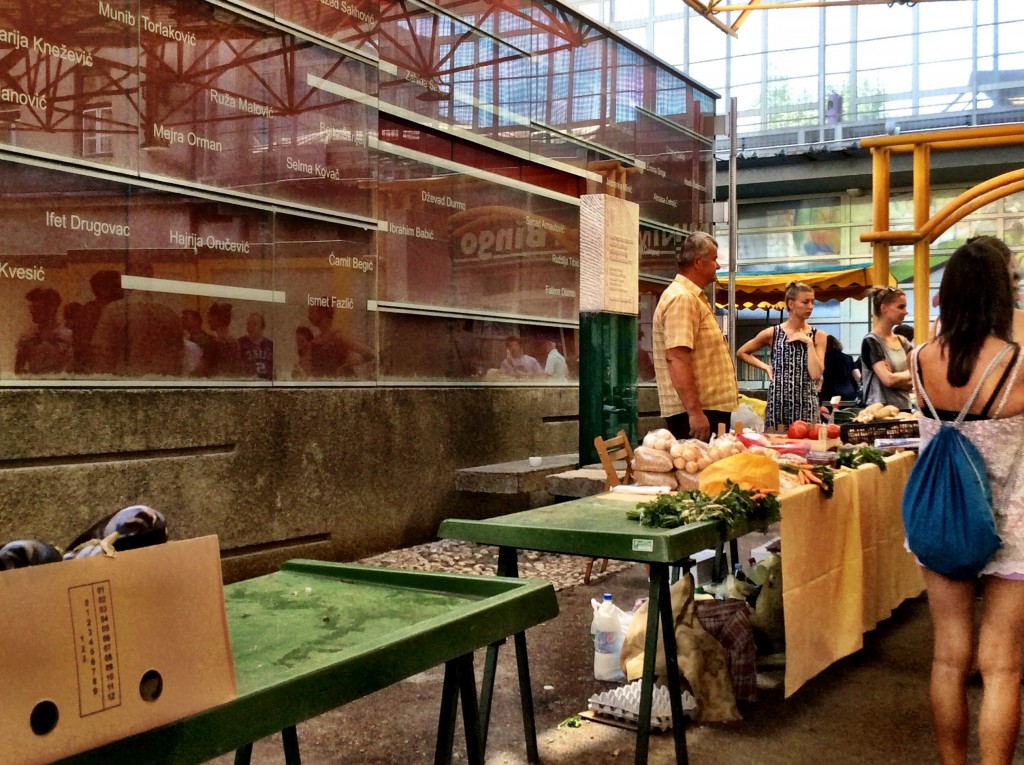
5. Is it safe to travel to Bosnia (2023)? Yes, the Bosnian war has been over for decades. That said, evidence of war is easy to see.
Now might be just the best time to visit Bosnia and Herzegovina. The war has been over for decades and the energy in the country is positive. Your Bosnia travel itinerary can be more free and flexible than ever.
Background: Between 1990 and 1992, sovereignty was declared by various entities in the region and boycotted by others. An independence referendum was held with 63% turnout and 99.7% in favor; Serb nationalists didn’t vote at all. As admittance into the United Nations became pending in 1992, tensions escalated.
Neum, the little coastal town in which our bus turned inland, took artillery fire from Serb positions in March that year. A month later, a Serb attack on Sarajevo’s peace rally is the moment that is generally agreed catalyzed open warfare between the three major ethnic communities.
Bosniak civilians were targeted in all major cities, captured and displaced by Bosnian Serb forces and sympathizers. Both Serbian and Croatian interests sought to expand their respective borders. When government-sanctioned warfare began in 1993, non-Serbs suffered civil rights violations and ethnic cleansing, such as occurred in the Srebrenica massacre. The town of Srebrenica is located in what is now known as Republika Srpska, sister entity to the Federation of Bosnia and Herzegovina.
This genocide elicited a response from the United States and the international community in the form of a NATO bombing campaign while Croat and Bosnian allies pushed back against the Serbs. In 1995, by agreement between representatives of Bosnia and Herzegovina, Croatia and Serbia, the fighting stopped, with NATO peacekeeping forces deployed and eventually peace talks restoring a fairly civil society.
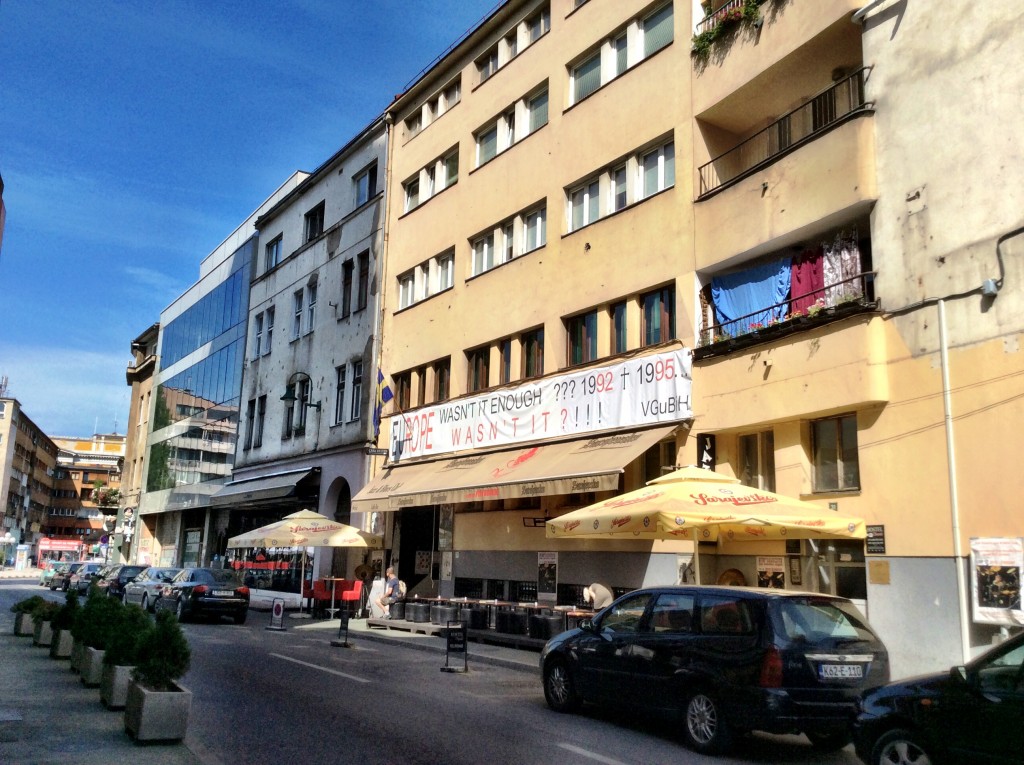
As we awaited dinner on our first night in Mostar (which is a UNESCO World Heritage Site), we picked up a coffee table-sized photography book at an adjacent restaurant table. Its images were taken during and right after the war.
The city was leveled, the beautiful Stari Most spanning the Neretva River, and the main mosque below it destroyed. The book itself was tattered, with a vintage aspect. We had to keep reminding ourselves that these events were younger than our children, whose childhoods seem like yesterday.

We sought the perspective of our two young Bosnia guides in Sarajevo, and asked is Bosnia and Herzegovina safe to visit.
The first had spent the war years, which began when he was seven years old, attending a makeshift school in the basement of his apartment building. His teachers risked their lives to get to their students. His mother walked several kilometers to work, always in high heels: she “wanted to look good if today were to be her last.”
The second had spent childhood in Vienna with relatives who took his family in when the war broke out. No one ever expected things to endure over four years.
Both young men felt it was necessary to move on from the past; both acknowledged that personal losses might prove this impossible for others. They were both glad to see more Europeans taking Bosnia and Herzegovina vacations.
While this may be the best time to travel to Bosnia in over two decades, they accepted that political opinions vary in opposite directions depending upon whom you ask. These assessments were equal parts logic and forgiveness; we were humbled and impressed.
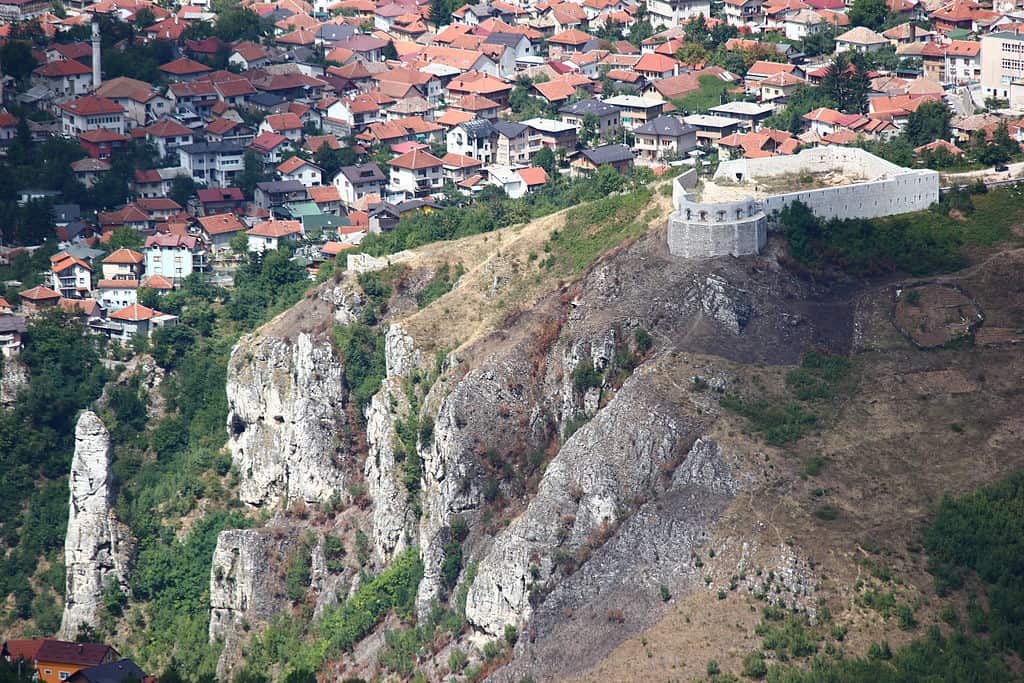
If you’re traveling to Bosnia, you may want to take a more meaningful deep dive into the war years with a guided tour which will take you to specific, prominent sites in Sarajevo. The perspective offered by your Bosnia tour guides who were personally impacted by the war will be sobering. As well, you will gain a better understanding of the issues which affect the country today.
The Sarajevo: Times of Misfortune bus tour begins with a panoramic view of the city from the White Fortress which sets the stage with background information as you go on to visit various places that figured prominently during the four-year siege. Click here for more information and booking. You might find the Sarajevo: Balkans Dark Side and War Tour more geared to your particular interests and an increased understanding. This 5 out of 5 star reviewed tour takes a somewhat different approach with Skip the Line access to the Tunnel War Museum and Vidikovac viewing points. Click here for more information and booking.
Is Bosnia and Herzegovina safe for tourists who venture off the beaten path? “Official” sources warn that visiting Bosnia can be dangerous due to unexploded land mines and other residual ordnance. No doubt this is true. Certain areas are marked off-limits with forbidding signage. We encountered none.
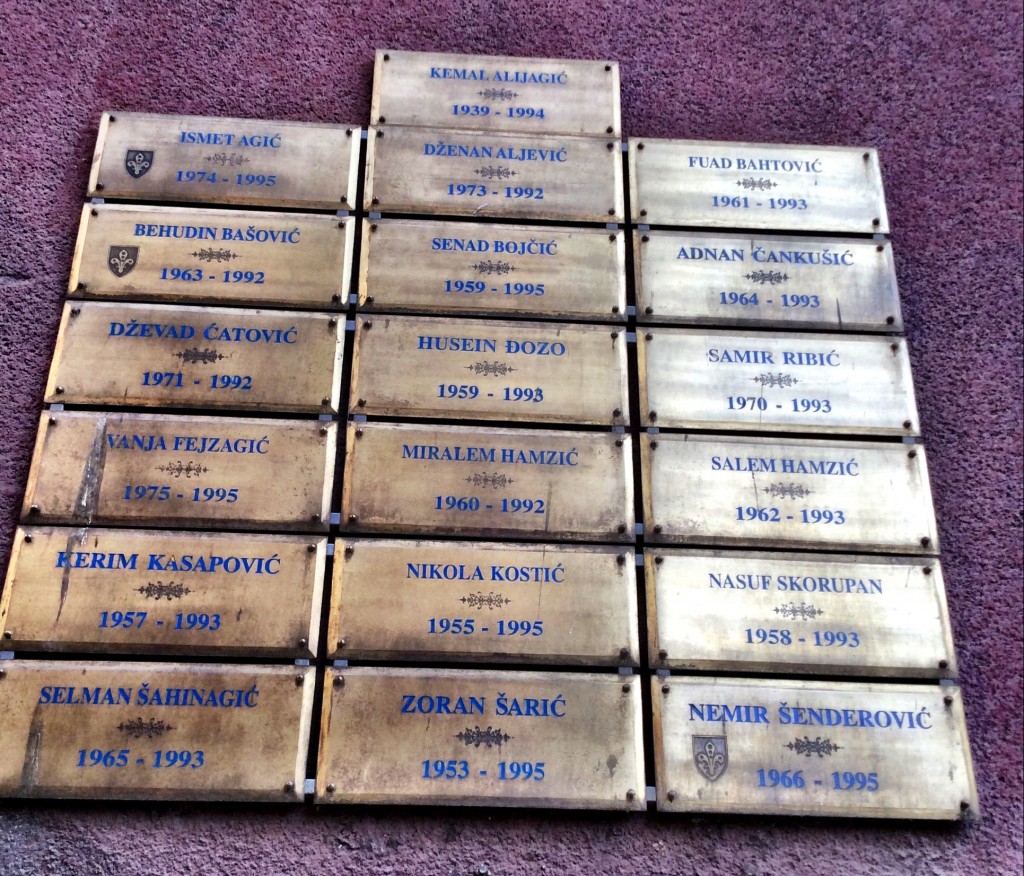
The country has had thirty years to make more highly trafficked areas safe for passage. If you stick to paved highways and urban locations when you travel to Bosnia and Herzegovina, you’ll be fine. Even our foray on dirt and forest roads into the mountains above Sarajevo where Olympic ski runs and infrastructure still serve winter sports enthusiasts was without incident or any evidence.
6. Politics in Bosnia and Herzegovina? Things have always been complicated here, and they still are.
Eastern Europe has long been the place where religions and empires intersected. Clashes and power struggles, boundary fluctuations, and regime changes since the sixth century have permeated the Bosnian identity and landscape. We were amazed how little our history classes had covered Balkan wars and significant events dating back to medieval times which had occurred in this region. As well, the influences of different religious sects and ideology – from pagan to modern Christianity and Islam – have left their mark.
Bosnia has had human inhabitants since Neolithic times. In the early Middle Ages, slavic tribes formed a confederation in this region during the first Migration Period in the 6th and 7th centuries. Roman Emperor Constantine designated Bosnia as an administrative area in the 10th century. Two hundred years later, it was formally established as a politically autonomous state within the Hungarian Crown. What followed until approximately 1391 was a series of power struggles between two prominent clans, with skirmishes and territory annexations. Following a 70 year decline, it was then annexed by the Ottoman Empire in 1463.
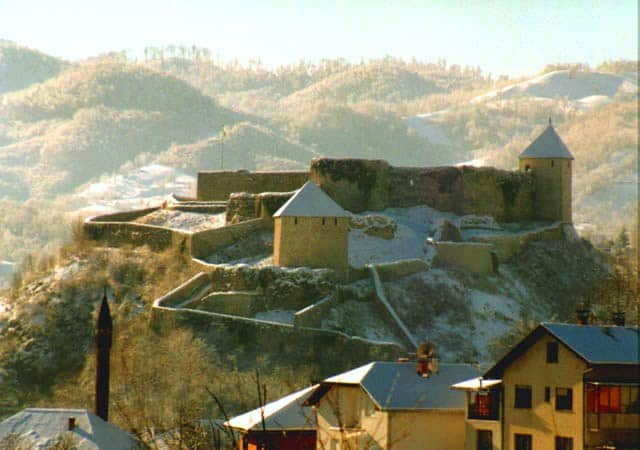
The Middle Ages are a fascinating period in this region. Thriving villages were protected by walled fortresses and natural geography. Tribal chieftains, Byzantine rulers, and Christian kings built imposing residences and added territory. Visit the medieval fortress at Tesanj, to which Bosnians refer as “the pearl of Bosnian tourism,” and the village of Vranduk and its citadel, which date to the 14th century, on the Age of Kings Tour from Sarajevo. Click here to book a day tour to Tesanj and Vranduk from Sarajevo.
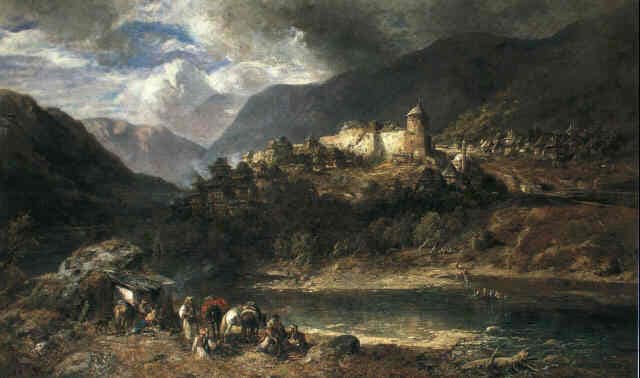
For a look at the cultural impact of ancient Muslim mysticism in Herzegovina, you’ll want to visit Blagaj. Older than Mostar, Blagaj has a Dervish monastery built around 1520, at the height of the Ottoman Empire, in a combination of Ottoman and Mediterranean style. The location is the site of an Illyrian fortress; Roman villages surrounding it were built during the Justinian era. Blagaj was an important medieval fortress and political seat during the Ottoman Empire.
Click here to get information and book a private day trip to Blagaj and the Kravice waterfalls from Mostar.
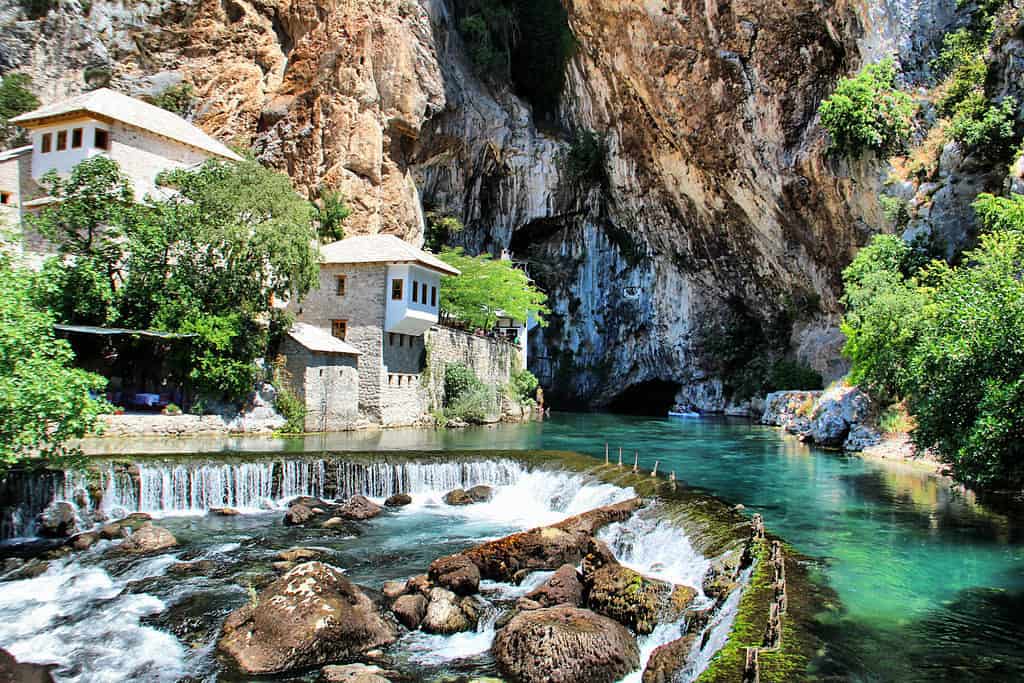
Today, there are multiple levels of political structure arising out of the 1990s war’s impact on the country’s ethnic groups. The national government is relatively weak, with decentralized decision-making in layers: geographic districts, cantons, municipalities and “official” cities. One of the main political objectives Bosnia and Herzegovina has at this time is integration within the European Union. Reforms are still in progress ahead of that affiliation.
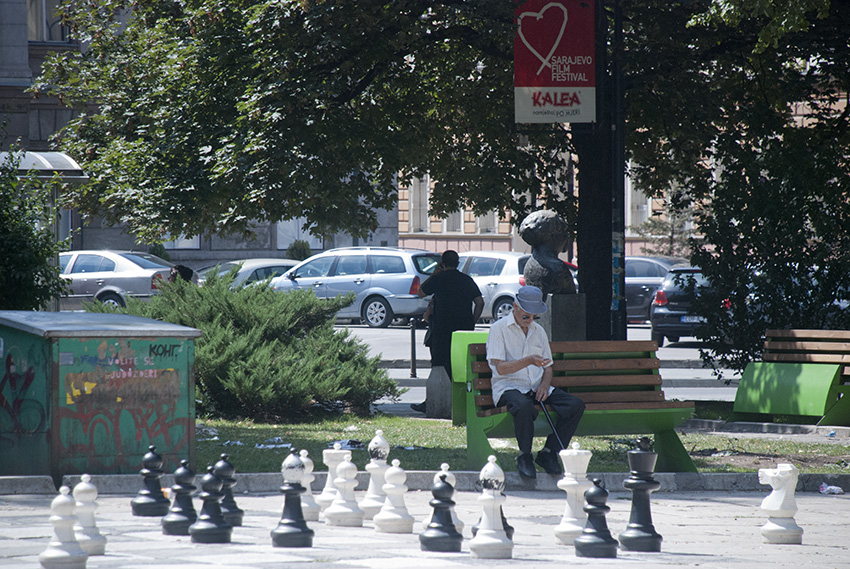
Are practicalities in daily life affected by this complexity? Definitely. Rarely, we were told, does anything get done at satisfactory speed. Sometimes, it was shared, progress is made outside of requirements. Other times, projects are indefinitely halted. We can all relate how “decision by committee” affects outcomes. This is the mire within which attempts to better and modernize the country operate under the BIH authorities.
7. You’ll enjoy wonderful Bosnian coffee, but you need to know the 1-2-3 rule.
Bosnian coffee is world famous for good reason. It’s strong, but not muddy as other regional coffees (Turkish coffee, anyone?) can be. As is common in this part of the world, coffee culture includes ritual preparation and ceremonial enjoyment.
Should you be invited in for coffee with a new friend in Bosnia you must understand Bosnia coffee etiquette – the rule of 3: the first coffee is always one of welcome.
The second coffee is brewed and poured as the signal for intimate conversation concerning whatever subject is at hand. It is during the second coffee that you and your host strengthen your bond by understanding (but not necessarily agreeing with) each other.
The third brew and serving? It’s last call. You will enjoy it together, but you also know you’ve been given the nod that once finished, you’ll be on your way.
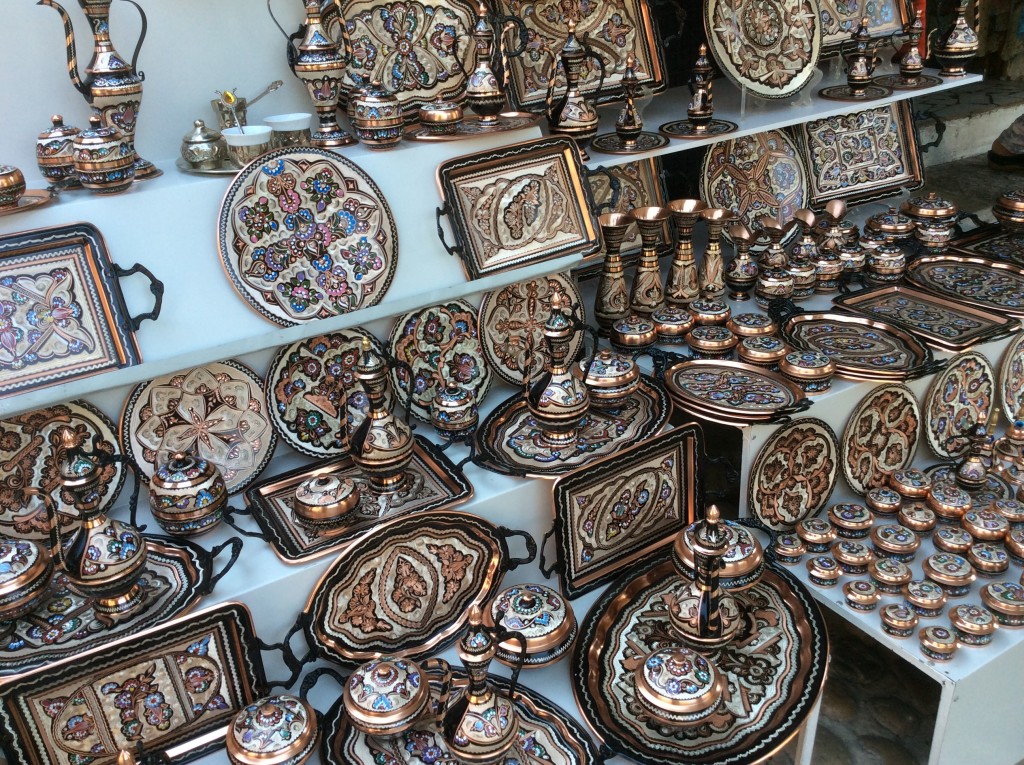
8. The local Sarajevo beer is really good.
Sarajevsko pivo has been brewed since 1864 in Sarajevo. Alert students of history will realize that the company was founded long before the decline of the Ottoman Empire’s hold over Bosnia. This disputes the notion that Islamic tradition and alcoholic beverages cannot co-exist.
Brewed with spring water from a source in the courtyard of the current building (which dates from 1893), this Sarajevo beer is a plucky little thirst quencher. We both liked it.
During the Siege of Sarajevo, citizens risked their lives under sniper fire to draw water from the brewery’s spring.
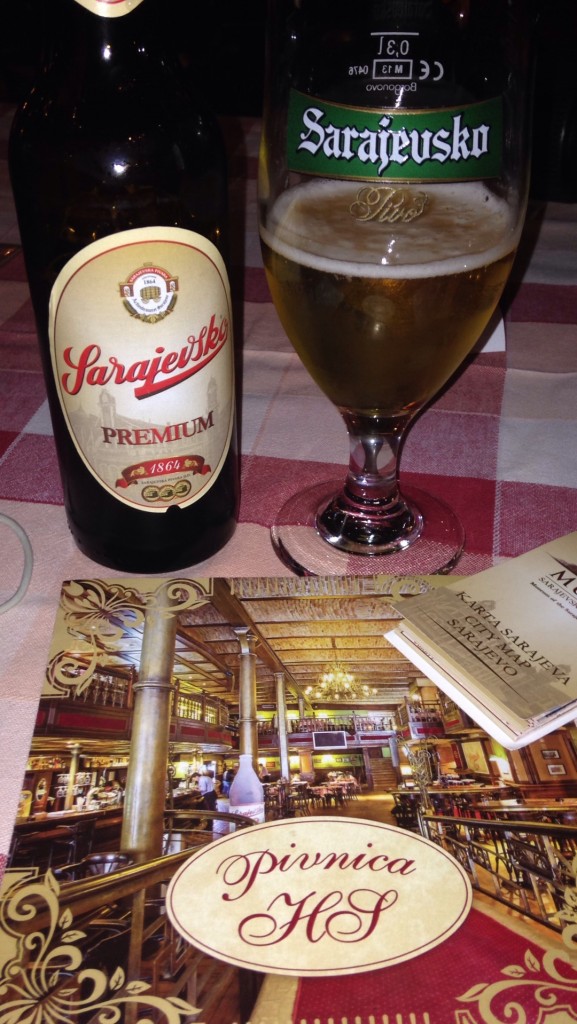
9. A trip to Bosnia and Herzegovina will convince you this is one of the most visually beautiful places in the Balkans region.
The scenery holds its own here, the country’s topography and natural beauty is comprised of a pleasing combination of mountains, hills, turquoise rivers and flatlands. Climate is Mediterranean in the south, while inland in Central Bosnia you’ll get hot summers with cold and snowy winters.
About 50% of Bosnia is forested, with wildlife such as bears, wolves, boar, deer, falcons, and the rare chamois. One of the only two remaining primeval forests in Europe, the Perucica Forest Reserve is located within the oldest of Bosnia and Herzegovina’s national parks, filled with natural resources.
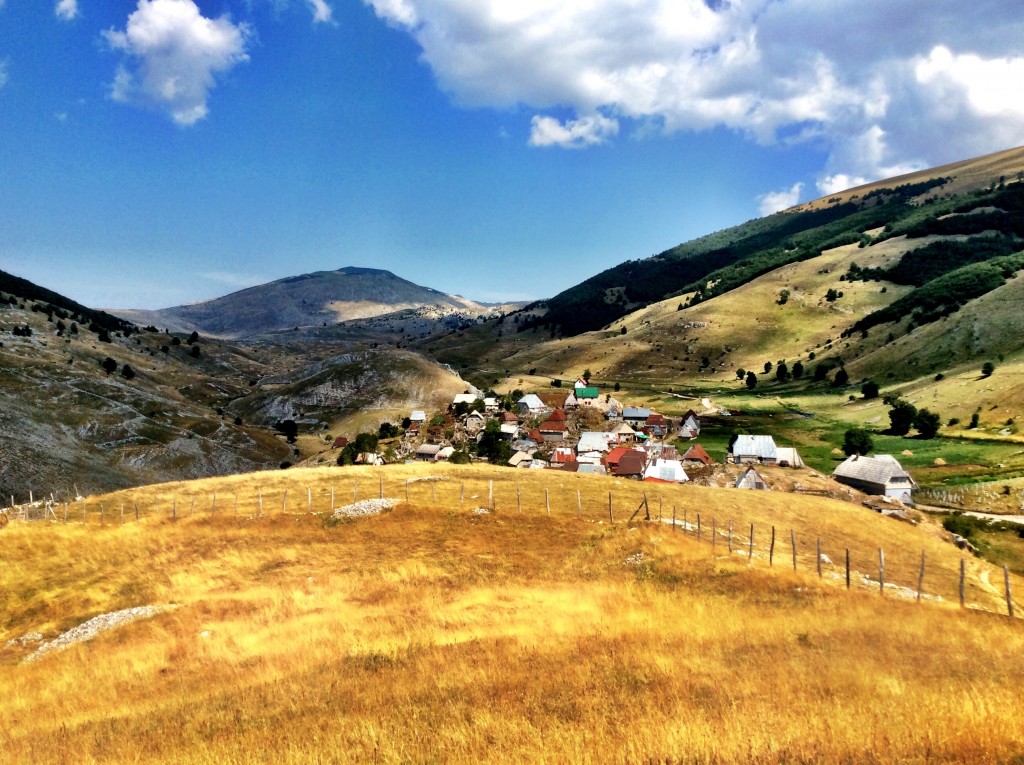
The famous Kravice waterfalls – known as Bosnia and Herzegovina’s “mini-Niagara” are a great day trip for scenic viewing, photography and swimming.
Click to arrange a private tour to Kravice from Mostar or to arrange a full day tour to Kravice from Sarajevo .
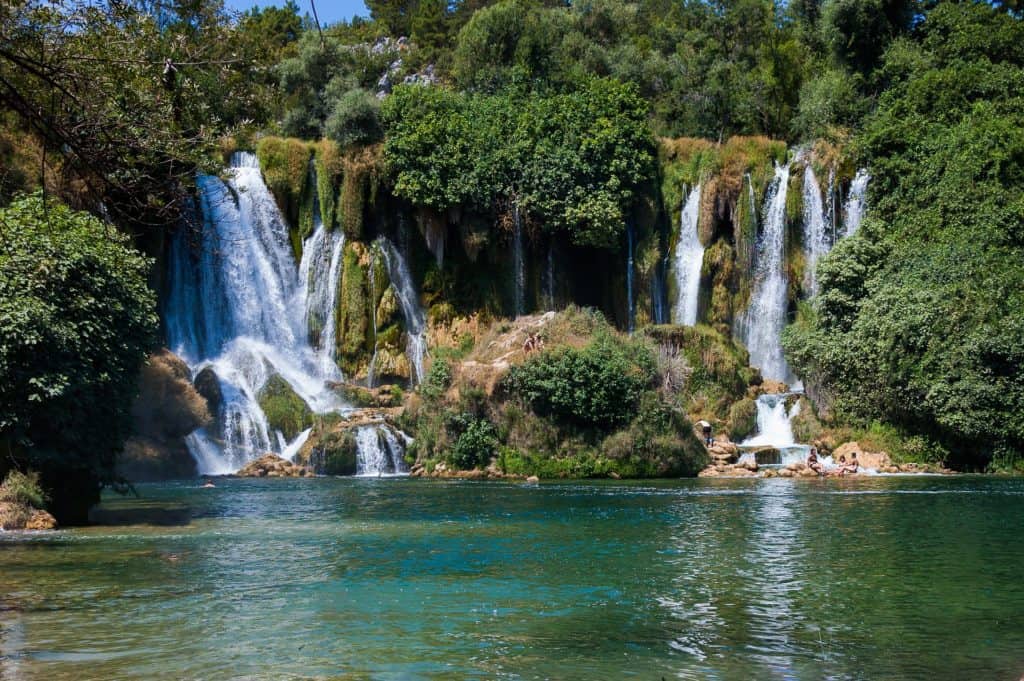
Not only is the geography scenic, but so is the evidence of man. Impossibly beautiful vistas with storybook qualities awaited us everywhere. We appreciated a meld of modern vibrancy and timelessness.

We also recognized that hardship meant the old ways might not live much longer. Our visit to Lukomir , the oldest and highest semi-nomadic village in the Dinaric Alps of Bosnia, remains one of the most memorable experiences we have had in all our travels. This is the only such village in Bosnia which was not destroyed by the Serbs in the 1990s war.
You can visit in the summer months from late May to early September, depending upon weather conditions. The village is located at very high altitude above the Bjelasnica Winter Olympics site on one of the numerous ranges near Sarajevo, so plan your attire accordingly. You will interact with locals, have a traditional meal and Bosnian coffee, and hike along the ridge of the Rakitnica Canyon, 800 meters deep.
This was our most memorable experience on our trip to Bosnia and Herzegovina. We highly recommend a tour visit to Lukomir.
Click here for more information and book your visit to Lukomir.
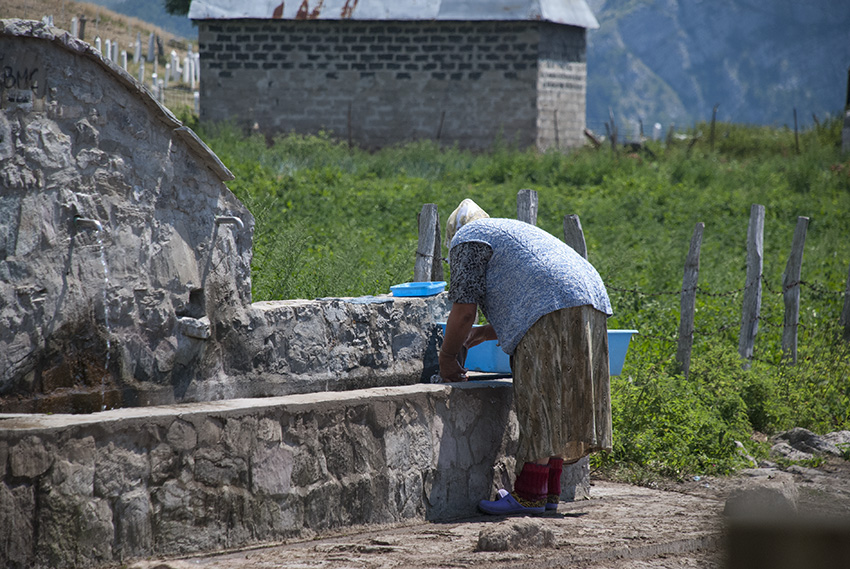
10. Your dollar goes a very long way and is very welcome. Bosnia and Herzegovina travel is inexpensive by Western standards.
Bosnia and Herzegovina tourism and ecotourism is on the rise. The southern Alpine terrain has wilderness and natural assets which attract skiers, bikers, hikers, whitewater enthusiasts and mountaineers.
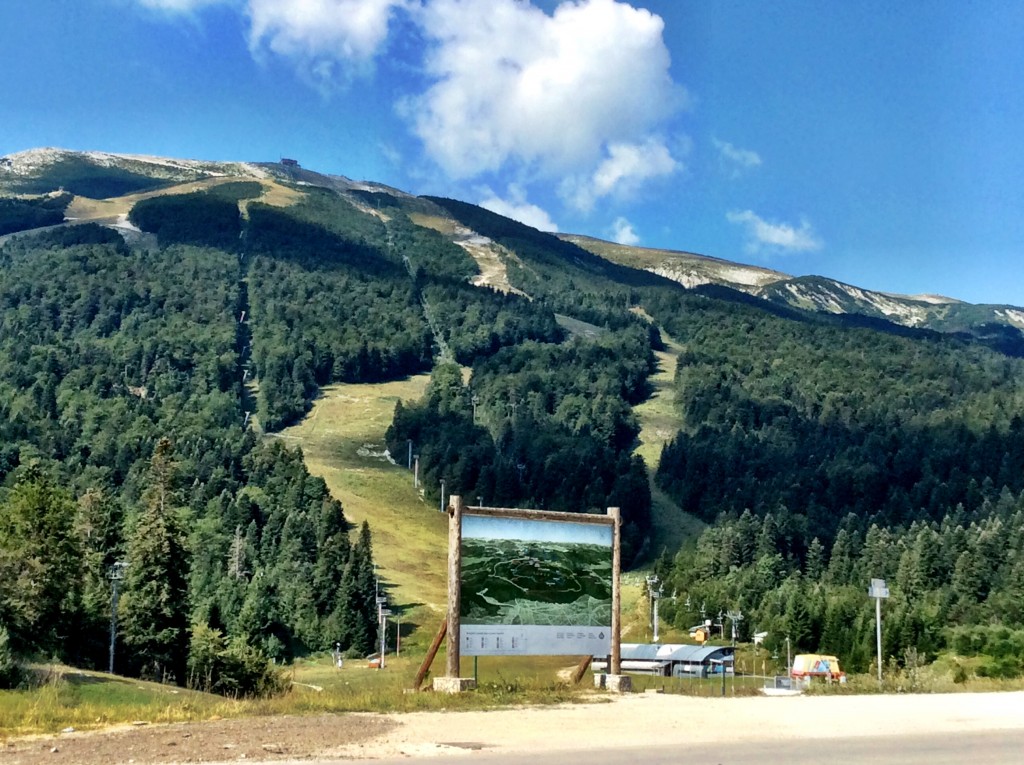
Bosnia and Herzegovina has a rich history because it has been a cultural crossroads through the centuries. This provides a variety of architectural, religious, commercial, and interpersonal perspectives. Your dollar goes farther here than in neighboring Croatia and other Western Mediterranean and EU countries.
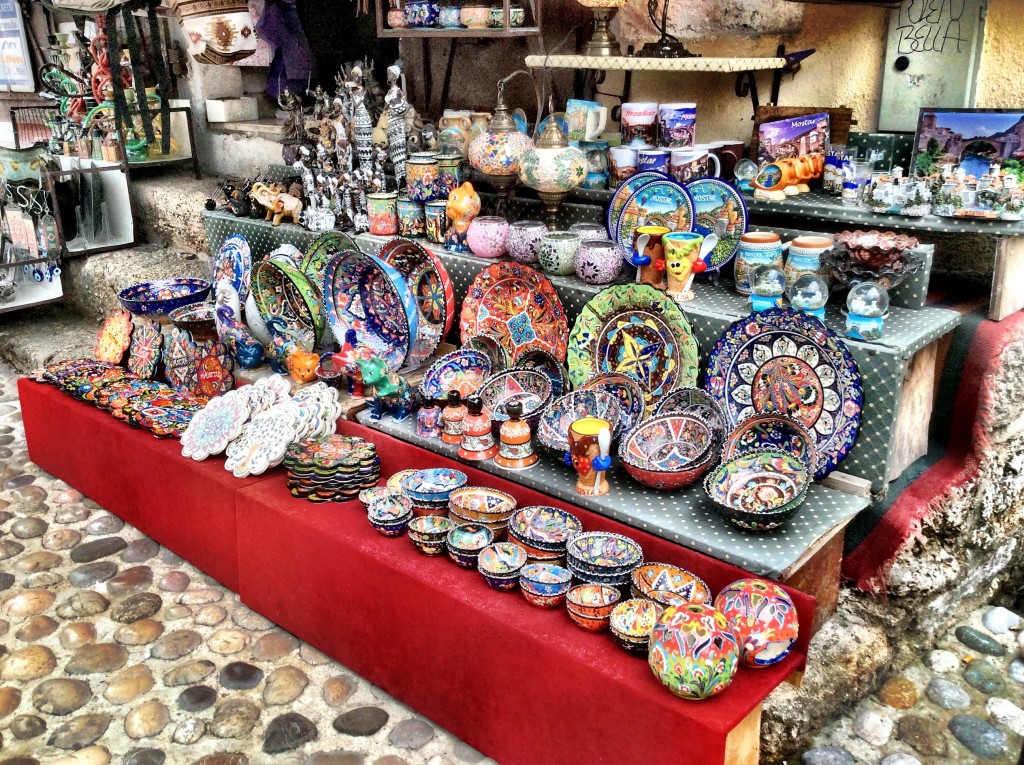
We were welcomed with open arms and a generosity of spirit, with high levels of comfort at very affordable rates. This combination made for wonderful experiences in this beautiful country. The value of Bosnia & Herzegovina travel for first timers and repeat visitors alike is highly demonstrable by any measure. Why not consider it?
Pinnable Images:
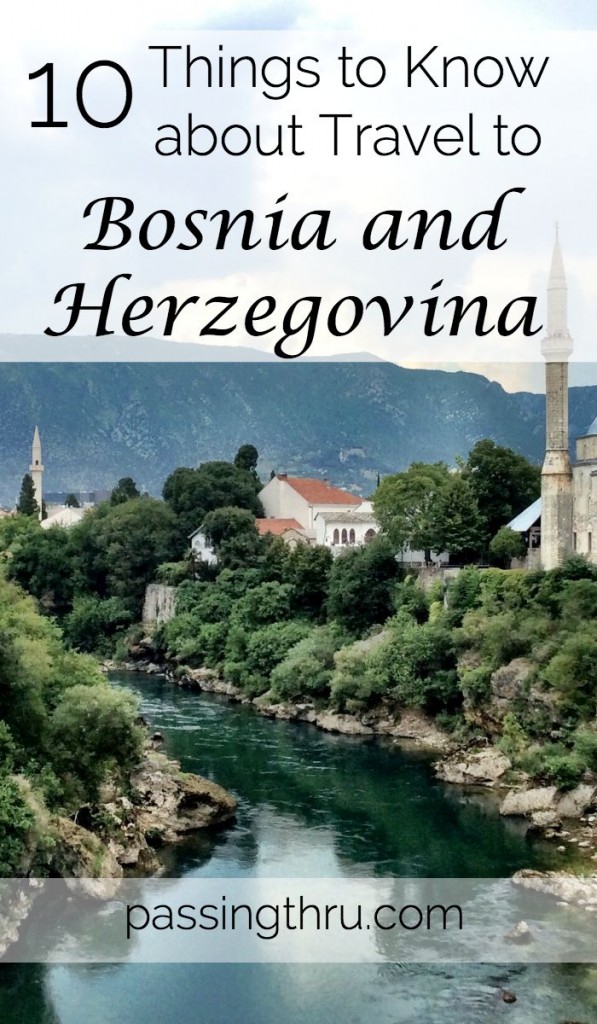
PassingThru is a participant in the Amazon Services LLC Associates Program. As an Amazon Associate I earn from qualifying purchases.
To view PassingThru’s privacy policy, click here.
Betsy Wuebker
- Senior Travel 2024 - 10 Tips for Older Travelers
- 15 Essential Steps to Explore the Solomon Islands - Discovering the Unseen
- 19 Prime Destinations for a Fabulous Tee-Total Getaway - Where Sobriety Meets Adventure
- Is it Too Late to Save the Planet?
Masud Hannan
Saturday 9th of February 2019
Yes, Best blog on Bosnia. We are planning trip this summer. Can I rent a car from say Croatia or say Austria and travel to Mostar, Sarajevo etc. Are there cross border issues you are aware of. I plan to spend Two days in Bosnia. Thanks, Hannan
Monday 11th of February 2019
Hi Hannan - Yes, it's possible to rent a car in Croatia and take to Bosnia. Check with your rental agency for details.
23 UNESCO World Heritage Sites in Europe Recommended By Travelers | Solitary Wanderer
Thursday 9th of June 2016
[…] Mostar, Bosnia and Herzegovina (Passing Thru) […]
Wednesday 20th of April 2016
Kudos to you. Your blogs are great.....by far the most informative intelligent blogs I have read . You give so much insightful information and trust me I have read hundreds and hundreds of blogs.Great job
Hi Dani - Thank you so very much.
Thursday 17th of March 2016
Mostar for me was one of the most impactful places I've ever been! The clash of cultures is impressive, but I gotta say there is a weird athmosphere going on. It seems the city is still not with peace with itself!
Hi Bruno - Interesting that you would pick up on that vibe. We did sense uneasiness, but attributed it more to difficult economy and low tourism numbers. Bosnia and Herzegovina is struggling. The benefit to travelers is that our money goes farther and our presence is very much appreciated.
International Travel Safety Don'ts - A Baker's Dozen - Passing Thru
Monday 21st of December 2015
[…] other remote areas. We spent time in two cities, and kept on the road in the mountains. Therefore, we learned other things, including the war there has been over for 20 years and people are looking to the future. Imagine […]
© 2024 PassingThru. All rights reserved.
Bosnia and Herzegovina
It is raw. It is beautiful. It is a place that requires you to adjust to it rather than it adjusting to tourists. Tim Clancy author of Bosnia & Herzegovina
Bosnia and Herzegovina has made tremendous strides in the tourism sector since 2004. It continues its ardent attempt to recover from the devastation brought by the conflict of the 1990s. To be honest, it still has a long way to go to adequately address the many challenges of catering to foreign visitors but it is a raw, real and heck of a lot of fun place to visit.
Have no doubt that this country will dazzle you with its natural beauty. This place is truly blessed with some of the most impressive scenery in southeast Europe. BiH will intrigue you with its melange of cultural heritage. Despite the conflict that ravaged the country in the early 1990s, you will find it to be a true crossroads between East and West.
Make no mistake, you will also get annoyed with the lack of road signs for certain destinations. Things like bus or train schedules will undoubtedly be changed, and it is near impossible to track them. Working hours of restaurants or attractions will not always be respected. A taxi driver just might overcharge you. Some of Bosnia and Herzegovina’s best places to see are only reachable by rough gravel tracks where you can easily lose your way. It’s just part of the trip.
That is Bosnia and Herzegovina. It is raw. It is beautiful. It is a place that requires you to adjust to it rather than it adjusting to tourists. To some that is frustrating, but to others it makes it a place of rare originality and authenticity.
Bosnia and Herzegovina continues to be wracked with political and economic turmoil, although this may be barely noticeable to travellers. Despite the long post-war transition, most will find BiH an attractive tourism destination with only the faint physical scars of war. Do not expect top-notch Western-style service and facilities everywhere you go, however, but do not be too surprised either if you are treated as an honoured guest in the most unexpected of places. The people of this country are warm and friendly. Your contribution as a visitor to Bosnia and Herzegovina is critical to its recovery – both economically and spiritually.
Food and drink in Bosnia and Herzegovina
Most hotels and pensions in Bosnia and Herzegovina offer a simple continental breakfast or small buffet with cold cuts, cheese and sometimes hard-boiled or fried eggs. Certain restaurants and cafés will offer scrambled eggs, omelettes, or pancakes but typical English, Australian or American breakfasts will be few and far between. In places like Međugorje where they are used to having ham and eggs, it is possible to find a filling brekkie. In the larger cities there will be an occasional restaurant that serves ‘English breakfast’.
All travellers should enter a buregdženica (savoury pie shop) and try the famous traditional pitta dishes of burek , zeljanica , sirnica and krompiruša at some point during their trip, although they are particularly ideal for budget travellers. They are all made from scratch and have been a traditional meal since Ottoman times. Burek is a meat pie wrapped in filo-dough; the zeljanica is made from spinach and cheese; sirnica is made from a fresh, homemade cheese; and krompiruša is diced potatoes with spices. Usually one portion ( porcija ) is enough to fill you and will cost around 2–3KM. You may be asked if you’d like pavlaka spread on top, a fresh cream that tastes wonderful with the pita. Thin yoghurt is also a popular drink alongside your pita.
Most meats here, whether chicken, beef, lamb or pork, are fresh from the mountainside. It is common practice to raise all animals free range, and with no added hormones or chemicals. Most people say they can taste the difference.
For those with a sweet tooth, look out for a slastičarnica : a bakery or dessert shop, which focuses on sweets such as cakes, strudel, cookies and chocolates. Sometimes they serve ice cream. Some slastičarnice offer treats made in-house, while others serve a selection from industrial bakeries.
By far Bosnia and Herzegovina’s greatest natural resource is the overwhelming quantity of the highest-quality drinking water, both fresh and mineral. Almost every town will have public fountains, particularly in front of mosques. This water is perfectly fine for drinking. Many roadside fountains were built even before Tito’s time, for foot or horse travellers. These are all underground aquifer-fed fountains – the water is deliciously cold.
The local beer is extremely cheap: a half-litre bottle is only 1KM in a shop and 2-4KM in a bar. The best local mass-produced beers are Sarajevsko, Nektar, Premium and Hercegovacko. Ožujsko is a good Croatian beer that is also produced locally. Draught beer is about a third of the standard European price. Imports are reasonably priced and are available in most bars, restaurants and cafés. Local craft brews and micro brews are slowly becoming popular among the young, hip crowd and are available in a few pubs in Sarajevo, Mostar, and elsewhere. Some are excellent. Old Bridž brewery from Herzegovina produces a reliably delicious beer.
Herzegovina has not yet become a world-renowned name in wine, but don’t be surprised if in a few years that great glass of Žilavka or Blatina that you drank while visiting is listed as one of the top new ‘third world’ wines. The winemaking traditions of Herzegovina date back to Roman times. Sharing a similar climate and topsoil as Dalmatia, the savoury reds and dry whites of Herzegovina can easily compare to some of Croatia’s finest. Ask for domestic wines like Blatina , Vranac and Žilavka from the towns of Mostar, Čitluk, Ljubuški, Stolac, Međugorje and Trebinje. The best of the best are from Gentille Winery, Nuić, Brkić, Tvrdoš Monastery wines, and Vukoje Winery.
Health and safety in Bosnia and Herzegovina
Vaccinations.
There are no requirements under the International Health Regulations to enter Bosnia and Herzegovina. However, it is wise to be up to date with childhood vaccinations, including tetanus, diphtheria and polio (which is given as the all in one vaccine Revaxis in the UK and lasts for ten years). Protection against measles, mumps and rubella is also recommended. Two doses of MMR given at least one month apart or a history of having had each of the diseases is sufficient.
Some travellers will be advised to protect themselves against the food- and water-borne disease hepatitis A. This is recommended for longer-stay travellers, those who will be living with friends and relatives or those visiting areas of poor sanitation.
For those who are intending to work in a medical setting or with children, or who are at risk through lifestyle, immunisation against hepatitis B is advised. Ideally, three doses of vaccine should be taken. There is a variety of schedules – the shortest being over 21 days for those aged 16 or over. Similarly, you should consider a rabies vaccine for trips of a month or more. This too is a course of three doses, which can be given over 21 or 7 days. BiH is considered to be a high-risk rabies country so all travellers should consider vaccination, particularly if you are going to be away from medical help, and definitely if you are working with animals.
To ensure a healthy trip, visit your doctor or a travel clinic at least six weeks before travel.
Despite the image of Bosnia and Herzegovina’s violent past it is actually one of the safest places in Europe. There is a very low rate of violent crime and most cases of violence are domestic. Walking the streets of any town or city at any time of day or night is a relatively safe bet, although take the usual precautions in the late evening as you would in any capital city.
The main concerns for travellers to Bosnia and Herzegovina are pickpockets on the main Ferhadija promenade and the tramways in Sarajevo and in Mostar, stray dogs, car thieves and landmines. The pickpockets, stray dogs and car thieves can be avoided by simple precautions and awareness. On trams in Sarajevo keep your purse close and your wallet in your front pocket. These people are quick and talented and you won’t even know that you’ve been had until later. Always lock your car door and if you have an alarm, engage it.
Female travellers
Bosnia and Herzegovina is considered a friendly place for female travellers, for whom it is safe to walk at late at night on your own. That does not mean there aren’t potential dangers; you should always take precautions when travelling. Avoid travelling alone if possible and it is always best to walk in lit areas. Take precautions when choosing taxis as well by using official taxi services and finding a cab at an official stand.
LGBTQ+ travellers
The Balkans, although having made significant strides in the acceptance of LGBTQ+ people, are still rather conservative, so you should take a low-key approach to travelling. If with a partner, it’s best to act as friends and present yourself as such unless in comfortable and trusted company. Be careful of public shows of affection in clubs. Reactions to LGBTQ+ people can unfortunately be provocative and there have been a few cases of violence in the past though there have been some recent positive developments.
Travelling with a disability
Although the war has created literally thousands of disabled people, access routes to buildings, pavements, street crossings and public transport pay little or no attention to the needs of the disabled. The same goes for a lot of hotels and restaurants. There will usually be a kind person to assist you but don’t count on there being disability-friendly infrastructure. It can be a frustrating experience trying to get around BiH.
Travel and visas in Bosnia and Herzegovina
All EU members are exempt from visa requirements and may enter Bosnia and Herzegovina at any time. Once the UK fully leaves the European Union, documentation requirements for UK citizens may change. Check before travelling. American and Canadian citizens are not required to have visas for entry to the country either. Bosnia and Herzegovina can only be entered with a valid passport, as the country’s border authorities do not accept any other type of personal identification.
For those countries that do require a visa, they are issued by BiH’s diplomatic missions. Visas for private travel require an application form and a certified letter of intent of a BiH citizen. This can normally be arranged through a tour operator. Business visas require an application form, an invitation from a BiH business partner and a certified letter of intent from the BiH trade office. For certain countries, visa applicants should also submit evidence of possession of cash assets, as well as HIV test results.
Entry requirements
Foreigners are required by law to register with the local police within 48 hours of arrival if you intend to stay more than three days. However, in practice, this law appears not to be enforced very often, especially for short stays, and bureaucratically they don’t make it very easy at all. Visitors who stay in hotels may be registered automatically by the hotel, but it is best to ask at check-in. Not registering could cause problems at the border, but this appears to happen rarely. For more information, you can visit sps.gov.ba or contact the Service for Foreigners’ Affairs .
For a full list of BiH embassies and consulates overseas and a list of foreign embassies and consulate within BiH, go to embassypages.com/bosnia .
Getting there and away
With the increased interest in Bosnia and Herzegovina as a tourist destination, particularly from those travelling from Arab countries, the number of direct daily flights into Sarajevo has been steadily increasing from both the Middle East and western Europe. Flights from the United States are fairly pricey as there are no direct connections and will run anywhere from US$800+ in the off-season to over US$1,200 during peak season.
Most airlines have local offices at Sarajevo International Airport . The airport was reconstructed after the war and is one of the smallest and most laid back in the Balkans. Airline tickets to Sarajevo tend to be a bit more expensive than the other major cities in the region due to its low traffic rate.
As Bosnia and Herzegovina has only about 24km of coast, at Neum , there are no ferries that dock in BiH. The ports of Split and Dubrovnik, however, are very popular and provide an efficient means of transport from Italy (Ancona and Bari). The bus station in Split is located at the port, making the transfer an easy and hassle-free one. Ferries from Ancona to Split and Bari to Dubrovnik are run by SNAV and Jadrolinija .
Dubrovnik’s bus station is also located near the port. It does not have the same volume of traffic as Split, but nonetheless has several weekly ferries from Bari on the southeastern coast of Italy. The ferry schedules vary depending on the season.
The main bus operator in BiH is called Centrotrans and almost every connection can be made through them. They work together with the main European bus operators, including Eurolines (now owned by FlixBus ). Bus schedules, online reservations and main European office addresses can be found on the website.
Direct connections from Europe to BiH by bus are mainly from Germany (Berlin, Dortmund, Düsseldorf, Duisburg, Essen, Frankfurt, Hildesheim, Ingolstadt, Mannheim, Munich, Nuremberg, Stuttgart and Ulm) and Croatia (Dubrovnik, Makarska, Pula, Rijeka, Split and Zagreb), as well as from Antwerp, Rotterdam, Vienna, and Ljubljana (Slovenia). Ticket prices vary from 30–250KM depending on the distance.
Getting around
Travelling by car is by far the easiest way of seeing the country the way you would like and at your own pace. It wasn’t too long ago that BiH was a very isolated province in the heart of the Dinaric Alps, but today the country enjoys a well-connected road system, thanks to Tito’s road improvement launch in the late 1960s and early 1970s. This project connected every city and town with asphalt roads. The roads are in decent condition and short sections of motorway have been completed over the last decade, with more sections planned. Most of the roads are curvy and wind through river valleys and up and over mountains.
It is important to travel with a good map and not be overly reliant on Google Maps, as you might find that it will lead you down unpaved, impassable roads in some of the more remote parts of the country. Road signs in some areas are frequent and accurate, but all of a sudden there may not be a sign in sight at all. Travelling through the Republika Srpska can also be a challenging experience as the road signs are mainly in Cyrillic.
Renting a car is very easy and with the small boom in tourism has become less expensive due to increased competition. The normal daily rate for car hire runs from 75–150KM. There is a discount for longer hires. All major cities have car-hire companies, and if you arrive at the airport in Sarajevo, there are several international companies with desks there.
The public and private bus system in Bosnia and Herzegovina is the best available transportation option next to having your own car. Literally every town and most villages are connected one way or another by very reliable bus routes. Every city and town will have a bus station and the daily departure and arrival times should be posted on the wall of the station. If not, ask the person behind the counter. They are not likely to speak English but will point you in the right direction. Asking a person who is standing around waiting is also a good idea, to double check that you are getting on the right bus. People are very willing to help.
Centrotrans is the main intercity bus line but there are many other companies operating throughout the country.
Bosnia and Herzegovina’s rail system was badly damaged during the war and over the past 25 years or so it has gone through phases of marked improvement and deterioration. It has improved tremendously for national travel over the past few years, however, and the domestic rail service now has a well-functioning website , where you can find reliable, up-to-date information about train schedules and even purchase tickets.
When to visit Bosnia and Herzegovina
There are several ‘good’ seasons to visit Bosnia and Herzegovina, as it boasts the advantage of having two types of climate.
Summers throughout the whole country are hot and dry. Bosnia enjoys cool evenings in the mountainous regions whereas Herzegovina has an arid Mediterranean climate that makes summer sunny and hot with temperatures averaging over 30°C – (90°F). Prices increase with the temperature and accommodation is generally more expensive in the summer season (July–August). From June to mid-September the weather in Bosnia is warm. In Herzegovina the warm weather starts earlier, in May, and lasts easily into the end of September. Spring and autumn are lovely months to visit. In May the countryside is teeming with wild flowers, the days are pleasantly warm with cool, refreshing evenings and people come out in crowds after the cold winter months. October and November are good months to avoid the crowds and enjoy the barrage of orange, red and yellow leaves that paint the forests. These months do experience some rain but there is an equal number of cool, sunny days – particularly in Herzegovina.
The best time for a winter visit is the snowy months, particularly if you are a skier. Herzegovina experiences little snow and has mild winters, whereas Bosnia and the mountainous regions have very cold winters and high snow precipitation. Olympic-level skiing on mounts Bjelašnica, Igman and Jahorina is a particular draw from January through to March. February, however, is the coldest month of the year with frequent temperatures below zero. Bear in mind that due to global warming trends snowfall in Bosnia is not as consistent as it was in the past. While the roads in winter are decent and road clearance teams are getting better, they are nowhere near as safe as European or North American ones during or after heavy snowfalls. Any extensive winter travelling in Bosnia should be accompanied by snow chains. It is also worth mentioning that fog and sometimes very bad smog in Sarajevo can be intense during the winter, especially in December and January.
Public holidays and festivals
Celebration of the Apparition (Međugorje) – Held on 24 June, this event usually attracts over 100,000 faithful each year from every corner of the globe and celebrates the day in 1981 when a group of young teenagers saw the apparition of the Mother Mary on a stony hill in western Herzegovina.
Mostar Summer Fest – Mostar is slowly creeping back into the cultural scene. To match its stunning architecture and beautiful surroundings, the city’s summer festival hosts a great range of local productions in drama, music, art and film, as well as international events in music and drama.
‘ Baščaršijske Nights ’ – For the entire month of July, the old town in Sarajevo (Baščaršija) hosts cultural events from whirling dervishes to Viennese philharmonic and Celtic concerts. Each night has something special and most events are free of charge. It’s the longest and one of the best events in the whole country.
Demofest – Demofest is a three-day music festival, centring around 30 young local bands, including a few from other countries. It takes place in the unique atmosphere of the Roman-built castle in Banja Luka. In addition to good music, visitors can enjoy a number of workshops and talks and some very interesting after-party events.
International Folklore Festival – Whereas folklore events in most countries aim to pay homage and preserve the old traditions that once existed in their homeland, folklore here is still very much alive and part of both rural and urban life. The great folk traditions of the Croats, Bosniaks and Serbs invite dozens of other folk groups from around the world to offer a ‘peek into our past … how we dressed, danced, played music, sang & lived’.
OK Fest – Happening in early July, OK Fest has become one of the premier music festivals in BiH hosting both regional and international artists against the stunning backdrop of Sutjeska National Park. Aside from live music it also features an Adrenaline Zone for rafting on the Tara or hikes to Perućica, an Art Zone for cinema screenings and discussions and an Agora Zone for panel discussions and mini conferences.
Summer on the Vrbas – Late July is an excellent time to visit this northern city to enjoy one of Banja Luka’s best traditions. The cool Vrbas is a great attraction in itself, as well as being the perfect setting for this festival of events and concerts.
Una International Regatta – The Una Regatta celebrated its 50th anniversary not too long ago. Taking place in late July, this rafting event is unmatched in the region as more and more enthusiasts gather to kayak, raft and have fun on Bosnia’s most beautiful river.
Sarajevo Film Festival – The rebellious and artistic soul of Sarajevo flared during the war years. Amid the death and destruction of the city, several Sarajevan artists decided to host an international film festival and it has since gone from an improvised vision to one of the best film festivals in Europe. Unlike Venice and Cannes, Sarajevo’s festival has no barriers between the viewing public and the artists themselves, making it a great place to meet and mingle with actors, producers and the stars.
Ballet Fest – Established in 2010 by the Sarajevo National Theatre and Sarajevo Ballet, this week-long festival includes a programme of events held at the National Theatre as well as workshops and informal gatherings for ballet aficionados.
Sarajevo Poetry Days – Launched in 1962 by Izet Sarajlić, a Bosnian poet and academic, this international literary festival is now held annually each autumn in the capital city.
Teatar Fest – This theatre festival highlights young actors and actresses from around Europe and North America. The festival is free of charge and brings in a wide array of excellent university theatre and dance groups.
MESS – This international theatre festival has been a tradition in Sarajevo for over a century and some of the finest theatre groups in Europe regularly take part in this annual gathering. MESS also highlights the event with alternative and modern dance and explores various themes related to the tragic history of BiH through its multimedia programme, Memory Module.
Jazz Fest – More and more of the big names in jazz are starting to buzz around the annual jazz fest in Sarajevo. The venues are usually small and intimate and there are always free jam sessions in jazz clubs around town after the show. Tickets can be purchased online and there is good information about all the acts as well as other jazz-themed events happening around BiH throughout the rest of the year.
‘Sarajevan Winter’ – Since 1984, Sarajevo has hosted an annual cultural festival of friends and citizens from around the world. The festival includes theatre plays, concerts, literary events, movies and children’s programmes.
What to see and do in Bosnia and Herzegovina
With its imposing fortress and rushing waterfalls dramatically set in the centre of town, Jajce is a showstopper of a historical town and well worth a visit on either a day trip or stopover if travelling onwards to the northern part of Croatia. From ancient to modern history, this town has always been significant to Bosnia and Herzegovina and as a result has much to offer in terms of cultural attractions.
Anvoj Museum
Jajce was another key city in the creation of the second Yugoslavia during World War II. It was here, in November 1943, that Tito and the anti-fascist Partisans’ council from Croatia, Slovenia, Serbia, Bosnia and Herzegovina, Montenegro, and Macedonia declared Yugoslavia a federal, socialist people’s state. This museum is a tribute holding an array of various Partisan documents, weapons, photographs and other exhibits.
Catacombs/Underground Church
Believed to have been built in the early 15th century by order of Duke Hrvoje Vukčić, this is the only catacomb ever found in Bosnia and Herzegovina. Jajce took on great importance towards the end of the Bosnian kingdom era.
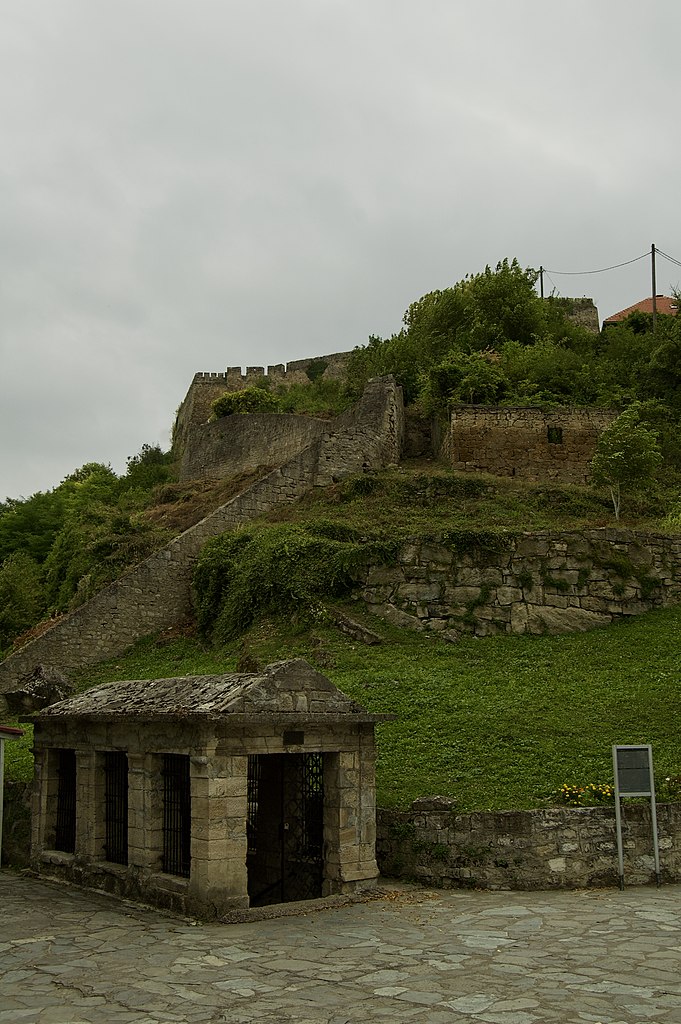
The catacombs are located within the city walls but do not keep regular operating hours. It is best to check with the tourist information centre or jump on a town tour where the guide has already arranged for the catacombs to be open.
St Mary’s Church/Mehmed II Mosque
St Mary’s Church dates from the early to mid 1400s and was the place where a Papal council crowned the last Bosnian king, Stjepan Tomašević, in 1461. The large bell tower, named after St Luke, is the most visible and intact part of the ancient complex. It is the only medieval bell tower remaining on the continental Balkan peninsula.
When the Ottomans overran Bosnia in 1528, the church was converted to a mosque. After several fires the church/mosque was put out of commission by the mid 19th century. It is located in the old town.
Temple of the God Mithra
Estimated to have been built in the 4th century AD, the temple for the deity of sun and light is the only one of its kind in Bosnia and Herzegovina. Although the cult of the invincible sun was widespread throughout the Roman Empire and the Romans had settled in the territory of present-day Bosnia and Herzegovina from the 1st century, no other traces of this cult have been found elsewhere.
The temple itself still bears visible carvings to their deity as well a handful of statues from that era. The Mithras temple is open to visitors but, as with many attractions in Jajce, it doesn’t keep regular hours. There is no entrance fee.
Jajce Fortress
This medieval fortification crowns the hilltop settlement of the old town. Built sometime in the 13th century, the fortress eventually became the Bosnian royal residence in the early 15th century.
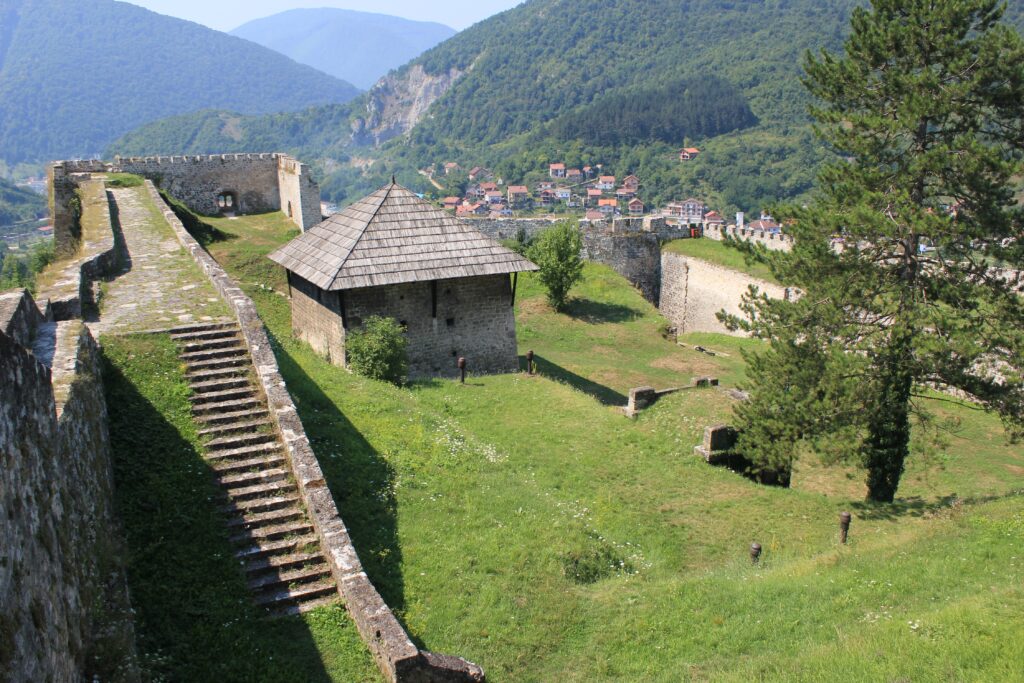
A stone-carved shield on the fortress walls indicates that in 1421 Jajce became the seat of the kingdom that lasted between Tvrtko II and King Tomašević’s rule. The walled fortress is open for visitors and the wall walks provide phenomenal views of the surrounding area.
Pliva Waterfall
Locals claim this waterfall is among the 12 most beautiful in the world. It’s on the official site of the tourism association. Who has actually ranked it 12th is never mentioned. The important thing here is that this waterfall is most definitely stunning and it gives Jajce its most unique brand. In the centre of the town, it cascades 21m into the Vrbas River. It may not compare to Mostar’s , but a diving competition is held on the first weekend of August every year.
The best view for a photograph is from the bridge at the southwestern entrance to Jajce from the Donji Vakuf direction. Alternately, you can check it out from down below on the viewing platform (4/2KM adult/child) opposite the base of the falls. Expect to get a little wet.
Kravica Waterfalls
Bosnia and Herzegovina is a country of mountains and water. Only a hop, skip and a jump from Međugorje, Ljubuški and Čapljina, Kravica is a remarkable waterfall on the Trebižat River and a great spot for a picnic and a swim. If that’s not enough you can go on a canoe safari on the Trebižat just a few kilometres down the road.
Stretching over 100m across and tumbling down 25m, Kravica is one of the largest waterfalls in Bosnia and Herzegovina, and the most impressive. A natural pool has been dug out at the base of the falls by the constant rush of water. It is a favourite local swimming spot with picnic area, restaurants, cafés and even a place to pitch a tent. Bring a camera when you visit; seeing something as stunning as that is not an everyday occasion.
During the summer months, it can be quite crowded and noisy – it’s a place where many people gather to beat the heat, and the restaurants are in close proximity to the waterfall and swimming areas. If you’re in the mood to explore, you can take a 20-minute walk or an electric boat for 20KM to the smaller waterfall nearby, Mala Kravica.
The village of Lukomir is perhaps the finest example of a highland village in Bosnia and Herzegovina; it is the highest and most isolated permanent settlement in the country at 1,469m. The village, with its traditional architecture, has been deemed by the Historical Architecture Society of the United Kingdom as one of the longest continually inhabited villages in all of Europe. The stone homes with cherry-wood roof shingles mark a practice that can no longer be found elsewhere on Bjelašnica. The villagers are mainly shepherds who live off the sale of sheep products.
Lukomir is known for its traditional attire as well, and the women still wear hand-knitted costume styles that have been worn for centuries. Electricity was introduced to the village and running water installation was completed in 2002. Access to the village is impossible between the first snows in December and late April, and sometimes even later, except by skis or on foot.
There is magnificent hiking in the area along the ridge of the Rakitnica Canyon, which drops 800m below. This is the least-explored canyon in southern Europe. It stretches 26km and feeds the Neretva River in Herzegovina near Konjic.
Rakitnica is a natural wonderland. Hundreds of thousands of years of tectonic shifts have created the steep limestone walls of Visočica and Bjelašnica mountains. The crystal-clear river below is fed by the melting snows and the hundreds of underground aquifer systems, making Rakitnica River water potable for the entire length of the canyon. Thirty-two endemic species of plants, flowers and trees can be found in this tiny region of the Dinaric Alps.
The story of Međugorje is well known to most Catholics. Ever since 1981, when six teenagers reported that they had seen an apparition of the Blessed Virgin Mary, Queen of Peace, in the hills between here and the village of Bijakovići, this sleepy Herzegovinian town has become the second-largest Catholic pilgrimage site in the world. There has been much controversy over the legitimacy of the visions, but in May 2019 the Vatican finally recognised it as an official pilgrimage site. Now faithful from all over the world are flocking to visit this sacred spot like never before, and according to many accounts, miracles are a regular occurrence.
As mentioned above, in 1981 six teenagers were playing together in the hills between Međugorje and Bijakovići. It was on this barren hillside that the Virgin Mary allegedly appeared and spoke to them. When the children told their parents, their first reaction was, of course, scepticism. The apparitions, however, did not cease. She appeared again and again, and soon made believers even out of the most vocal of critics. Since then it is estimated that more than 15 million people have visited this tiny place. The Virgin Mary is still said to appear every day but only to one of the teenagers.
A blue cross marks the bare mountain, now called Apparition Hill , where the children first saw her. A well-worn footpath on Cross Mountain , lined with Stations of the Cross, has been trekked by visitors from every corner of the globe. Many make the 30–60-minute trek barefoot, regardless of the fact that it is extremely rocky and relatively steep. The large cross planted on top of the hill is said to have been built to celebrate the 1,900th anniversary of the death of Christ, but it is more likely that it was built in 1934 to keep away the plague that had devastated several areas in the region.
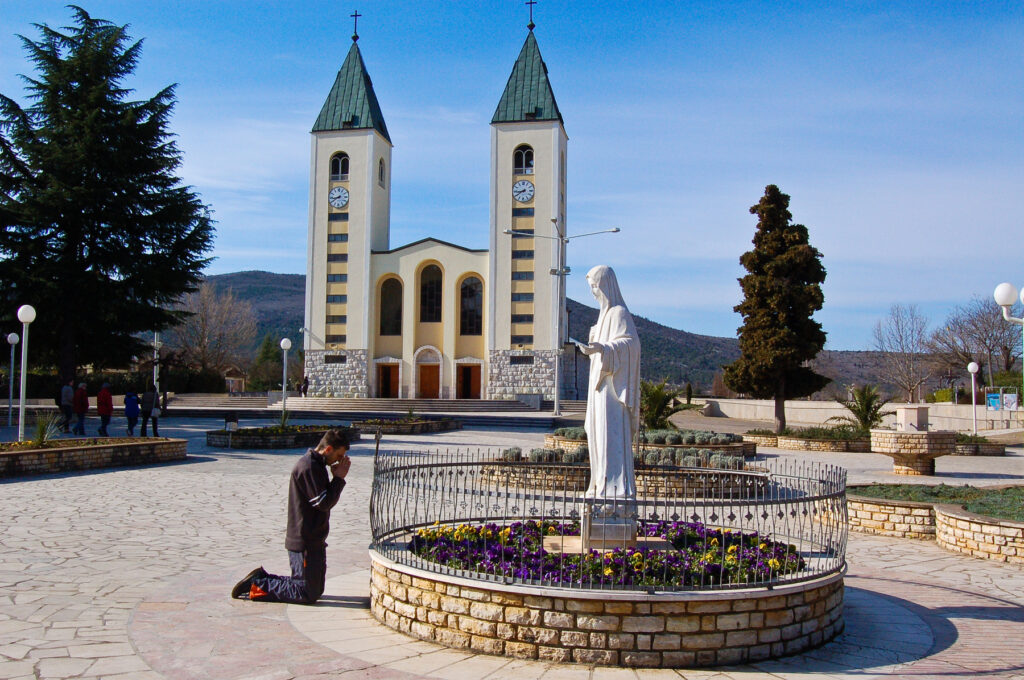
The village of Međugorje has become quite commercialised. The capacity to receive tens of thousands of guests at any given moment has turned the once dead main street into a souvenir-shop bazaar. Every few metres there are shops selling crosses, rosaries, statues, pictures, posters, jewellery – you name it, it’s there. It is easy to find internet connections, good information, guides in most European languages, and probably the best general service in the country. With that much practice, they’ve got it down pat.
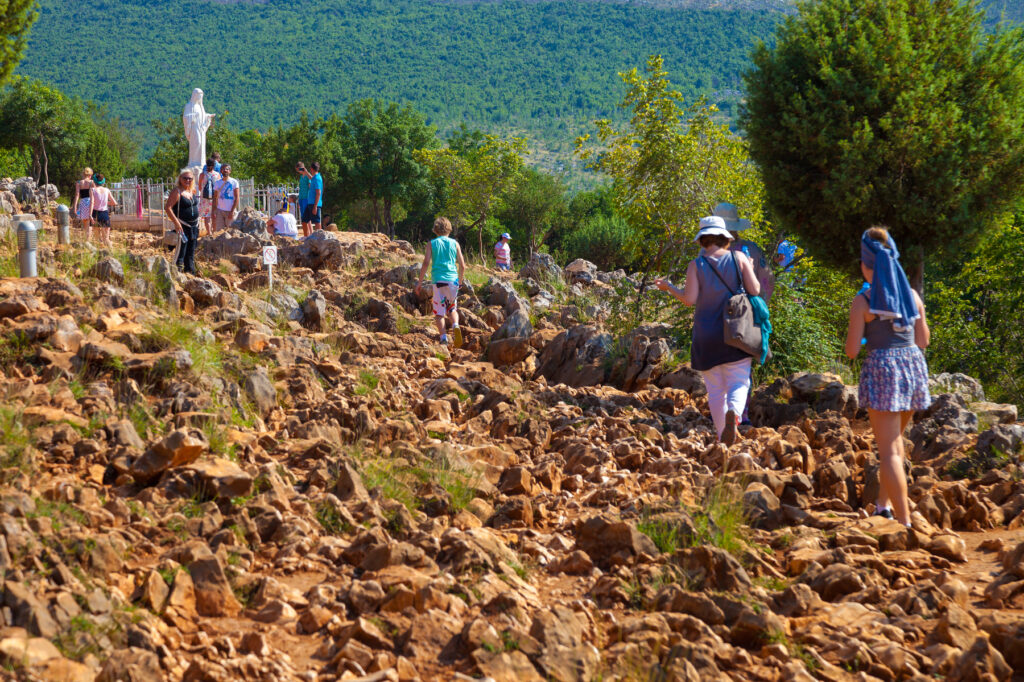
The main church, St James’s , is in the middle of town. Bear in mind there is a conservative dress code that forbids shorts and dresses above the knees and sleeveless shirts if you plan to enter. Whether or not there is a Mass on, the square around the church is still bound to have people sitting, praying and contemplating. There will be something going on every Catholic holiday and saint’s day. Just up the road is the even smaller village of Bijakovići . Despite the massive influx of tourists and pilgrims, it has managed to retain much of its original old Herzegovina style.
In the grand scheme of European tourism, Mostar is largely considered as just a day-trip destination from neighbouring Croatia and Montenegro or a quick stop-off when travelling to Sarajevo. While this has indeed positioned it as one of the most-visited cities in BiH, it is safe to say most tourists hardly scratch the surface of Herzegovina’s enchanting capital city. Those that give it more time, or at least an overnight, will be rewarded with the magic of the town mostly to themselves and the opportunity for countless other cultural and adventure-filled excursions around its immediate vicinity.
What to see and do in Mostar
No matter how many times one does it, crossing the Stari most (Old Bridge) always seems to be an exciting experience. This single-arch stone bridge is an exact replica of the original that stood for over 400 years, and that was designed by Hajrudin, a student of the great Turkish architect Sinan. The Halebija and Tara towers have always housed the guardians of the bridge and during Ottoman times were storehouses for ammunition. Year round, though especially during spring and summer, you can catch some of the daredevils from the Bridge Divers’ Club jumping off the bridge from a height of 23m straight into the Neretva.
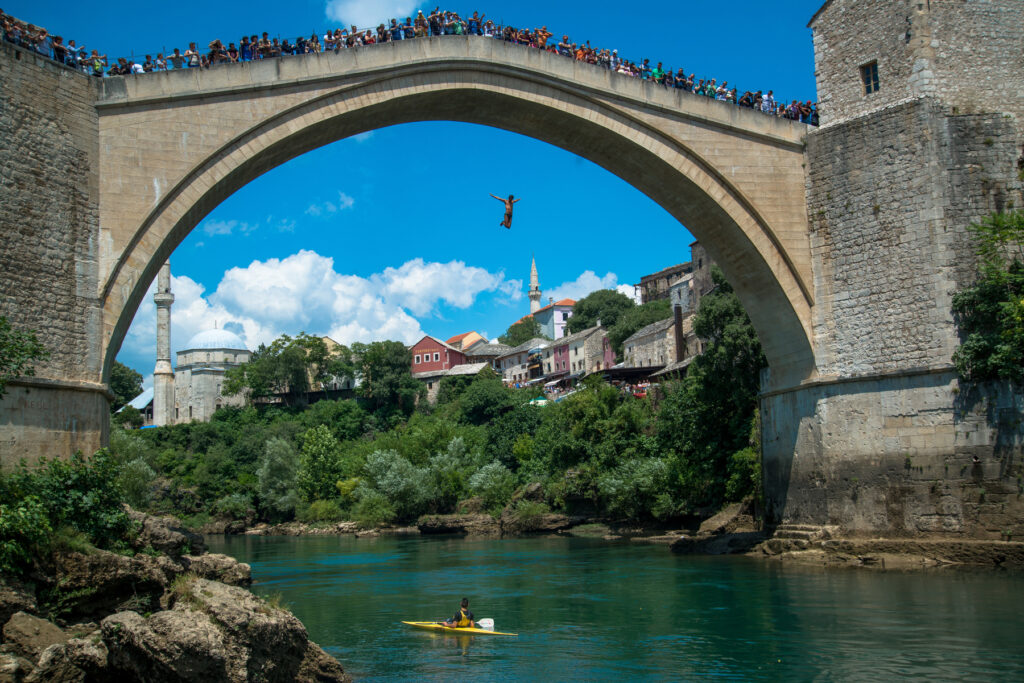
Don’t miss the Stari most Museum , which is housed in the Tara Tower. Upstairs are a few exhibitions with excellent views of the bridge on top. The stairs down to the right lead to the underbelly of the Old Bridge and provide a fascinating peek at how the old structure was built. At the end of a labyrinth is a small viewing room with a UNESCO film by Bosnian film-maker Jasmila Žbanić about the reconstruction of the Old Bridge.
Koski Mehmed-Pasha Mosque
Mostar is unique in that it has opened many of its most precious and historical mosques to be visited and viewed by tourists. This one was built in 1617 and although heavily damaged during the last war, it has been fully restored. Visitors are permitted to enter the mosque, and even climb the minaret for a phenomenal view of the Stari most.
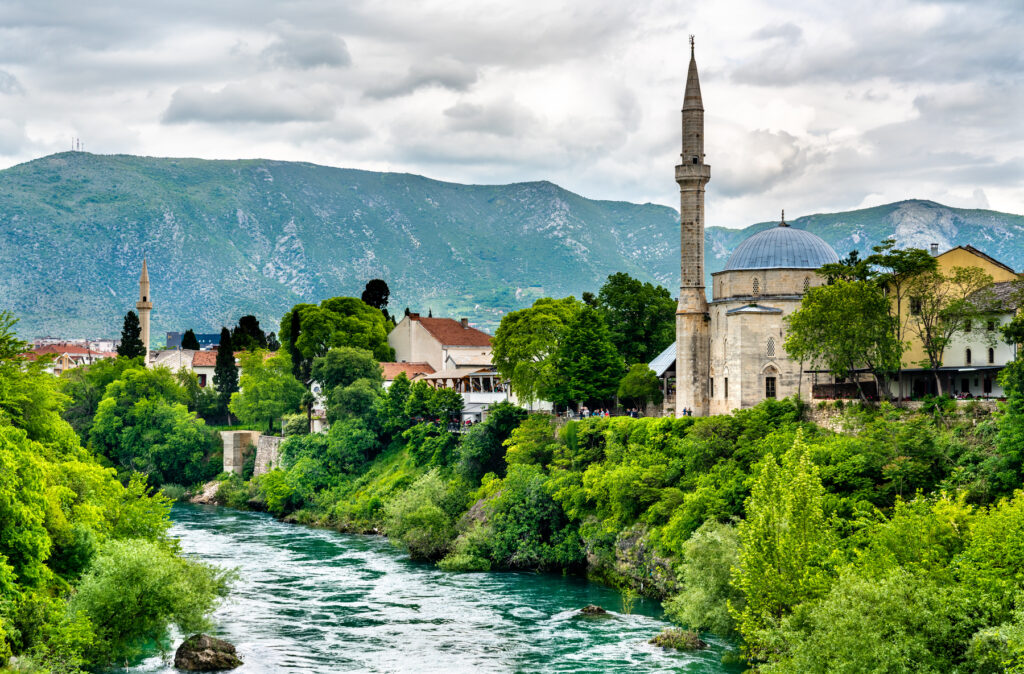
You must take your shoes off before entering a mosque. As this mosque is open for visitors, it is not required that women wear a headscarf. On the same premises you will find a madrasa, which was built in the 17th century. It is recommended to visit in the morning in order to avoid the crowds.
Muslibegović House
Arguably the finest example of Ottoman architecture in BiH, the Muslibegović House is one of Mostar’s premiere attractions. The house itself is an exquisite model of 17th-century Ottoman architecture. The original house was built in the 16th century but it was later expanded and upgraded.
The owners have adopted the Spanish model of national monument homes and opened the house as a boutique bed and breakfast. The museum visit is a 20-minute tour of the middle part of the house (the other parts house the guests) with interesting historical facts and anecdotes. The true experience, however, is to spend the night and live like a beg for an evening.
Bišćevića House
Built on a side street that leads down to the Neretva River, this 17th-century Turkish house, partially supported by 5m-long pillars, is one of three well-preserved Ottoman homes to visit in Mostar. The home is still owned by the Bišćević family, who proudly give guided tours. The main attraction is the large gathering room, or divanhan , which was designated for men to talk business. It is preserved in original Turkish style.
Kajtaz House
A bit off the central circuit of the old town this is the best-preserved Turkish-style house in Herzegovina, a UNESCO World Heritage Site, and now protected by law as the finest example of an Ottoman home. Fortuna Tours near the Old Bridge can arrange a tour guide, or you can wander up to the house yourself. The host does not speak English, but she will gladly walk you through the old-style kitchen with all of its original and functional furniture and equipment. The garden terrace, shadowed by Hum Mountain to the west, has plenty of seats to sit back and enjoy the hostess’s homemade juice from roses – it is absolutely amazing and nearly impossible to find anywhere else. The upstairs floor is laid out in typical Turkish fashion.
There are separate sleeping rooms for the women, all with bathing areas within the room. The women also had a large sitting room where they would receive guests and entertain. The men were situated on the southern side of the house, but the man of the house had free range to visit his many wives. The wooden wardrobes and large chests are carved with intricate oriental designs. In the open foyer upstairs, you can try on a set of traditional attire (men’s and women’s) – a great photo opportunity. The fact that the house is still lived in adds to its charm.
Karađoz-begova Mosque
This is the most important and significant of all sacred Islamic architecture in Herzegovina. The mosque was heavily damaged during the war and its minaret completely destroyed by tank and artillery rounds from the Croatian forces. The mosque was completed in 1557. Its designer was Kodža Mimara Sinan, a great Turkish architect, and the work was probably carried out by local and Dalmatian stonemasons.
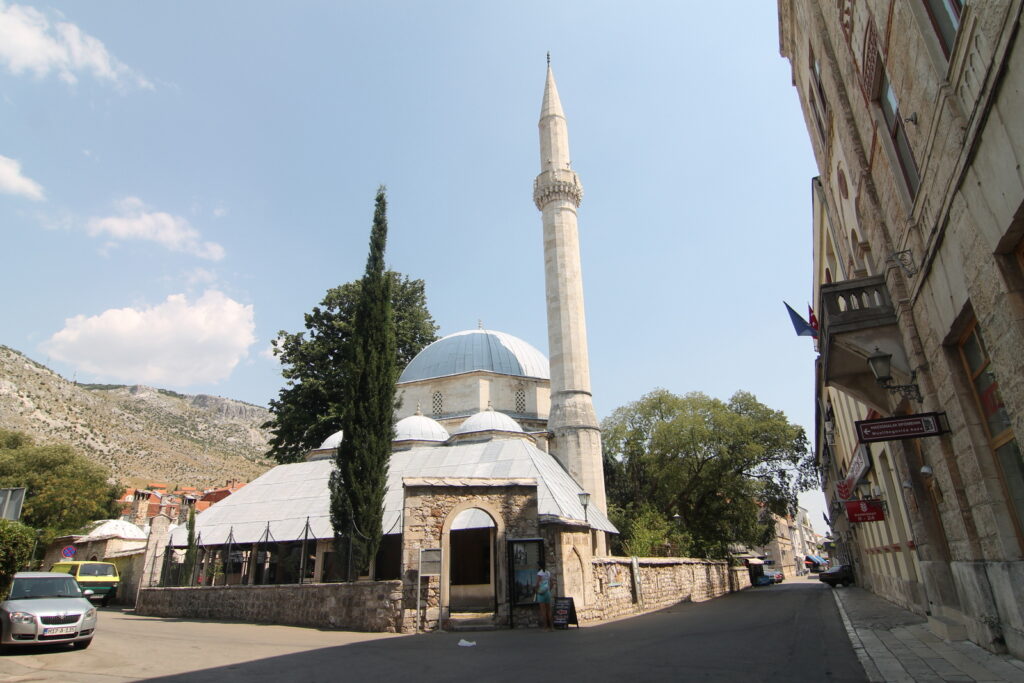
The interior is marked with typical Ottoman characteristics but has lost much of its detailed paintings from water damage after its destruction. It opened to visitors again a few years ago after being under construction for a long time and visitors are now allowed to climb to the top of the minaret.
Mount Olympus National Park
Olympus (Όλυμπος) originally meant ‘mountain’, and scattered around the Mediterranean some 20 other mountains bear the same name. But this, the highest peak on the Balkan peninsula at 2,918m, its summits wreathed in cloud, its precipices echoing with thunder, was always the Olympus, the abode of Zeus and his argumentative clan. In Homer, the palaces of the gods lay in the mountain’s ‘mysterious folds’.
At the tallest of its 52 peaks, in ancient times known as the Pantheon (now more prosaically called Mýtikas, ‘nose’), where the sun always shone and the air was too thin for mortals to breathe, the deities would gather to hear Zeus arbitrate on his Throne, the sheer armchair (and greatest climbing challenge on the mountain) today better known as Stefáni (2,902m). Olympus was one of the last famous European mountains to be climbed (in 1913) – not because of Zeus’s thunderbolts, but because of the armatoloí (irregular militia) and kidnapping klephts who haunted it until Macedonia became part of Greece in 1912.
In 1938, high Olympus and its deeply wooded eastern slopes were designated Greece’s first National Park; in 1981, UNESCO included it in the list of World Biosphere Reserves. It’s famous for its birds – some 156 species have been counted here, and some 1,700 Mediterranean and Central European plants have been found (25% of all the flora in Greece, including the rare Bosnian pine), and of the rare little plants above the tree line 23 species are unique to Olympus. The lions that attacked the camels in Xerxes’ army are gone, but Zeus’s golden eagles still float overhead, and wolves, jackals, wild cats and deer roam in the woodlands. Litóchoro (Λιτόχωρο) on the east slopes, the classic gateway to Olympus, is in a superb setting, just 5km up from the coast.
If there is one place in continental Europe that symbolises the crossroads between East and West, Sarajevo would have to be it. It is here that the Byzantine and Ottoman empires to the east and the empires of Rome, Venice and Vienna to the west brought their culture, traditions and religions. Only a few spots on earth can boast of hosting an Orthodox and a Catholic church, a mosque and a synagogue, all in the same square.
This city, in particular, epitomises the centuries-old struggle against outside forces and the ability to assimilate all of these influences into one of the most diverse indigenous cultures in Europe. Whereas other parts of Bosnia and Herzegovina may still be burdened with ethnic strife, this city’s long-standing tradition of multi-ethnicity enables it to thrive in its diversity. A walk through Sarajevo is a walk through the past.
What to see and do in Sarajevo
Baščaršija, as the old town is called, is the far east corner of Sarajevo and is the part of town that displays its oriental flavour. This was the centre of life during Ottoman rule from the 1440s until the empire collapsed here in 1878. It is famous for the craftsmen of every kind who still hammer away at making authentic handmade goods as their forefathers did centuries ago. Sebilj square is where the main public fountain is located in the old town. It has been refurbished after falling into disrepair during and after the war. The square is always filled with pigeons and for 1KM you can buy a cup of corn, which will be completely covered by the little flying creatures in seconds. The coffee and sweet shops near Sebilj all serve Turkish coffee with rahat lokum (Turkish delight).
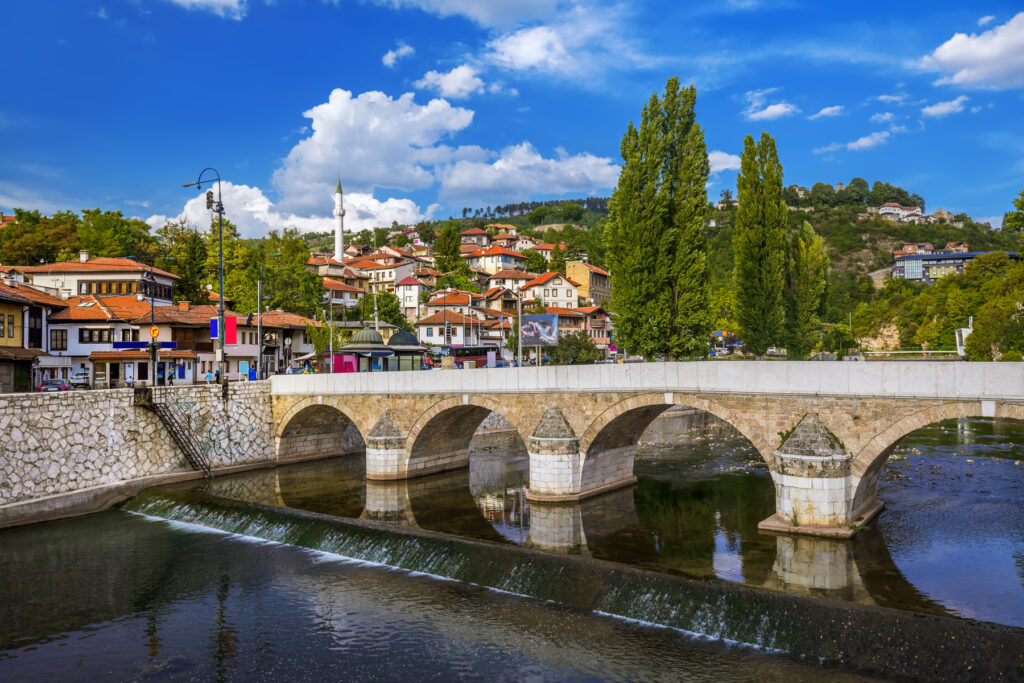
Just outside the square is Kazandžiluk , the famous coppersmith trading place on the west side of Baščaršija. Here you’ll find great antiques, hand-beaten copper dishes and oriental décor. It may seem strange to find shell cartridges left over from the war on sale, but Sarajevo was hit with enough artillery and anti-aircraft fire that if you stacked them they’d reach the moon.
Next to Kazandžiluk street is Baščaršijska džamija or the marketplace mosque. Its official name is Havadja Durak’s Mosque (Džamija Havadže Duraka) and it was built in the 1530s. This mosque often has the imam singing the call to prayer from the minaret, the mystical sounds of which resonate throughout the čaršija (old Turkish quarter).
Ferhadija
Ferhadija walkway is perhaps the most charming part of town. It stretches from Sebilj in the centre of Baščaršija all the way to the Eternal Flame in the city centre. The lower part of Ferhadija is officially called Sarači, but it is the same walkway that changes name near the Austro-Hungarian part of town. Ferhadija is almost always filled with locals strolling through town, window shopping, chatting or just enjoying the pleasant energy of walking up and down.
Along the Ferhadija is Morića Han . It was known as a caravanserai, meaning ‘castle of the caravans’. The function of the han (inn) was to provide warehouse space, stables and accommodation for traders coming from near and far. It was built by the Gazi Husrevbegova fund and got its name much later from the inn operator Mustafa Morić. In the 1970s it was renovated and restored as a tourist attraction. It now has several restaurants and cafés, an oriental rug shop and office spaces on the first floor where the inn rooms used to be. It’s a lovely place to sit and have a drink in the courtyard and imagine how it used to be.
Old Orthodox church
The old Orthodox church (Stara pravoslavna crkva) is often referred to simply as the old church. It is estimated that the church was built in 1539–40. The Orthodox Church grew considerably in Bosnia from this point on. The church caught fire several times. The turret by the church had a dome until the first half of the 20th century but, following the reconstruction designed by architect Dušan Smiljanić, the turret became the simple form it is today.
The museum (free entrance) has many icons and frescoes from that era, and even earlier relics brought to Sarajevo from other Orthodox lands. The museum was arranged by Jeftan Despić, the sexton of the old church. Be sure there isn’t a service in session before entering.
Gazi Husrev-beg Mosque
Gazi Husrev-beg Mosque is the most significant Islamic building in Bosnia and Herzegovina. It is perhaps the finest example of Ottoman Islamic architecture on the Balkan peninsula. The Persian architect, Adžem Esir Ali, was the leading architect of his time within the empire and his mosque design favours the early Istanbul style. The original structure was built in 1530 but was largely destroyed when Eugene of Savoy plundered Sarajevo in 1697. It was fully restored by 1762 but was destroyed again in 1879. The last reconstruction of Gazi Husrev-beg Mosque was in 1886.
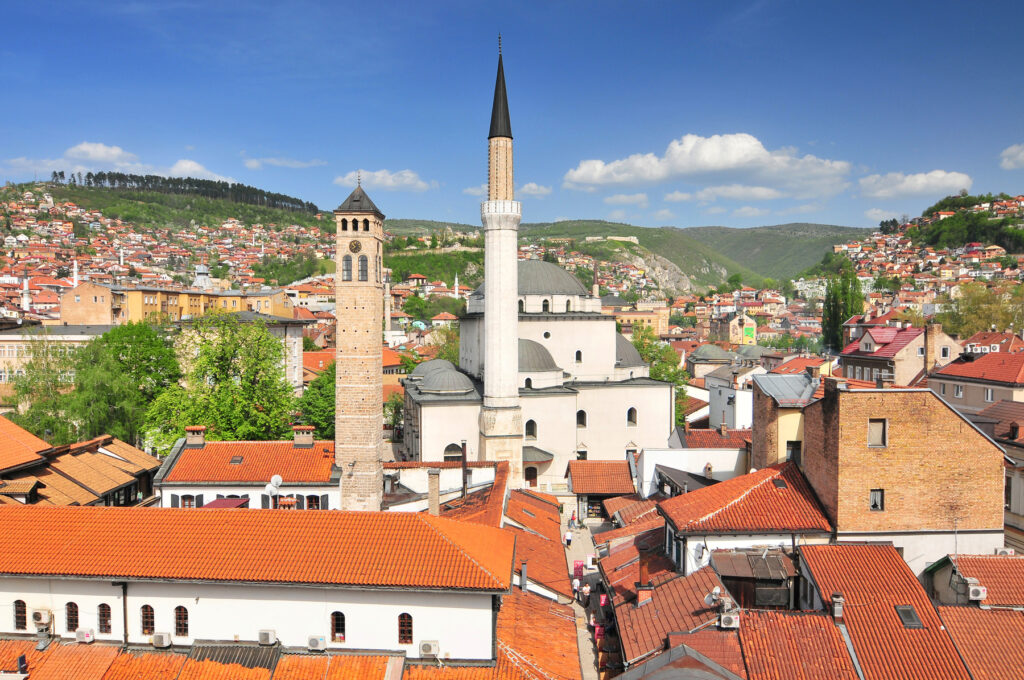
Although it was damaged during the last conflict, most of its precious original oriental design survived unscathed. It is important to stay to the side during prayer time as it is the main mosque in the city and is usually filled by local worshippers. No need for shyness, they are used to visitors and simply expect them to be courteous and follow the rules. Directly across the stone walkway is the Gazi Husrev-beg Madrasa (Sarači; free entrance). A madrasa is an Islamic educational institution and this one was founded on 8 January 1537; it is now often the location for Islamic art exhibitions.
Jewish quarter
Through a small passageway between Ferhadija and Bašeskija streets is the Grand Yard (Velika Avlija), also known as the Jewish quarter. The Jewish Museum is located here. The Sephardic Jews that settled in Sarajevo quickly established themselves as tradesmen within the Ottoman Empire and the first temple to be built was the Stari Hram in 1581, less than a century after the Jews were expelled from Spain. The old synagogue, or Il Kal Grandi , was also destroyed in 1697 and again in 1788.
As the Jewish community increased, there were growing calls to build a larger place of worship and the old temple was expanded in 1821. The upper floors were used by the women and the ground floor by men – the same tradition is practised by Muslims.
Christian and Muslim quarters
Religious harmony has always been the backbone of Sarajevo’s multi-ethnic community. The Catholic cathedral was completed in 1889 when the Austrians had gained full control of the city. It is the seat of the Vrh-Bosna archbishop and is dedicated to the Most Holy Heart of Jesus. The cathedral was designed by the architect Noble Josip Vancaš in neo-Gothic style, with some elements of Romanesque. It is very similar to Notre Dame Cathedral in Dijon. The Pope led mass here during his visit in 1997. Don’t be surprised to find Sarajevo’s youth gathering on the steps of the cathedral; it has always been a popular (and central) place to hang out or wait for a friend. The cathedral is also open to visitors free of charge when there is no mass taking place.
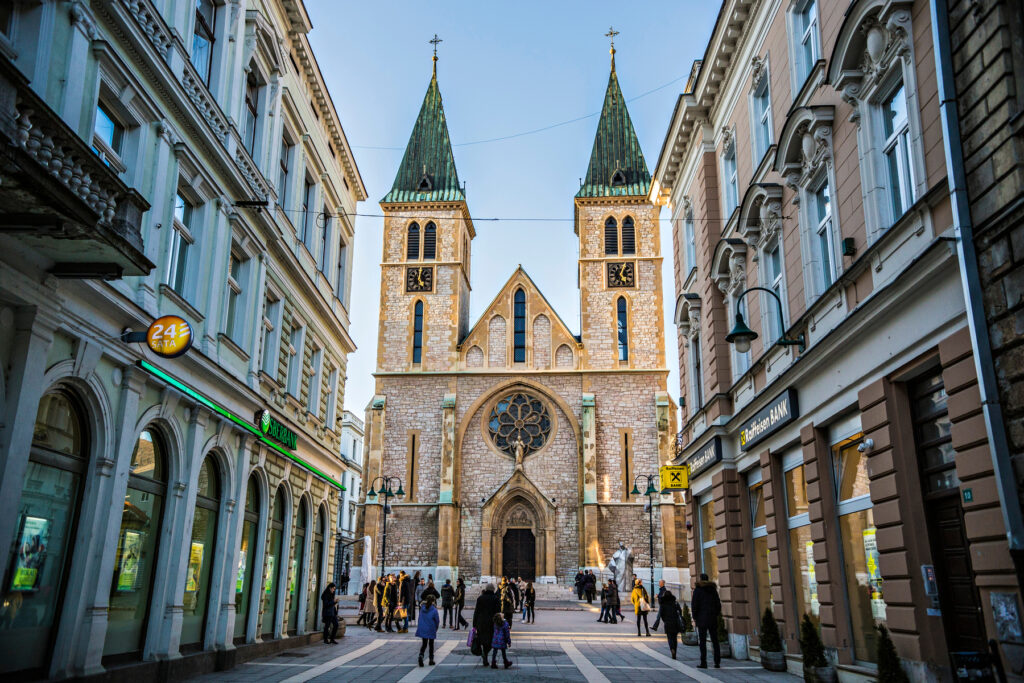
Behind the cathedral near the music school is the Bosniak Institute, dedicated to the history of the Bosnian Muslims, or Bosniaks. It’s an interesting place to see old documents and read about famous Muslim writers and historians, and it offers a fascinating insight into the national identity of the Bosnian Muslims. Down the street is the new Walter Defends Sarajevo Museum . Opened by Sarajevo Film Centre in 2019, this tiny museum filled with wax figures, stage reconstructions and Walter Defends Sarajevo playing on repeat 8–12 hours per day pays homage to what was one of the most popular films produced in Yugoslavia that many have come to consider a symbol of Sarajevo.
National Library/City Hall
This is the most significant architectural monument in Sarajevo and in 2014, 22 years after it was destroyed, its reconstruction was finally completed, and it is worth visiting. The entrance fee allows full access to the building and all the time you want to admire the pseudo-Moorish and other architectural styles. There is a permanent exhibition in the basement, and there are sometimes other special exhibitions or concerts.
Galerija 11/07/95
Gallery 11/07/95 is not only one of Bosnia and Herzegovina’s most professionally curated galleries, but one that will humble you for its moving and thoughtful content. With a multitude of media, the gallery depicts the horrifying events that led up to the 11 July 1995 genocide in Srebrenica and, just as important, its aftermath. With its vivid photos from award-winning photographer Tarik Samarah, videos, interviews with survivors and the wall of death (that names each of the more than 8,000 victims), this is an experience you shouldn’t pass up.
Sarajevo is a fun and vibrant city. This gallery is not meant to be a downer to anyone’s good time, but a solemn reminder of the depths of human suffering.
Related books
For more information, see our guide to Bosnia and Herzegovina :
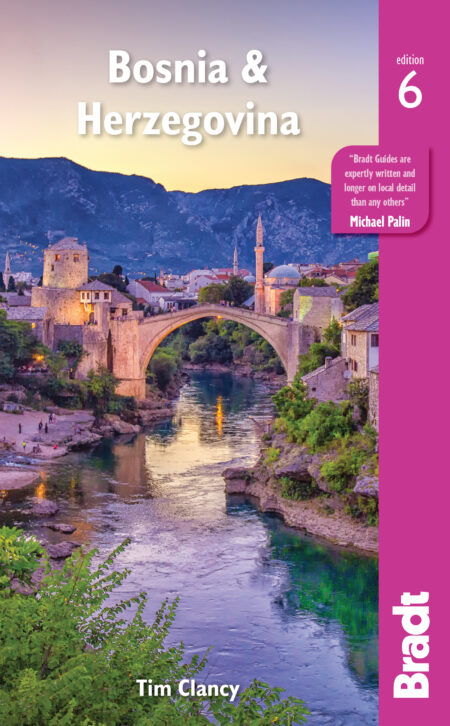
Related articles
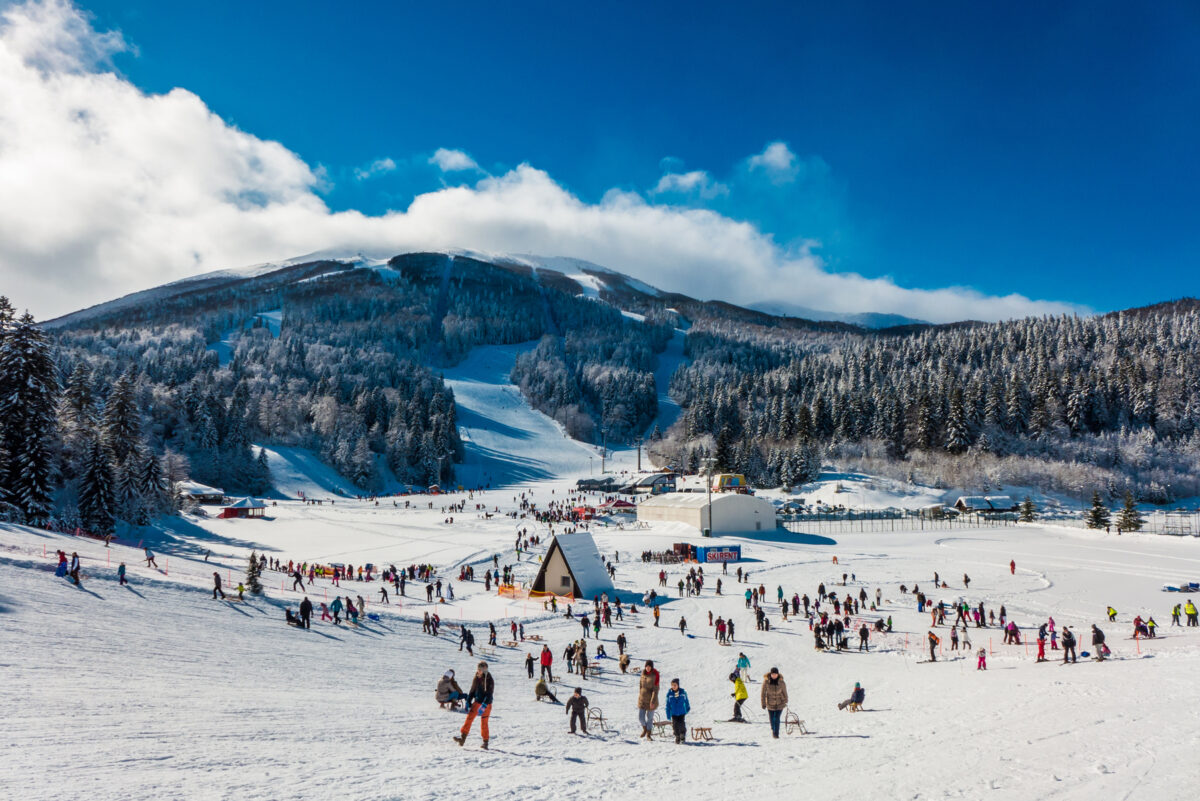
On the wild side: outdoor activities in Bosnia and Herzegovina
From mountain biking to white-water rafting, Bosnia and Herzegovina has it all.
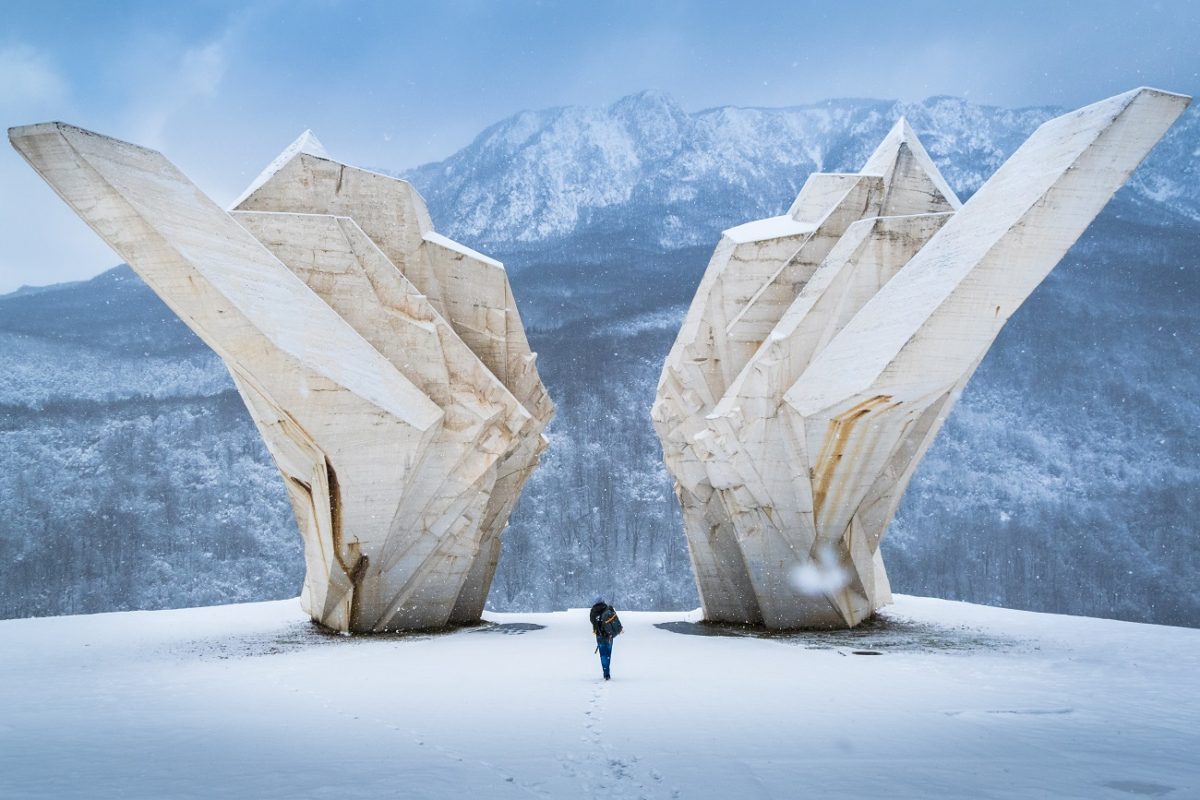
The secrets of spomeniks: a window into Yugoslavia
These fantastical memorials serve as a poignant reminder of the lives lost during the National Liberation Struggle.
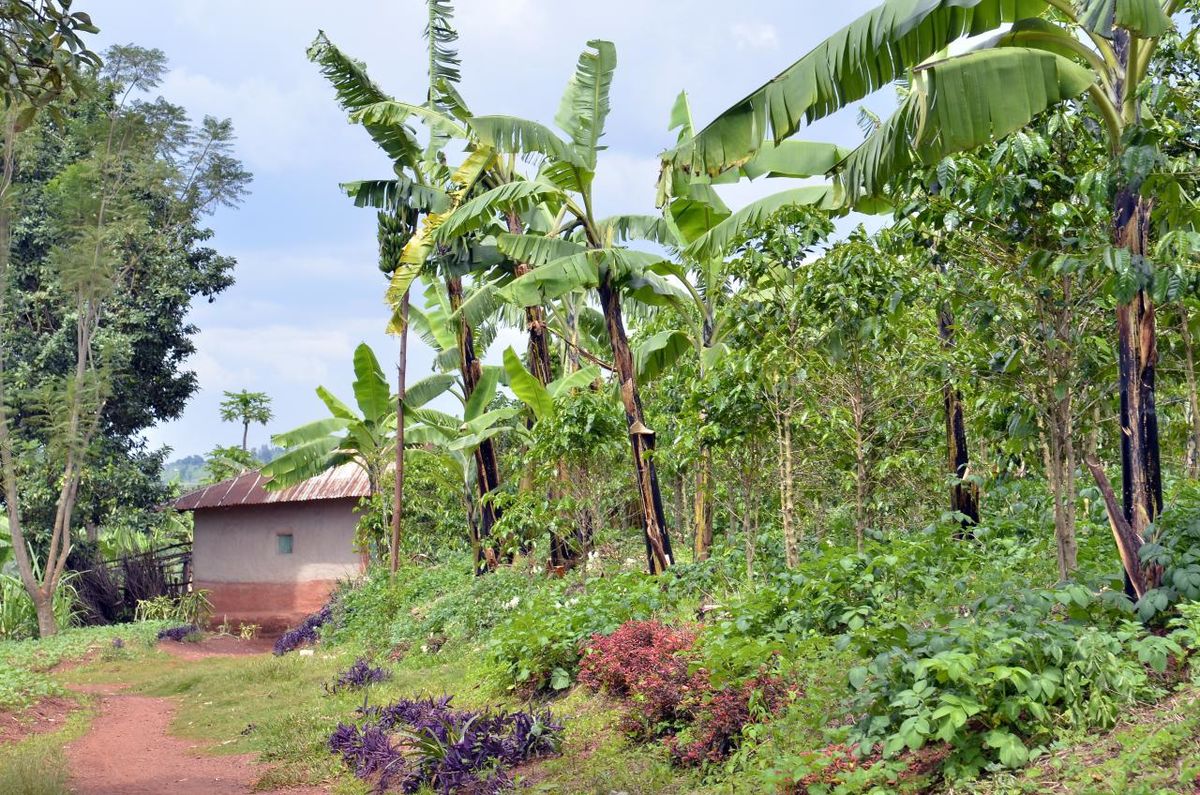
The best coffee destinations around the world
From Colombia to Kosovo, we pick some of our favourite lesser-known places to enjoy a good cup of coffee.

Discover the Hidden Gems of Bosnia: Your Ultimate Travel Guide!

Bosnia and Herzegovina
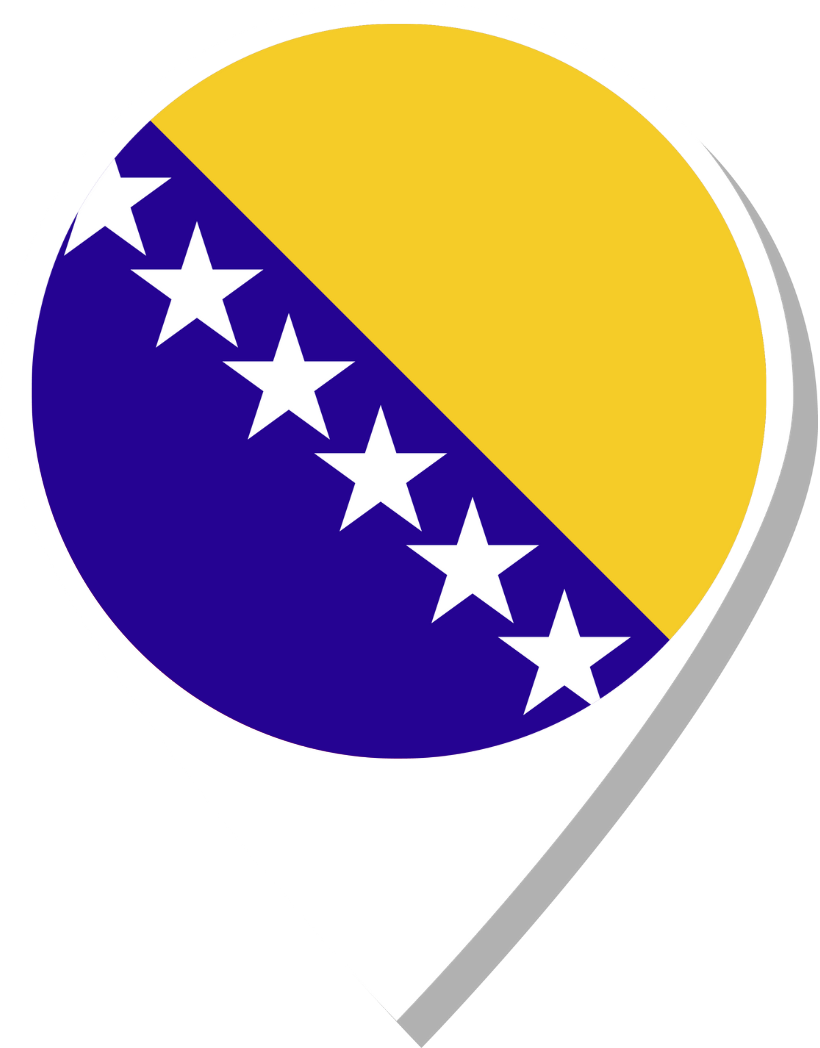
Bosnia and Herzegovina is one of the most ethnically and religiously diverse countries in Europe. The country has a diverse landscape to match too, with a craggy mountainous heart, gold-sand beaches and dense forest. Unlike other popular destinations, this Balkan country remains relatively undiscovered by the masses, so it’s a hidden gem that you would love to find.
Not sure where to go?
Explore the options for a responsible trip
GOOD PLACES TO VISIT
Explore destinations that were certified for their sustainability efforts
GOOD BUSINESSES
Discover accommodations, restaurants, shops and activities that are committed to sustainability. their efforts are summarised in a scorecard (click on the picture). for the good travel seal, the higher the level, the more things are checked by an independent auditor..
- Accommodations
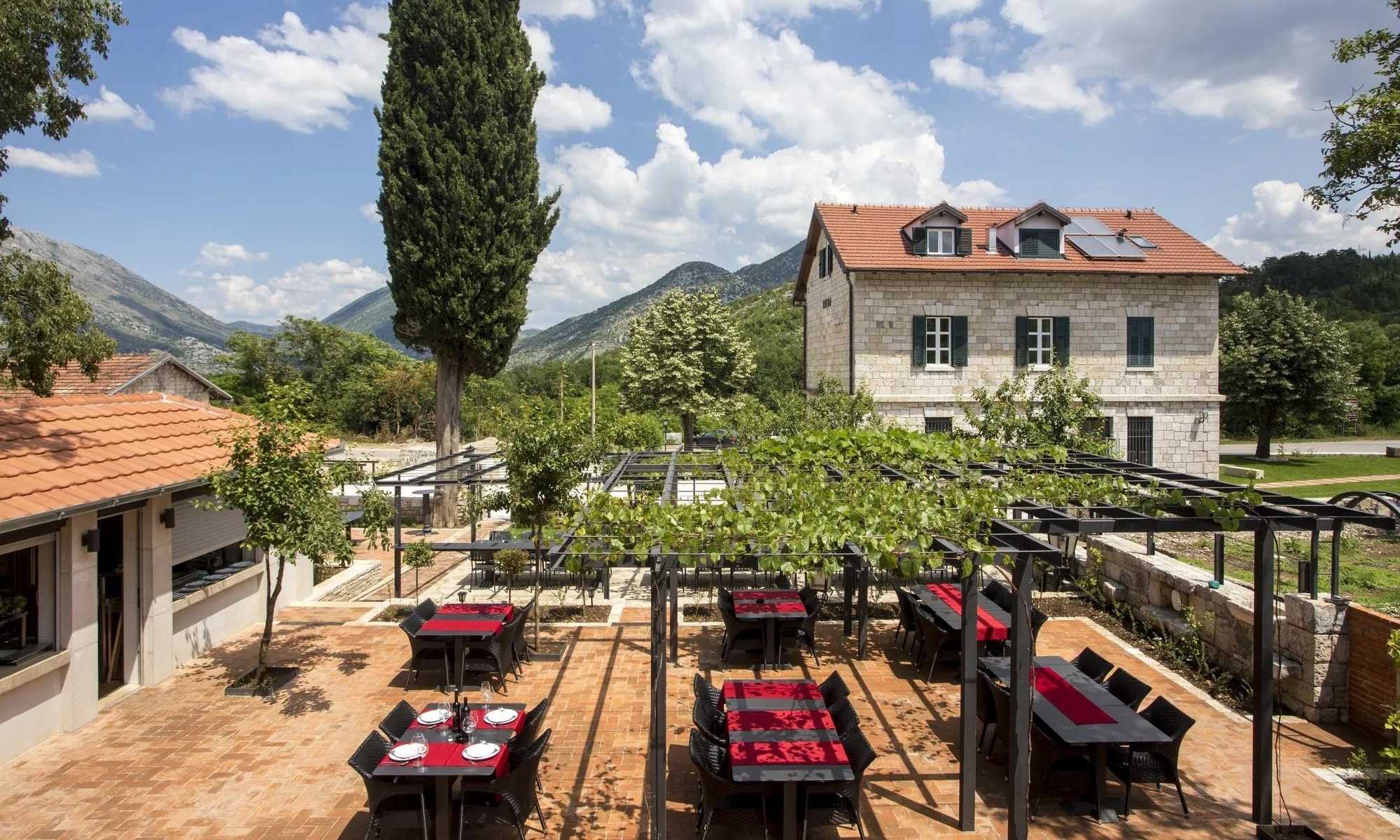
WBR Zona HOTEL STANICA RAVNO d.o.o.
Sustainability
Sustainability in Bosnia and Herzegovina is an evolving concept, with increasing awareness of environmental issues and a growing commitment to address them. Efforts are being made to promote eco-friendly practices in sectors like tourism and agriculture. While challenges like air pollution persist in urban areas, there’s a growing interest in green technologies and renewable energy sources.
GOOD PRACTICE STORIES
Get inspired with stories from places and people that are acting for a fair and responsible tourism
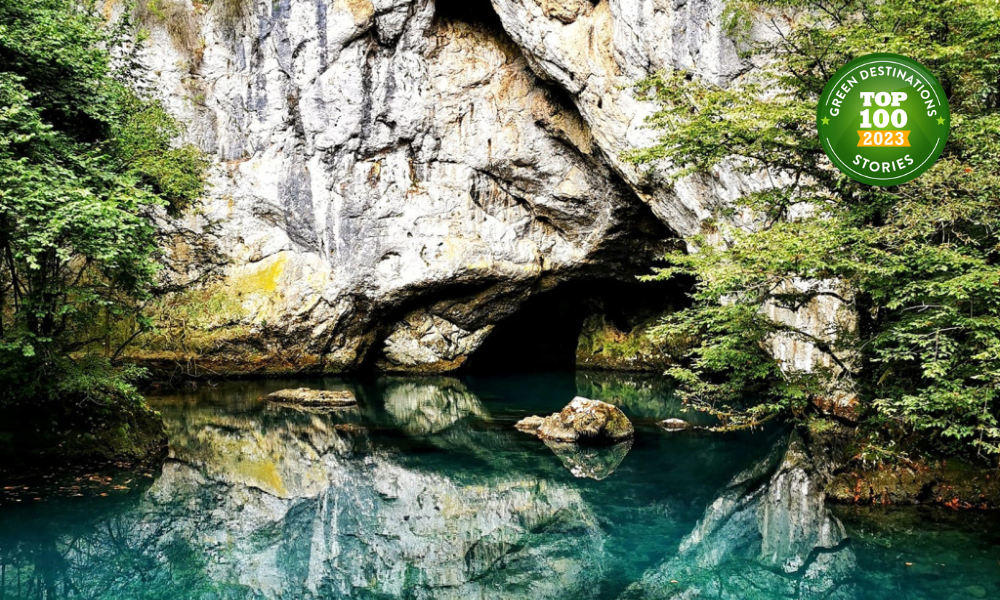
Bosanska Krupa
The main issue Bosanska Krupa faced was a neglected and unused communal space in the heart of the city center, a place only partially accessible to citizens and visitors. An area void of any content, plan, or protection. Therefor “Zeleni otoci” or Green Islands was created, an unique city park made up of eight river islands in the heart of Bosanska Krupa. This idyllic place is a haven for the soul and body, showcasing the harmonious coexistence of people and nature. It is more than just a destination; it is our vision of a sustainable and harmonious future, a source of inspiration and motivation for everyone, a part of our community’s identity, and a lifestyle that embraces nature in our everyday lives.
KNOW THEIR STORY
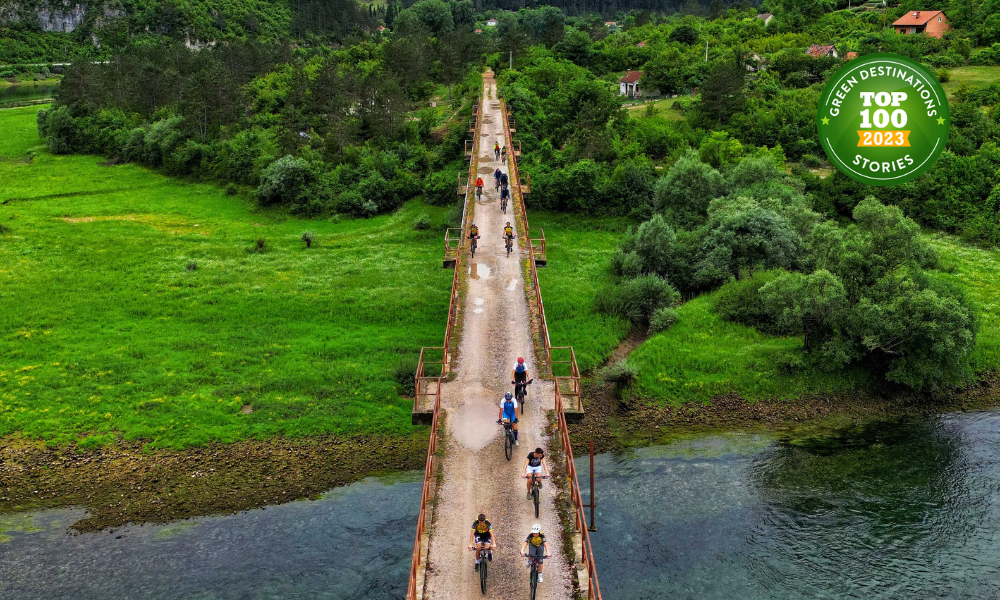
City of Trebinje
Over the past years, the City of Trebinje has emerged as a tourism hub in the region, experiencing continuous growth in the number of registered overnight stays. However, the COVID-19 pandemic has presented significant challenges to the tourism sector, particularly for tourism operators such as tourist agencies, hotels, motels, restaurants, and sports associations. To address these challenges, it was necessary to find innovative solutions and approaches to enhance the resilience of the local community and businesses in the face of the COVID-19 pandemic and potential future challenges. One potential avenue for improvement was the development of active tourism, specifically outdoor tourism, in the City of Trebinje. KNOW THEIR STORY

City of Konjic has great potential for tourism due to its natural beauty and rich cultural heritage. It is an attractive destination in Bosnia and Herzegovina, located near popular tourist spots like Sarajevo, Mostar, and Dubrovnik. Tourists can enjoy exploring the city’s historic sites, such as the renovated Stone Bridge, along with engaging in outdoor activities like hiking, camping, white water rafting, kayaking, and paragliding. The Neretva River, known as the “divinity that flows,” is an important tourist symbol in Konjic. It originates in the mountainous regions of high Herzegovina, forming a unique ecosystem. Rafting on the Neretva River offers thrilling experiences for both beginners and experienced adventurers. However, the tourism sector in this area faces several challenges. KNOW THEIR STORY
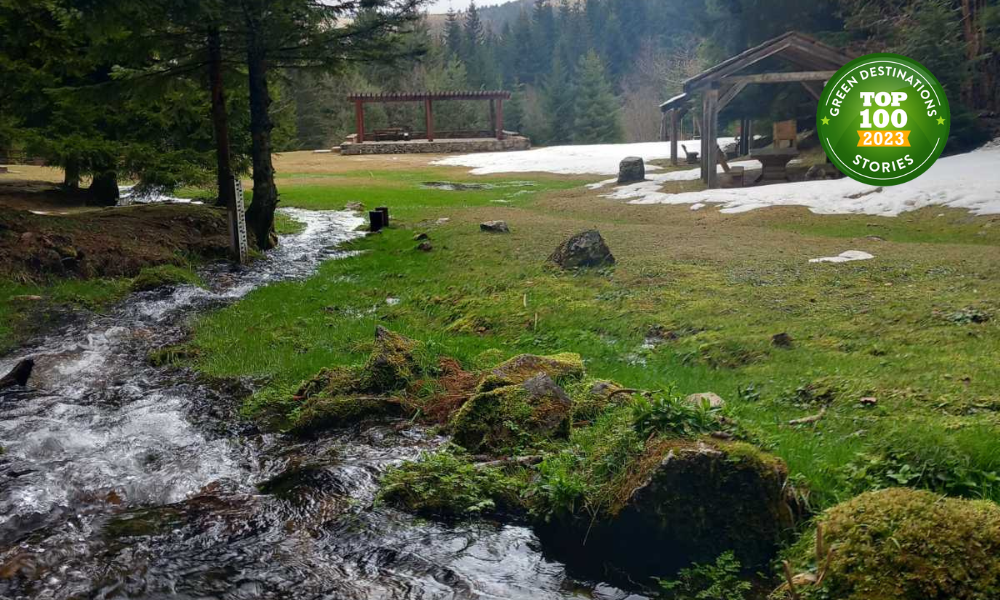
Monument of Nature Skakavac
The Monument of Nature Skakavac is recognizable by a 98 m-high waterfall, a unique location of natural and cultural heritage in the vicinity of the city Sarajevo. To preserve it and protect it from urban and human degradation, essential protection is secured through classification as a IUCN category III b site. While still under development as a mini destination, today Skakavac offers a selection of outdoor activities, marked trails and biking routes, local refreshment and equipment hire; all managed with a focus on responsible behaviour and interaction with the natural world. KNOW THEIR STORY

Protected habitat Tišina
The preservation and protection of the Bar Tisina area is being achieved through the declaration of the destination as a protected habitat, and the assignment of management responsibilities to the Municipality of Šamac. Currently, a Management Plan is being developed to promote sustainable tourism, the process involves conducting assessments, securing legal protection, engaging stakeholders, and involving the community. Efforts are being made to encourage sustainable tourism practices and establish monitoring and enforcement mechanisms. Various funding sources are being explored for ongoing management and protection efforts.
Tourism & People
Tourism in Bosnia and Herzegovina combines history, natural beauty, and warm hospitality. Visitors are drawn to cities like Sarajevo and Mostar, where cultures converge. Bosnian people are known for their friendliness and resilience. Traditional Bosnian cuisine, cultural rituals, and scenic landscapes make for an enriching travel experience.
Travel tips from our editors

Getting around
The country has a well-connected bus network that links major cities and towns. Trains also operate, although the network is not as comprehensive as buses. Additionally, walking is a pleasant way to explore cities and towns, and some places offer bike-sharing programs for cycling enthusiasts.
Nature & Wildlife
With woodlands that still cover 50% of the country, national parks such as the Unesco-listed Hutobo Blato Bird Reserve and some of the most impressive peaks in the Dinaric Alps, Bosnia & Herzegovina is also paradise for hikers and nature-lovers.
Sustainability Recognitions
Brazil has 9 destinations featured in the Top 100 Sustainable Destinations 2021.

Other sustainability certifications can be seen here (English) and here (Portuguese).

Fernanda Rodak | Page Editor
“Brazil is a worldwide known hotspot for biodiversity as well as home to a multitude of cultural expressions. The natural and cultural heritage and immense variety of tourism experiences in the country are valuable assets for its competitiveness. Yet, as we envision a post Covid-19 era, sustainability in tourism becomes crucial to build resilience and guarantee the long-lasting health of Brazil’s ecosystems and well-being of the hosting communities. This would also ensure an active contribution of the country’s tourism sector to the Sustainable Development Goals.”
Visit other destinations nearby?
Get in touch Sign up to our newsletter About Contact Internships Privacy Policy
Support We are a multicultural, creative and dedicated team working to promote sustainable tourism. Join us in our fight against the climate crisis, single-use plastics and over-tourism!
Newsletter sign up
- Travel Guide
- Popular Destinations
- Things To Do
The Great Pyramid of Bosnia at Visoko
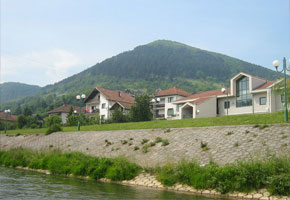
Food in Bosnia and Herzegovina
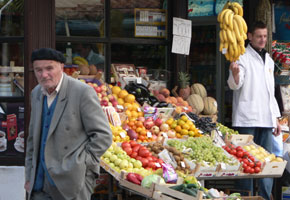
The Long, Troubled Road to Today’s Bosnia
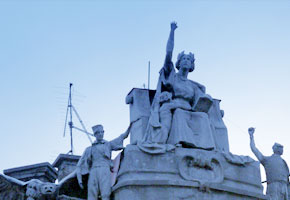
Sarajevo is the capital of Bosnia-Herzegovina and is the focal...

Mostar is the fifth-largest city in Bosnia and Herzegovina and...

Medjugorje is the city in Bosnia and Herzegovina for relaxation,...
Other popular destinations in Bosnia & Herzegovina include Neum , Jablanica , Banja Luka and Tuzla .
Featured Travel Tips

No matter what time of the year you choose to travel to Bosnia...

Bosnia and Herzegovina is one of the most diverse countries in...

Traveling to Bosnia gets easier every year. More flights means...
For more travel tips for Bosnia & Herzegovina can be found in our Travel Guide , Culture and Things To Do sections.
Recent Articles
If you are headed to ski on one of Bosnia and Herzegovina’s famous mountains, here’s three locations you just...
January 7, 2008 | Read the story »
Sutjeska National Park Sutjeska National Park is one of the oldest parks in Bosnia and Herzegovina and a perfect tourist...
Budget If you’re on a budget, head to the city center to find lots of cheap eats fast. Try a pita, which is a special...
Visoko means high place in Bosnian, and as soon as you visit it, you’ll see where the name comes from. This town, located...
Sarajevo’s cosmopolitan atmosphere harbors an intellectual flair in many of the popular tourist destinations. This...
Sarajevo draws visitors from all over the world as the largest urban center in Bosnia. With a strong cultural vibe, active...
January 6, 2008 | Read the story »
Banja Luka, the second largest city in Bosnia-Herzegovina, is located along the Vrbas River in northern Bosnia. Banja Luka...
To many visitors to this area, it is one of the most beautiful regions in Bosnia and Herzegovina to visit. Jablanica is found...
Medjugorje is the city in Bosnia and Herzegovina for relaxation, religious reflection, and cultural sightseeing. This small...
One of the amazing things about Bosnia is that you can experience so many different climates in such a small region. Little...
Walking Tour of Sarajevo
City Guides
Our goal is to share the many mysteries and wonders of Bosnia & Herzegovina with you.
Have any questions about Bosnia & Herzegovina that you would like to see us answer on this website? Please let us know .
Copyright © 2007 Discover Bosnia · Sitemap · Photo Credits · Related Websites

COMMENTS
A comprehensive budget travel guide to Bosnia & Herzegovina with tips on things to do, ways to save, costs, transportation, and more!
Plan your visit to Bosnia-Herzegovina: find out where to go and what to do in Bosnia-Herzegovina with Rough Guides. Read about itineraries, activities, places to stay and travel essentials and get inspiration from the blog in the best guide to Bosnia-Herzegovina.
Looking for a unique European getaway? Explore the wonders of Bosnia and Herzegovina through our expert travel advice, highlighting must-see attractions, must try foods and local favorites.
Plan your visit to Bosnia, Bosnia-Herzegovina: find out where to go and what to do in Bosnia with Rough Guides. Read about itineraries, activities, places to stay and travel essentials and get inspiration from the blog in the best guide to Bosnia.
Plan the perfect trip to Bosnia and Herzegovina using my itineraries, city guides and day trip recommendations. Sarajevo, Mostar and beyond.
No matter what you plan to do, my travel guide to Bosnia & Herzegovina will help you out! This country guide is packed with helpful information, from travel requirements to Bosnia travel tips like how to get around, when to visit, what to do, accommodations, language, and much more.
Discover Bosnia and Herzegovina, a treasure trove of natural beauty and historical wonders. Let us guide you through our spectacular landscapes, ancient landmarks, and vibrant cultural scenes. Every corner of our country offers a unique story and an unforgettable experience.
Whether you make a road trip or you are backpacking, in this travel guide, you find the must-knows before visiting the country, from culture to history, travel tips, and an ideal itinerary for 4 days, 5 days, and one week in Bosnia and Herzegovina. Table Of Contents. How to get to Bosnia? When is the best time to go to Bosnia Herzegovina?
Our Bosnia tours will show you all the best things to do in Bosnia & Herzegovina, from seeing the famous Stari Most bridge to wandering the historic Sarajevo Old Town.
Traveling Bosnia is a wonderful stop in the Balkans. With natural beauty, safety, and a fascinating culture, Bosnia a perfect place to visit.
Explore Bosnia-Herzegovina! Get inspired with Rick Steves’ recommended places to go and things to do, with tips, photos, videos, and travel information on Bosnia-Herzegovina.
These Bosnia and Herzegovina travel tips include everything you need to know, from money to safety, customs, transportation, accommodations, and other interesting tidbits of information. In a nutshell, these are all of the things to know before visiting Bosnia for the first time.
Honest travel guide based on traveling through Bosnia. Learn all about the highly underrated capital of Sarajevo & the medieval streets of Mostar.
Use our Bosnia and Herzegovina travel guide for first timers for ideas and context. Our trip to Bosnia made it one of our favorite destinations.
Expert information on travelling in Bosnia and Herzegovina, including the best places to visit, where to stay and what to eat and drink.
The Ultimate Bosnia Travel Guide: Tips And Must-See Attractions! By Nermin Mesic. September 14, 2023. Planning a trip to Bosnia and Herzegovina can be daunting with so many amazing sites to see. Known for its rich history, diverse culture, and beautiful landscapes, this country is truly a hidden gem…. Read More.
Tourism in Bosnia and Herzegovina combines history, natural beauty, and warm hospitality. Visitors are drawn to cities like Sarajevo and Mostar, where cultures converge. Bosnian people are known for their friendliness and resilience.
Bosnia & Herzegovina is the perfect destination for adventurous travelers that want to get away from the crowds. Find out about Europe's best kept secret.